Leadership Styles and Employee Performance
VerifiedAdded on 2020/05/04
|71
|17672
|32
AI Summary
The assignment investigates the influence of various leadership styles on employee behavior and organizational success. It presents a series of multiple-choice questions and open-ended interview prompts to assess understanding of how transformational, transactional, and laissez-faire leadership approaches affect employee commitment, motivation, job satisfaction, and overall organizational performance.
Contribute Materials
Your contribution can guide someone’s learning journey. Share your
documents today.

RUNNING HEAD: DISSERTATION
Investigation of the impact of the leadership styles on motivation of employees and
commitment and organizational excellence
Investigation of the impact of the leadership styles on motivation of employees and
commitment and organizational excellence
Secure Best Marks with AI Grader
Need help grading? Try our AI Grader for instant feedback on your assignments.
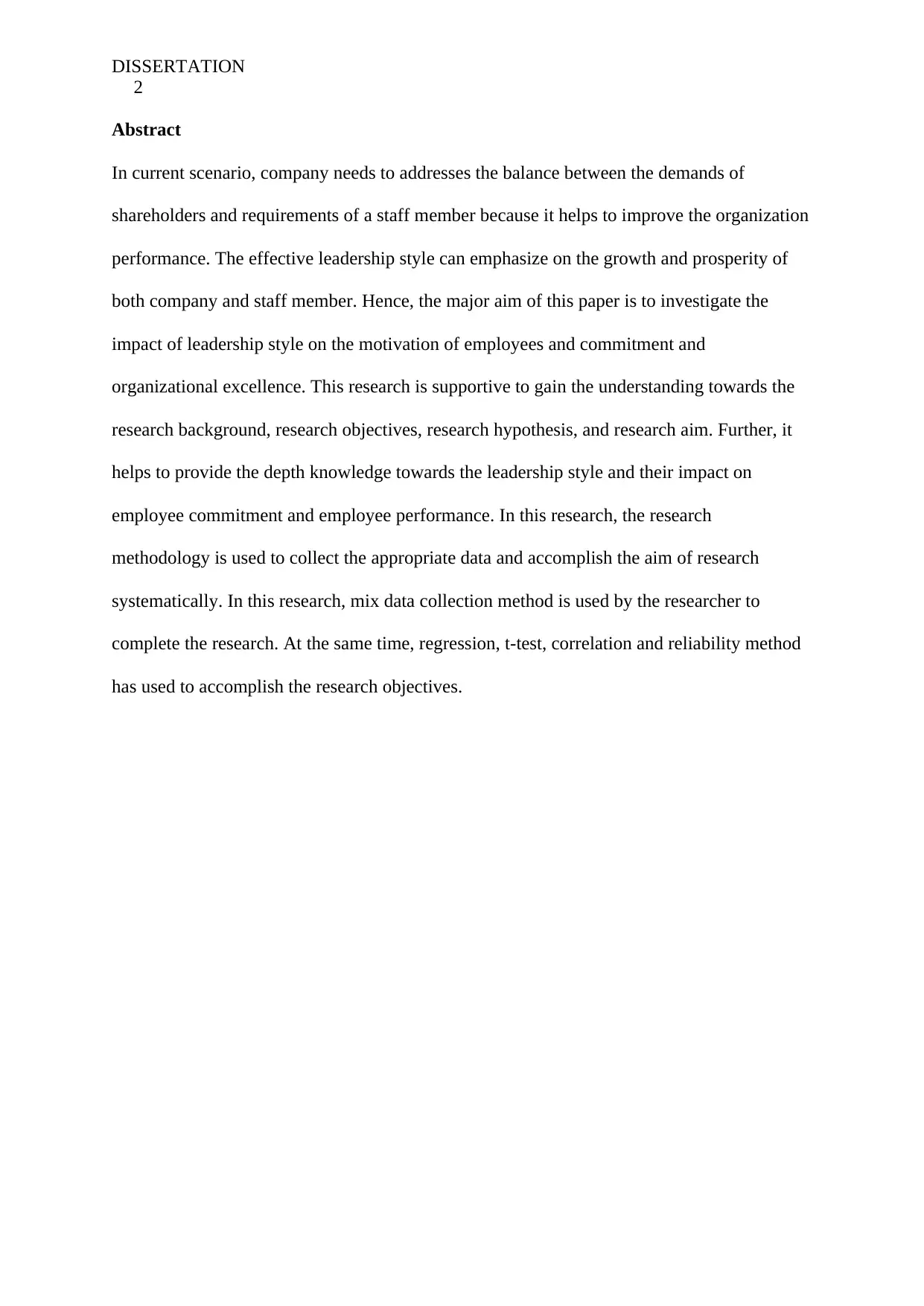
DISSERTATION
2
Abstract
In current scenario, company needs to addresses the balance between the demands of
shareholders and requirements of a staff member because it helps to improve the organization
performance. The effective leadership style can emphasize on the growth and prosperity of
both company and staff member. Hence, the major aim of this paper is to investigate the
impact of leadership style on the motivation of employees and commitment and
organizational excellence. This research is supportive to gain the understanding towards the
research background, research objectives, research hypothesis, and research aim. Further, it
helps to provide the depth knowledge towards the leadership style and their impact on
employee commitment and employee performance. In this research, the research
methodology is used to collect the appropriate data and accomplish the aim of research
systematically. In this research, mix data collection method is used by the researcher to
complete the research. At the same time, regression, t-test, correlation and reliability method
has used to accomplish the research objectives.
2
Abstract
In current scenario, company needs to addresses the balance between the demands of
shareholders and requirements of a staff member because it helps to improve the organization
performance. The effective leadership style can emphasize on the growth and prosperity of
both company and staff member. Hence, the major aim of this paper is to investigate the
impact of leadership style on the motivation of employees and commitment and
organizational excellence. This research is supportive to gain the understanding towards the
research background, research objectives, research hypothesis, and research aim. Further, it
helps to provide the depth knowledge towards the leadership style and their impact on
employee commitment and employee performance. In this research, the research
methodology is used to collect the appropriate data and accomplish the aim of research
systematically. In this research, mix data collection method is used by the researcher to
complete the research. At the same time, regression, t-test, correlation and reliability method
has used to accomplish the research objectives.
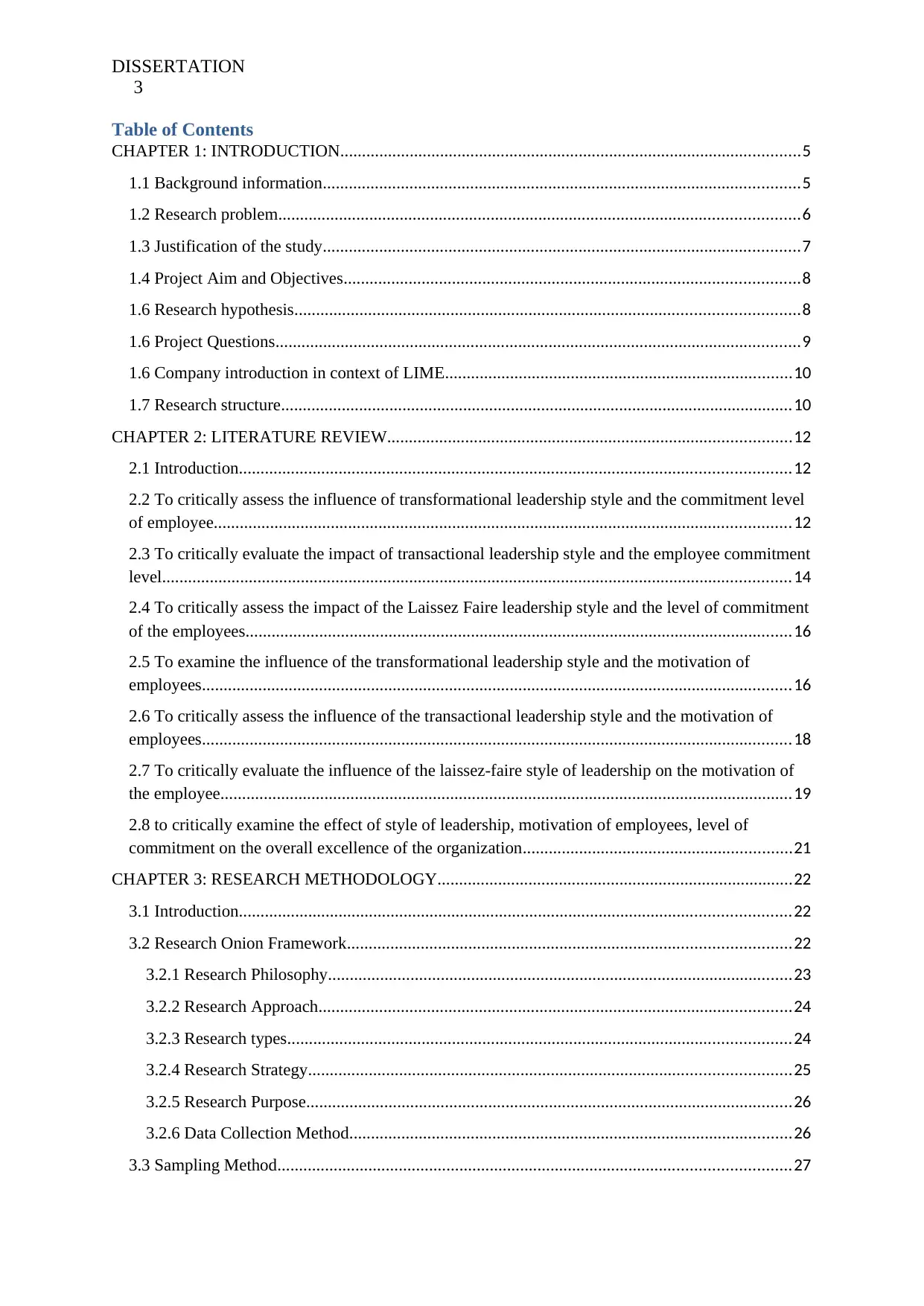
DISSERTATION
3
Table of Contents
CHAPTER 1: INTRODUCTION..........................................................................................................5
1.1 Background information..............................................................................................................5
1.2 Research problem........................................................................................................................6
1.3 Justification of the study..............................................................................................................7
1.4 Project Aim and Objectives.........................................................................................................8
1.6 Research hypothesis....................................................................................................................8
1.6 Project Questions.........................................................................................................................9
1.6 Company introduction in context of LIME................................................................................10
1.7 Research structure......................................................................................................................10
CHAPTER 2: LITERATURE REVIEW.............................................................................................12
2.1 Introduction...............................................................................................................................12
2.2 To critically assess the influence of transformational leadership style and the commitment level
of employee.....................................................................................................................................12
2.3 To critically evaluate the impact of transactional leadership style and the employee commitment
level.................................................................................................................................................14
2.4 To critically assess the impact of the Laissez Faire leadership style and the level of commitment
of the employees..............................................................................................................................16
2.5 To examine the influence of the transformational leadership style and the motivation of
employees........................................................................................................................................16
2.6 To critically assess the influence of the transactional leadership style and the motivation of
employees........................................................................................................................................18
2.7 To critically evaluate the influence of the laissez-faire style of leadership on the motivation of
the employee....................................................................................................................................19
2.8 to critically examine the effect of style of leadership, motivation of employees, level of
commitment on the overall excellence of the organization..............................................................21
CHAPTER 3: RESEARCH METHODOLOGY..................................................................................22
3.1 Introduction...............................................................................................................................22
3.2 Research Onion Framework......................................................................................................22
3.2.1 Research Philosophy...........................................................................................................23
3.2.2 Research Approach.............................................................................................................24
3.2.3 Research types....................................................................................................................24
3.2.4 Research Strategy...............................................................................................................25
3.2.5 Research Purpose................................................................................................................26
3.2.6 Data Collection Method......................................................................................................26
3.3 Sampling Method......................................................................................................................27
3
Table of Contents
CHAPTER 1: INTRODUCTION..........................................................................................................5
1.1 Background information..............................................................................................................5
1.2 Research problem........................................................................................................................6
1.3 Justification of the study..............................................................................................................7
1.4 Project Aim and Objectives.........................................................................................................8
1.6 Research hypothesis....................................................................................................................8
1.6 Project Questions.........................................................................................................................9
1.6 Company introduction in context of LIME................................................................................10
1.7 Research structure......................................................................................................................10
CHAPTER 2: LITERATURE REVIEW.............................................................................................12
2.1 Introduction...............................................................................................................................12
2.2 To critically assess the influence of transformational leadership style and the commitment level
of employee.....................................................................................................................................12
2.3 To critically evaluate the impact of transactional leadership style and the employee commitment
level.................................................................................................................................................14
2.4 To critically assess the impact of the Laissez Faire leadership style and the level of commitment
of the employees..............................................................................................................................16
2.5 To examine the influence of the transformational leadership style and the motivation of
employees........................................................................................................................................16
2.6 To critically assess the influence of the transactional leadership style and the motivation of
employees........................................................................................................................................18
2.7 To critically evaluate the influence of the laissez-faire style of leadership on the motivation of
the employee....................................................................................................................................19
2.8 to critically examine the effect of style of leadership, motivation of employees, level of
commitment on the overall excellence of the organization..............................................................21
CHAPTER 3: RESEARCH METHODOLOGY..................................................................................22
3.1 Introduction...............................................................................................................................22
3.2 Research Onion Framework......................................................................................................22
3.2.1 Research Philosophy...........................................................................................................23
3.2.2 Research Approach.............................................................................................................24
3.2.3 Research types....................................................................................................................24
3.2.4 Research Strategy...............................................................................................................25
3.2.5 Research Purpose................................................................................................................26
3.2.6 Data Collection Method......................................................................................................26
3.3 Sampling Method......................................................................................................................27
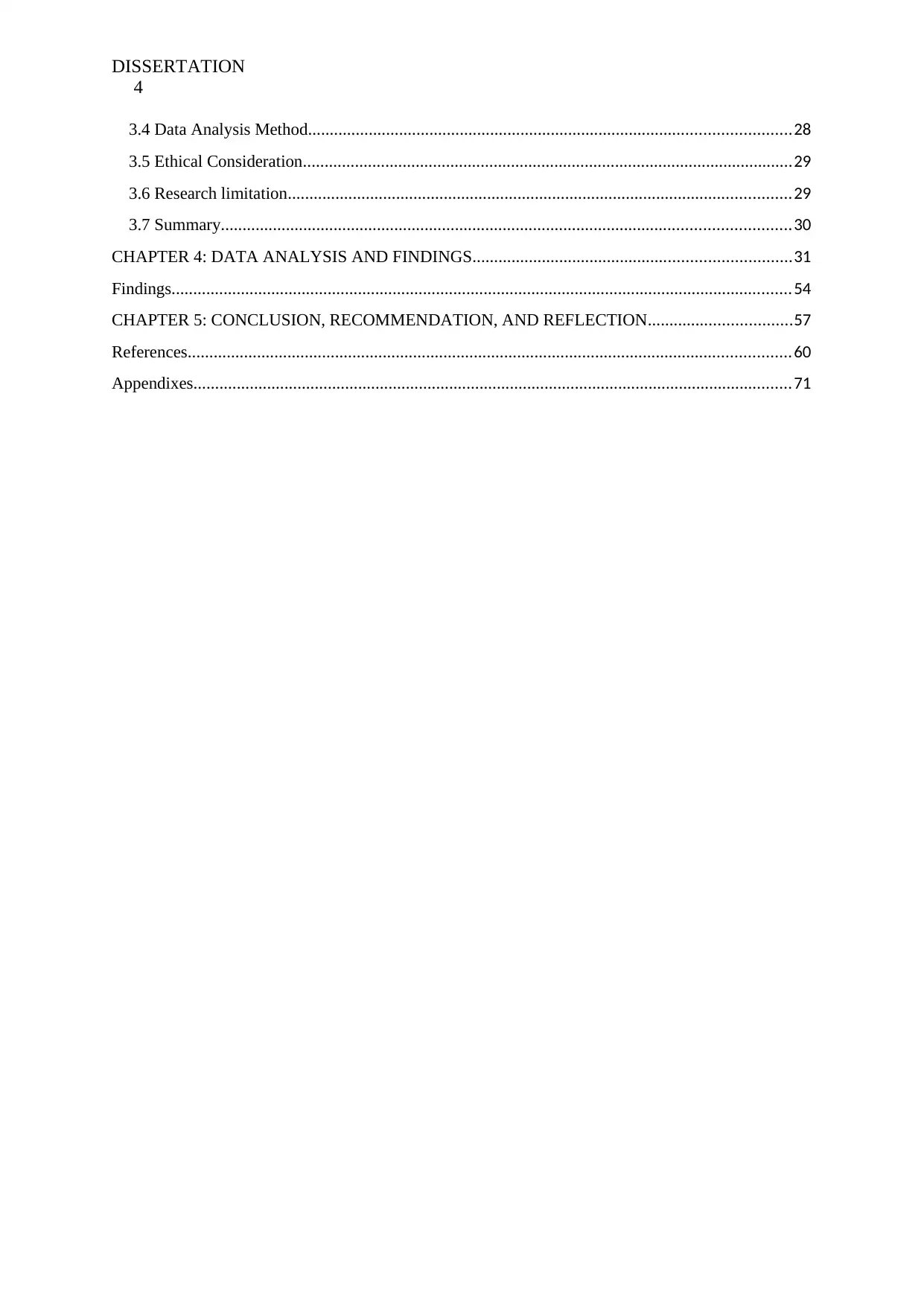
DISSERTATION
4
3.4 Data Analysis Method...............................................................................................................28
3.5 Ethical Consideration.................................................................................................................29
3.6 Research limitation....................................................................................................................29
3.7 Summary...................................................................................................................................30
CHAPTER 4: DATA ANALYSIS AND FINDINGS.........................................................................31
Findings...............................................................................................................................................54
CHAPTER 5: CONCLUSION, RECOMMENDATION, AND REFLECTION.................................57
References...........................................................................................................................................60
Appendixes..........................................................................................................................................71
4
3.4 Data Analysis Method...............................................................................................................28
3.5 Ethical Consideration.................................................................................................................29
3.6 Research limitation....................................................................................................................29
3.7 Summary...................................................................................................................................30
CHAPTER 4: DATA ANALYSIS AND FINDINGS.........................................................................31
Findings...............................................................................................................................................54
CHAPTER 5: CONCLUSION, RECOMMENDATION, AND REFLECTION.................................57
References...........................................................................................................................................60
Appendixes..........................................................................................................................................71
Secure Best Marks with AI Grader
Need help grading? Try our AI Grader for instant feedback on your assignments.
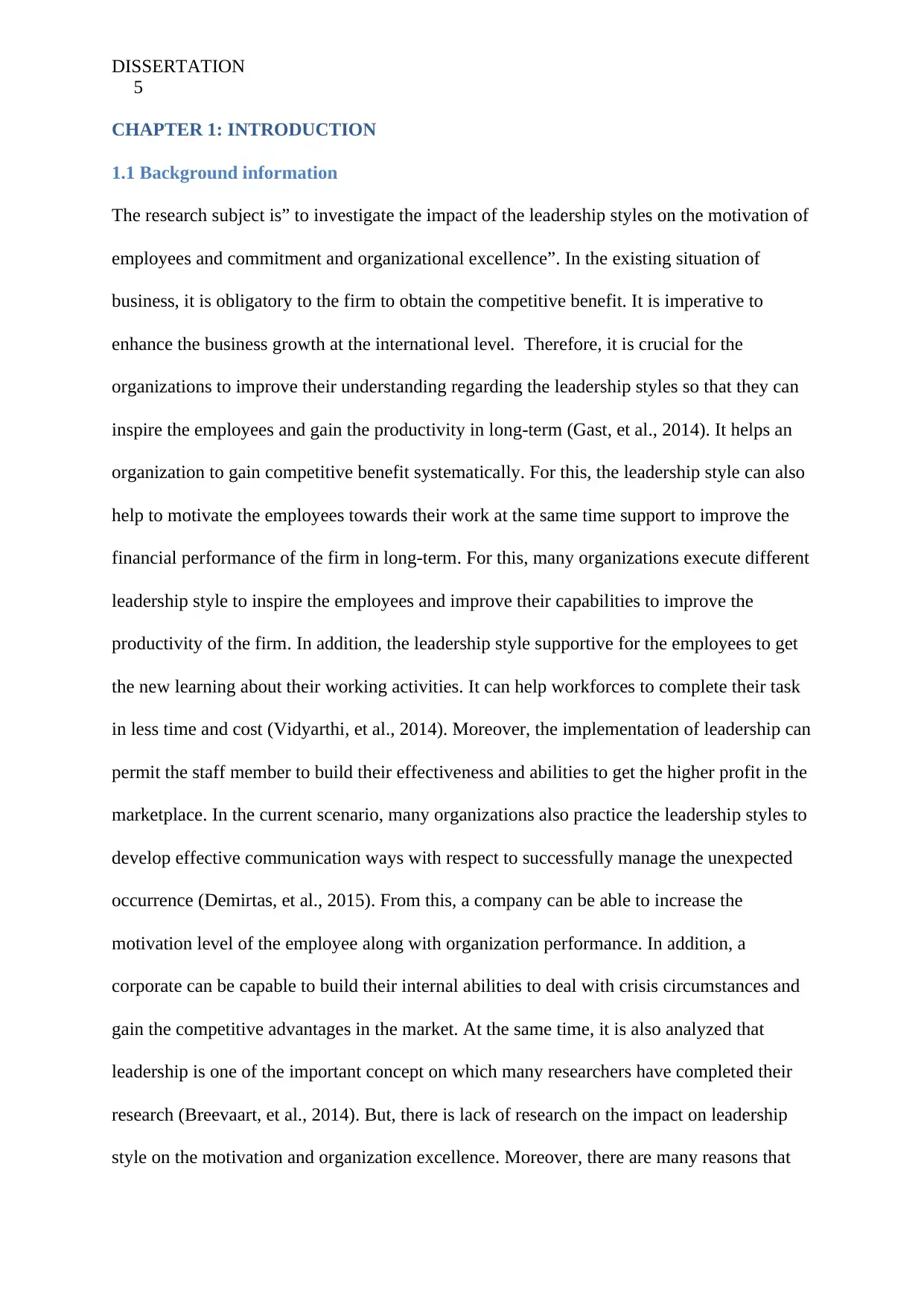
DISSERTATION
5
CHAPTER 1: INTRODUCTION
1.1 Background information
The research subject is” to investigate the impact of the leadership styles on the motivation of
employees and commitment and organizational excellence”. In the existing situation of
business, it is obligatory to the firm to obtain the competitive benefit. It is imperative to
enhance the business growth at the international level. Therefore, it is crucial for the
organizations to improve their understanding regarding the leadership styles so that they can
inspire the employees and gain the productivity in long-term (Gast, et al., 2014). It helps an
organization to gain competitive benefit systematically. For this, the leadership style can also
help to motivate the employees towards their work at the same time support to improve the
financial performance of the firm in long-term. For this, many organizations execute different
leadership style to inspire the employees and improve their capabilities to improve the
productivity of the firm. In addition, the leadership style supportive for the employees to get
the new learning about their working activities. It can help workforces to complete their task
in less time and cost (Vidyarthi, et al., 2014). Moreover, the implementation of leadership can
permit the staff member to build their effectiveness and abilities to get the higher profit in the
marketplace. In the current scenario, many organizations also practice the leadership styles to
develop effective communication ways with respect to successfully manage the unexpected
occurrence (Demirtas, et al., 2015). From this, a company can be able to increase the
motivation level of the employee along with organization performance. In addition, a
corporate can be capable to build their internal abilities to deal with crisis circumstances and
gain the competitive advantages in the market. At the same time, it is also analyzed that
leadership is one of the important concept on which many researchers have completed their
research (Breevaart, et al., 2014). But, there is lack of research on the impact on leadership
style on the motivation and organization excellence. Moreover, there are many reasons that
5
CHAPTER 1: INTRODUCTION
1.1 Background information
The research subject is” to investigate the impact of the leadership styles on the motivation of
employees and commitment and organizational excellence”. In the existing situation of
business, it is obligatory to the firm to obtain the competitive benefit. It is imperative to
enhance the business growth at the international level. Therefore, it is crucial for the
organizations to improve their understanding regarding the leadership styles so that they can
inspire the employees and gain the productivity in long-term (Gast, et al., 2014). It helps an
organization to gain competitive benefit systematically. For this, the leadership style can also
help to motivate the employees towards their work at the same time support to improve the
financial performance of the firm in long-term. For this, many organizations execute different
leadership style to inspire the employees and improve their capabilities to improve the
productivity of the firm. In addition, the leadership style supportive for the employees to get
the new learning about their working activities. It can help workforces to complete their task
in less time and cost (Vidyarthi, et al., 2014). Moreover, the implementation of leadership can
permit the staff member to build their effectiveness and abilities to get the higher profit in the
marketplace. In the current scenario, many organizations also practice the leadership styles to
develop effective communication ways with respect to successfully manage the unexpected
occurrence (Demirtas, et al., 2015). From this, a company can be able to increase the
motivation level of the employee along with organization performance. In addition, a
corporate can be capable to build their internal abilities to deal with crisis circumstances and
gain the competitive advantages in the market. At the same time, it is also analyzed that
leadership is one of the important concept on which many researchers have completed their
research (Breevaart, et al., 2014). But, there is lack of research on the impact on leadership
style on the motivation and organization excellence. Moreover, there are many reasons that
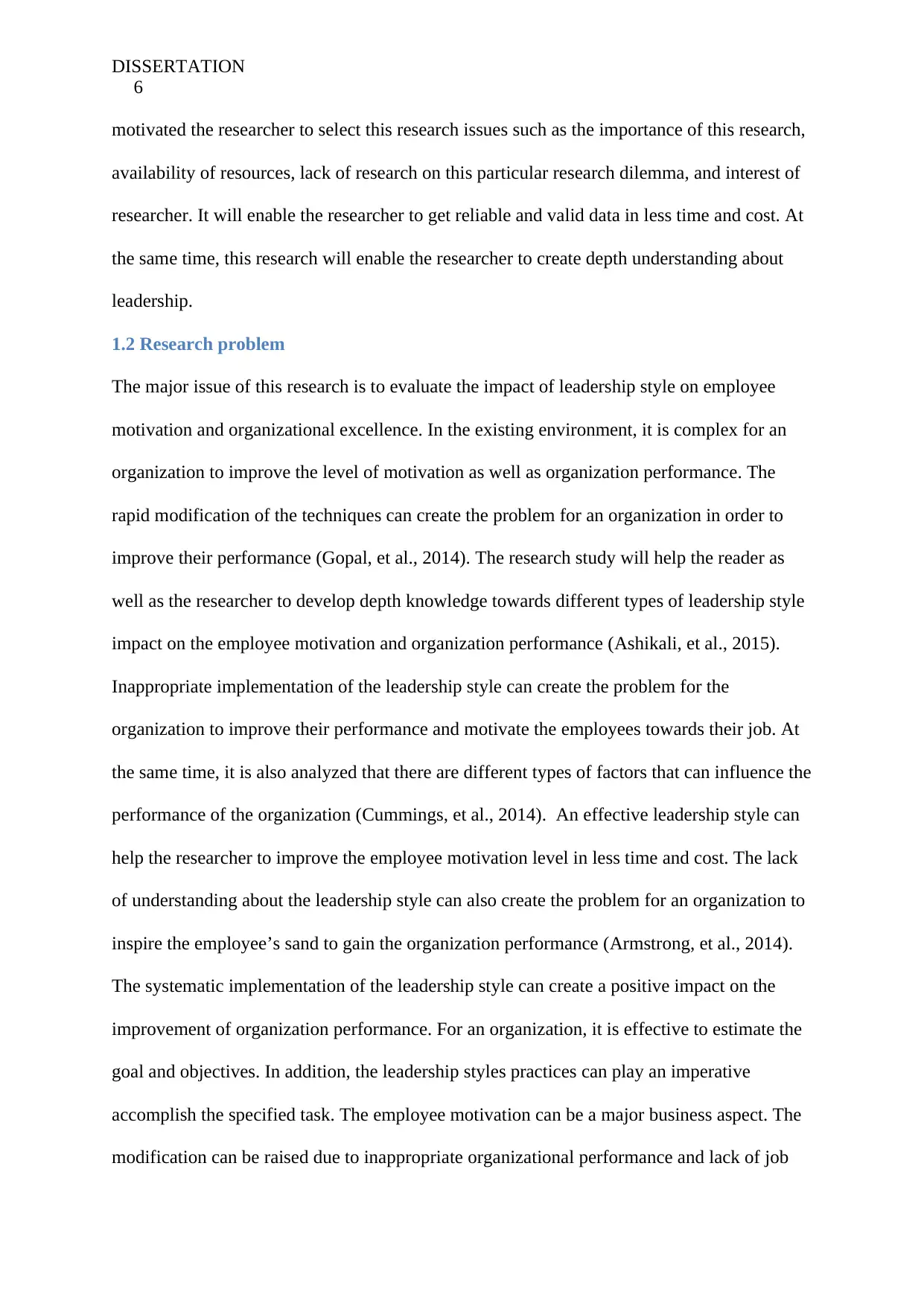
DISSERTATION
6
motivated the researcher to select this research issues such as the importance of this research,
availability of resources, lack of research on this particular research dilemma, and interest of
researcher. It will enable the researcher to get reliable and valid data in less time and cost. At
the same time, this research will enable the researcher to create depth understanding about
leadership.
1.2 Research problem
The major issue of this research is to evaluate the impact of leadership style on employee
motivation and organizational excellence. In the existing environment, it is complex for an
organization to improve the level of motivation as well as organization performance. The
rapid modification of the techniques can create the problem for an organization in order to
improve their performance (Gopal, et al., 2014). The research study will help the reader as
well as the researcher to develop depth knowledge towards different types of leadership style
impact on the employee motivation and organization performance (Ashikali, et al., 2015).
Inappropriate implementation of the leadership style can create the problem for the
organization to improve their performance and motivate the employees towards their job. At
the same time, it is also analyzed that there are different types of factors that can influence the
performance of the organization (Cummings, et al., 2014). An effective leadership style can
help the researcher to improve the employee motivation level in less time and cost. The lack
of understanding about the leadership style can also create the problem for an organization to
inspire the employee’s sand to gain the organization performance (Armstrong, et al., 2014).
The systematic implementation of the leadership style can create a positive impact on the
improvement of organization performance. For an organization, it is effective to estimate the
goal and objectives. In addition, the leadership styles practices can play an imperative
accomplish the specified task. The employee motivation can be a major business aspect. The
modification can be raised due to inappropriate organizational performance and lack of job
6
motivated the researcher to select this research issues such as the importance of this research,
availability of resources, lack of research on this particular research dilemma, and interest of
researcher. It will enable the researcher to get reliable and valid data in less time and cost. At
the same time, this research will enable the researcher to create depth understanding about
leadership.
1.2 Research problem
The major issue of this research is to evaluate the impact of leadership style on employee
motivation and organizational excellence. In the existing environment, it is complex for an
organization to improve the level of motivation as well as organization performance. The
rapid modification of the techniques can create the problem for an organization in order to
improve their performance (Gopal, et al., 2014). The research study will help the reader as
well as the researcher to develop depth knowledge towards different types of leadership style
impact on the employee motivation and organization performance (Ashikali, et al., 2015).
Inappropriate implementation of the leadership style can create the problem for the
organization to improve their performance and motivate the employees towards their job. At
the same time, it is also analyzed that there are different types of factors that can influence the
performance of the organization (Cummings, et al., 2014). An effective leadership style can
help the researcher to improve the employee motivation level in less time and cost. The lack
of understanding about the leadership style can also create the problem for an organization to
inspire the employee’s sand to gain the organization performance (Armstrong, et al., 2014).
The systematic implementation of the leadership style can create a positive impact on the
improvement of organization performance. For an organization, it is effective to estimate the
goal and objectives. In addition, the leadership styles practices can play an imperative
accomplish the specified task. The employee motivation can be a major business aspect. The
modification can be raised due to inappropriate organizational performance and lack of job
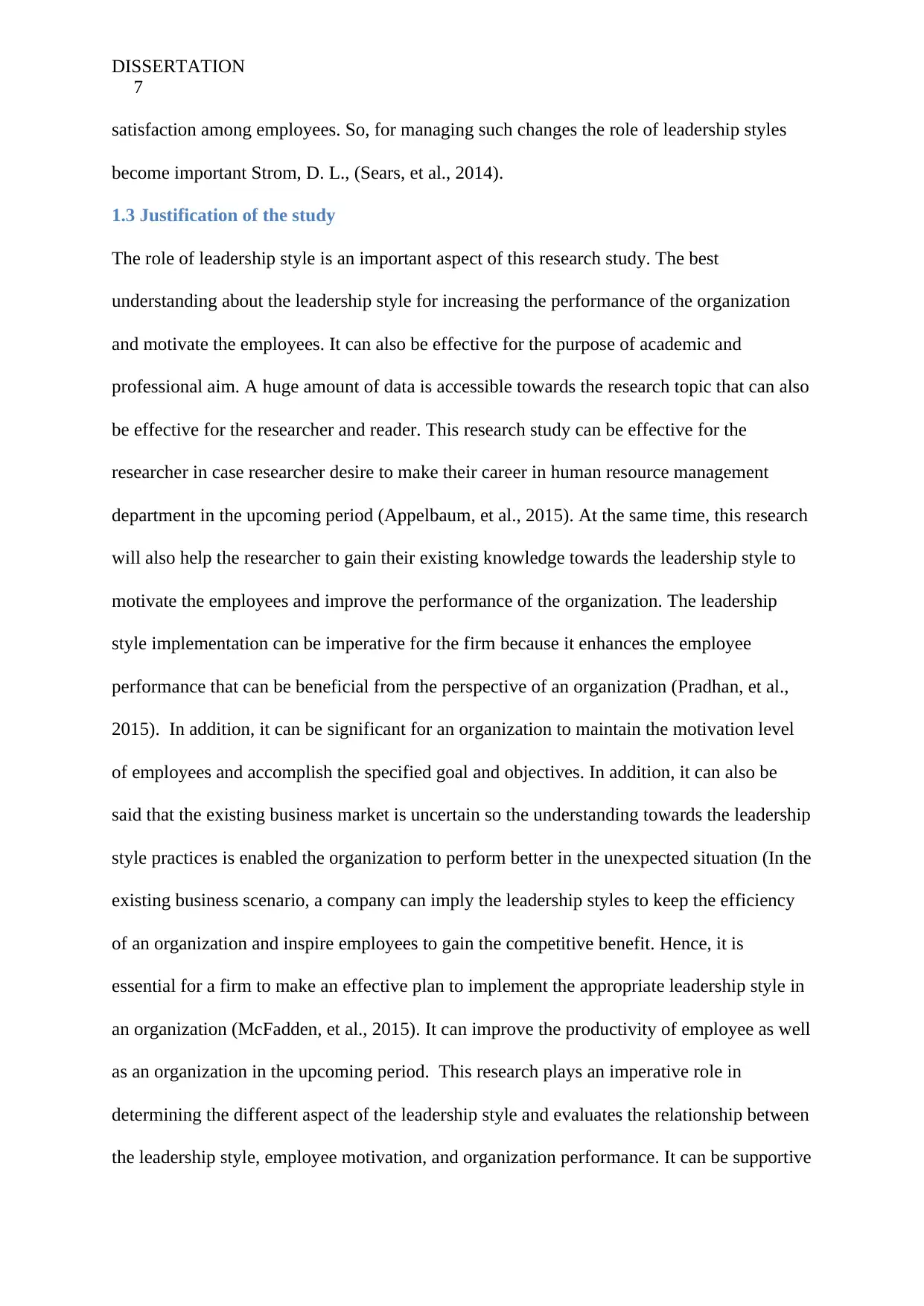
DISSERTATION
7
satisfaction among employees. So, for managing such changes the role of leadership styles
become important Strom, D. L., (Sears, et al., 2014).
1.3 Justification of the study
The role of leadership style is an important aspect of this research study. The best
understanding about the leadership style for increasing the performance of the organization
and motivate the employees. It can also be effective for the purpose of academic and
professional aim. A huge amount of data is accessible towards the research topic that can also
be effective for the researcher and reader. This research study can be effective for the
researcher in case researcher desire to make their career in human resource management
department in the upcoming period (Appelbaum, et al., 2015). At the same time, this research
will also help the researcher to gain their existing knowledge towards the leadership style to
motivate the employees and improve the performance of the organization. The leadership
style implementation can be imperative for the firm because it enhances the employee
performance that can be beneficial from the perspective of an organization (Pradhan, et al.,
2015). In addition, it can be significant for an organization to maintain the motivation level
of employees and accomplish the specified goal and objectives. In addition, it can also be
said that the existing business market is uncertain so the understanding towards the leadership
style practices is enabled the organization to perform better in the unexpected situation (In the
existing business scenario, a company can imply the leadership styles to keep the efficiency
of an organization and inspire employees to gain the competitive benefit. Hence, it is
essential for a firm to make an effective plan to implement the appropriate leadership style in
an organization (McFadden, et al., 2015). It can improve the productivity of employee as well
as an organization in the upcoming period. This research plays an imperative role in
determining the different aspect of the leadership style and evaluates the relationship between
the leadership style, employee motivation, and organization performance. It can be supportive
7
satisfaction among employees. So, for managing such changes the role of leadership styles
become important Strom, D. L., (Sears, et al., 2014).
1.3 Justification of the study
The role of leadership style is an important aspect of this research study. The best
understanding about the leadership style for increasing the performance of the organization
and motivate the employees. It can also be effective for the purpose of academic and
professional aim. A huge amount of data is accessible towards the research topic that can also
be effective for the researcher and reader. This research study can be effective for the
researcher in case researcher desire to make their career in human resource management
department in the upcoming period (Appelbaum, et al., 2015). At the same time, this research
will also help the researcher to gain their existing knowledge towards the leadership style to
motivate the employees and improve the performance of the organization. The leadership
style implementation can be imperative for the firm because it enhances the employee
performance that can be beneficial from the perspective of an organization (Pradhan, et al.,
2015). In addition, it can be significant for an organization to maintain the motivation level
of employees and accomplish the specified goal and objectives. In addition, it can also be
said that the existing business market is uncertain so the understanding towards the leadership
style practices is enabled the organization to perform better in the unexpected situation (In the
existing business scenario, a company can imply the leadership styles to keep the efficiency
of an organization and inspire employees to gain the competitive benefit. Hence, it is
essential for a firm to make an effective plan to implement the appropriate leadership style in
an organization (McFadden, et al., 2015). It can improve the productivity of employee as well
as an organization in the upcoming period. This research plays an imperative role in
determining the different aspect of the leadership style and evaluates the relationship between
the leadership style, employee motivation, and organization performance. It can be supportive
Paraphrase This Document
Need a fresh take? Get an instant paraphrase of this document with our AI Paraphraser
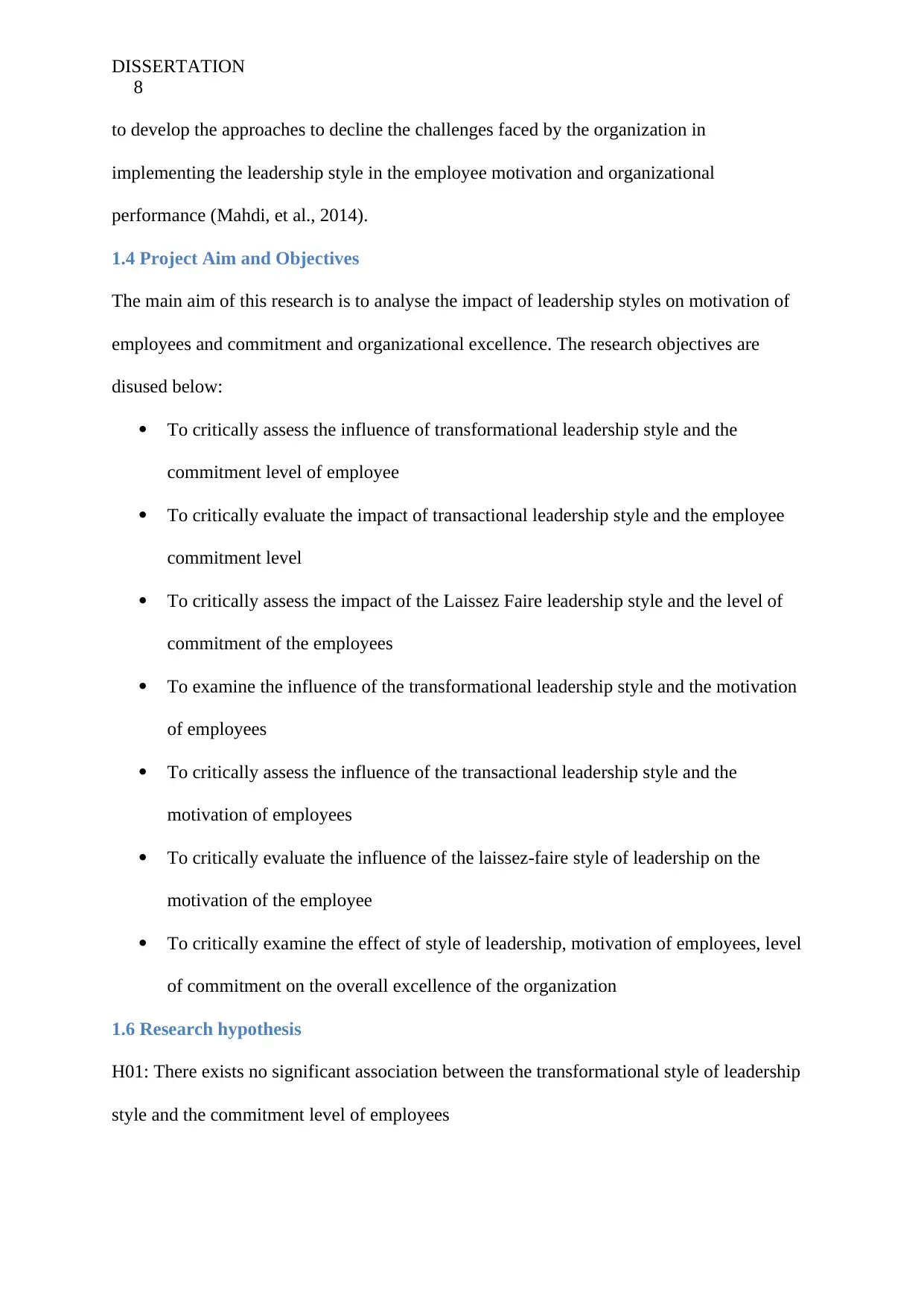
DISSERTATION
8
to develop the approaches to decline the challenges faced by the organization in
implementing the leadership style in the employee motivation and organizational
performance (Mahdi, et al., 2014).
1.4 Project Aim and Objectives
The main aim of this research is to analyse the impact of leadership styles on motivation of
employees and commitment and organizational excellence. The research objectives are
disused below:
To critically assess the influence of transformational leadership style and the
commitment level of employee
To critically evaluate the impact of transactional leadership style and the employee
commitment level
To critically assess the impact of the Laissez Faire leadership style and the level of
commitment of the employees
To examine the influence of the transformational leadership style and the motivation
of employees
To critically assess the influence of the transactional leadership style and the
motivation of employees
To critically evaluate the influence of the laissez-faire style of leadership on the
motivation of the employee
To critically examine the effect of style of leadership, motivation of employees, level
of commitment on the overall excellence of the organization
1.6 Research hypothesis
H01: There exists no significant association between the transformational style of leadership
style and the commitment level of employees
8
to develop the approaches to decline the challenges faced by the organization in
implementing the leadership style in the employee motivation and organizational
performance (Mahdi, et al., 2014).
1.4 Project Aim and Objectives
The main aim of this research is to analyse the impact of leadership styles on motivation of
employees and commitment and organizational excellence. The research objectives are
disused below:
To critically assess the influence of transformational leadership style and the
commitment level of employee
To critically evaluate the impact of transactional leadership style and the employee
commitment level
To critically assess the impact of the Laissez Faire leadership style and the level of
commitment of the employees
To examine the influence of the transformational leadership style and the motivation
of employees
To critically assess the influence of the transactional leadership style and the
motivation of employees
To critically evaluate the influence of the laissez-faire style of leadership on the
motivation of the employee
To critically examine the effect of style of leadership, motivation of employees, level
of commitment on the overall excellence of the organization
1.6 Research hypothesis
H01: There exists no significant association between the transformational style of leadership
style and the commitment level of employees
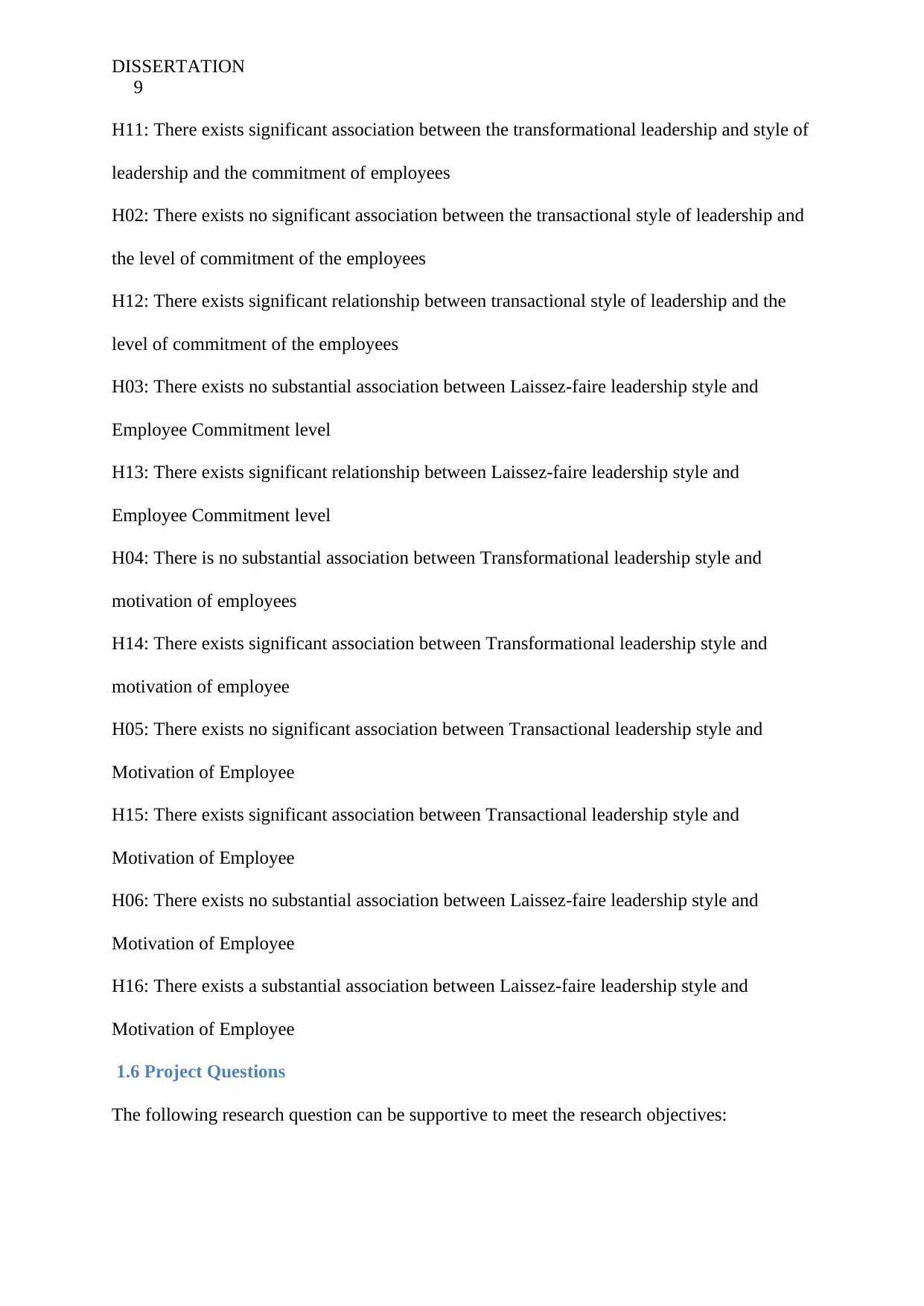
DISSERTATION
9
H11: There exists significant association between the transformational leadership and style of
leadership and the commitment of employees
H02: There exists no significant association between the transactional style of leadership and
the level of commitment of the employees
H12: There exists significant relationship between transactional style of leadership and the
level of commitment of the employees
H03: There exists no substantial association between Laissez-faire leadership style and
Employee Commitment level
H13: There exists significant relationship between Laissez-faire leadership style and
Employee Commitment level
H04: There is no substantial association between Transformational leadership style and
motivation of employees
H14: There exists significant association between Transformational leadership style and
motivation of employee
H05: There exists no significant association between Transactional leadership style and
Motivation of Employee
H15: There exists significant association between Transactional leadership style and
Motivation of Employee
H06: There exists no substantial association between Laissez-faire leadership style and
Motivation of Employee
H16: There exists a substantial association between Laissez-faire leadership style and
Motivation of Employee
1.6 Project Questions
The following research question can be supportive to meet the research objectives:
9
H11: There exists significant association between the transformational leadership and style of
leadership and the commitment of employees
H02: There exists no significant association between the transactional style of leadership and
the level of commitment of the employees
H12: There exists significant relationship between transactional style of leadership and the
level of commitment of the employees
H03: There exists no substantial association between Laissez-faire leadership style and
Employee Commitment level
H13: There exists significant relationship between Laissez-faire leadership style and
Employee Commitment level
H04: There is no substantial association between Transformational leadership style and
motivation of employees
H14: There exists significant association between Transformational leadership style and
motivation of employee
H05: There exists no significant association between Transactional leadership style and
Motivation of Employee
H15: There exists significant association between Transactional leadership style and
Motivation of Employee
H06: There exists no substantial association between Laissez-faire leadership style and
Motivation of Employee
H16: There exists a substantial association between Laissez-faire leadership style and
Motivation of Employee
1.6 Project Questions
The following research question can be supportive to meet the research objectives:
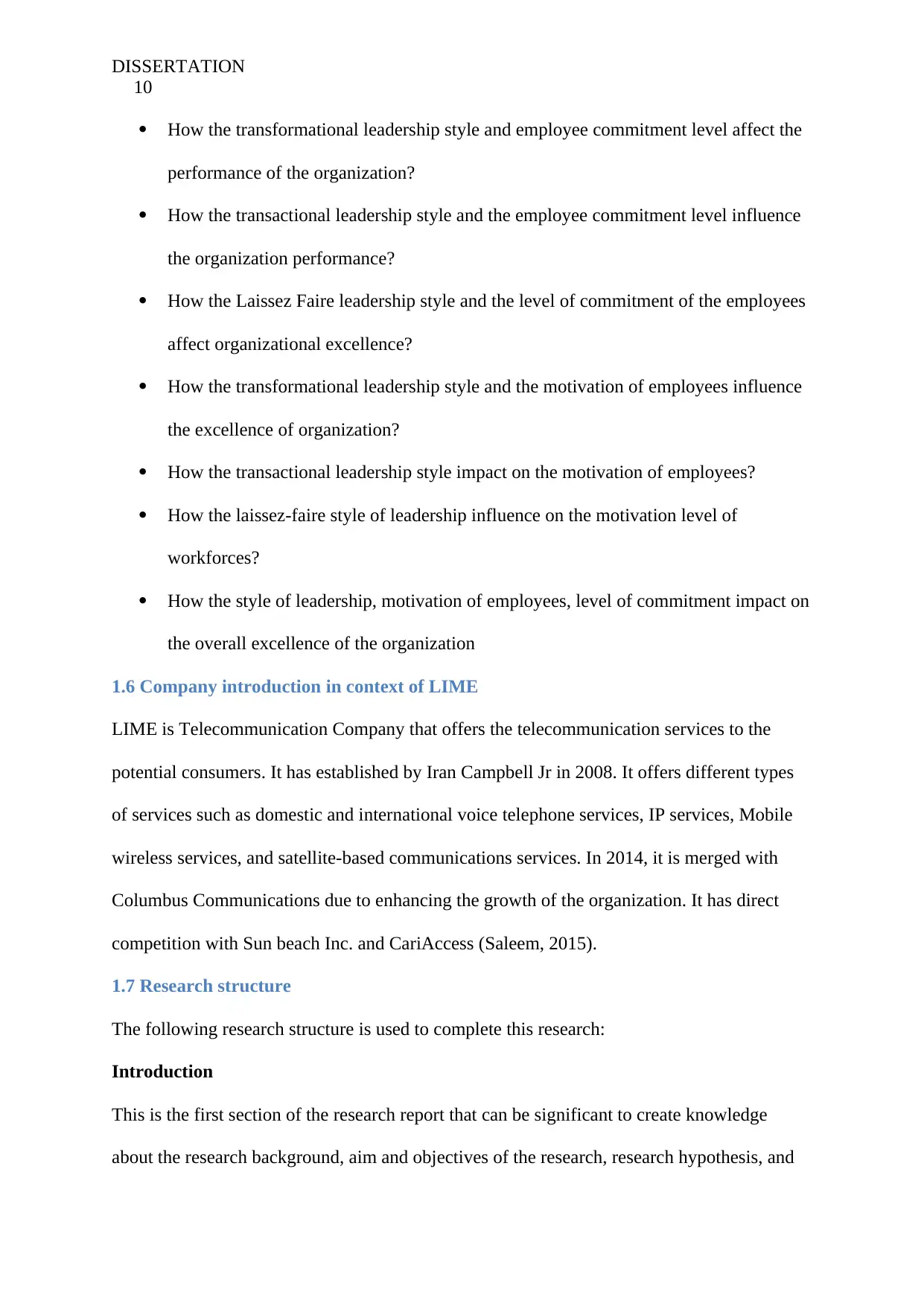
DISSERTATION
10
How the transformational leadership style and employee commitment level affect the
performance of the organization?
How the transactional leadership style and the employee commitment level influence
the organization performance?
How the Laissez Faire leadership style and the level of commitment of the employees
affect organizational excellence?
How the transformational leadership style and the motivation of employees influence
the excellence of organization?
How the transactional leadership style impact on the motivation of employees?
How the laissez-faire style of leadership influence on the motivation level of
workforces?
How the style of leadership, motivation of employees, level of commitment impact on
the overall excellence of the organization
1.6 Company introduction in context of LIME
LIME is Telecommunication Company that offers the telecommunication services to the
potential consumers. It has established by Iran Campbell Jr in 2008. It offers different types
of services such as domestic and international voice telephone services, IP services, Mobile
wireless services, and satellite-based communications services. In 2014, it is merged with
Columbus Communications due to enhancing the growth of the organization. It has direct
competition with Sun beach Inc. and CariAccess (Saleem, 2015).
1.7 Research structure
The following research structure is used to complete this research:
Introduction
This is the first section of the research report that can be significant to create knowledge
about the research background, aim and objectives of the research, research hypothesis, and
10
How the transformational leadership style and employee commitment level affect the
performance of the organization?
How the transactional leadership style and the employee commitment level influence
the organization performance?
How the Laissez Faire leadership style and the level of commitment of the employees
affect organizational excellence?
How the transformational leadership style and the motivation of employees influence
the excellence of organization?
How the transactional leadership style impact on the motivation of employees?
How the laissez-faire style of leadership influence on the motivation level of
workforces?
How the style of leadership, motivation of employees, level of commitment impact on
the overall excellence of the organization
1.6 Company introduction in context of LIME
LIME is Telecommunication Company that offers the telecommunication services to the
potential consumers. It has established by Iran Campbell Jr in 2008. It offers different types
of services such as domestic and international voice telephone services, IP services, Mobile
wireless services, and satellite-based communications services. In 2014, it is merged with
Columbus Communications due to enhancing the growth of the organization. It has direct
competition with Sun beach Inc. and CariAccess (Saleem, 2015).
1.7 Research structure
The following research structure is used to complete this research:
Introduction
This is the first section of the research report that can be significant to create knowledge
about the research background, aim and objectives of the research, research hypothesis, and
Secure Best Marks with AI Grader
Need help grading? Try our AI Grader for instant feedback on your assignments.
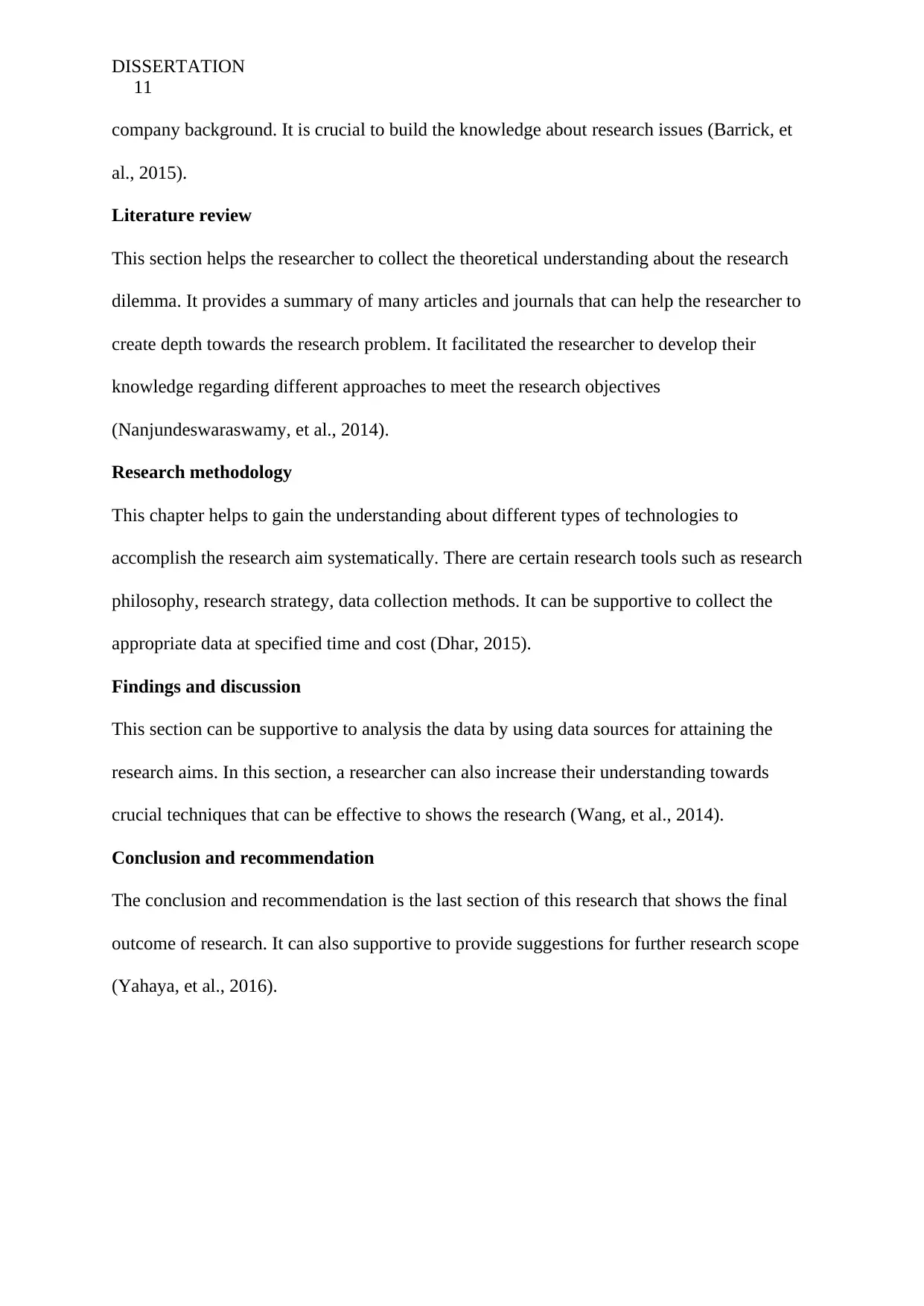
DISSERTATION
11
company background. It is crucial to build the knowledge about research issues (Barrick, et
al., 2015).
Literature review
This section helps the researcher to collect the theoretical understanding about the research
dilemma. It provides a summary of many articles and journals that can help the researcher to
create depth towards the research problem. It facilitated the researcher to develop their
knowledge regarding different approaches to meet the research objectives
(Nanjundeswaraswamy, et al., 2014).
Research methodology
This chapter helps to gain the understanding about different types of technologies to
accomplish the research aim systematically. There are certain research tools such as research
philosophy, research strategy, data collection methods. It can be supportive to collect the
appropriate data at specified time and cost (Dhar, 2015).
Findings and discussion
This section can be supportive to analysis the data by using data sources for attaining the
research aims. In this section, a researcher can also increase their understanding towards
crucial techniques that can be effective to shows the research (Wang, et al., 2014).
Conclusion and recommendation
The conclusion and recommendation is the last section of this research that shows the final
outcome of research. It can also supportive to provide suggestions for further research scope
(Yahaya, et al., 2016).
11
company background. It is crucial to build the knowledge about research issues (Barrick, et
al., 2015).
Literature review
This section helps the researcher to collect the theoretical understanding about the research
dilemma. It provides a summary of many articles and journals that can help the researcher to
create depth towards the research problem. It facilitated the researcher to develop their
knowledge regarding different approaches to meet the research objectives
(Nanjundeswaraswamy, et al., 2014).
Research methodology
This chapter helps to gain the understanding about different types of technologies to
accomplish the research aim systematically. There are certain research tools such as research
philosophy, research strategy, data collection methods. It can be supportive to collect the
appropriate data at specified time and cost (Dhar, 2015).
Findings and discussion
This section can be supportive to analysis the data by using data sources for attaining the
research aims. In this section, a researcher can also increase their understanding towards
crucial techniques that can be effective to shows the research (Wang, et al., 2014).
Conclusion and recommendation
The conclusion and recommendation is the last section of this research that shows the final
outcome of research. It can also supportive to provide suggestions for further research scope
(Yahaya, et al., 2016).
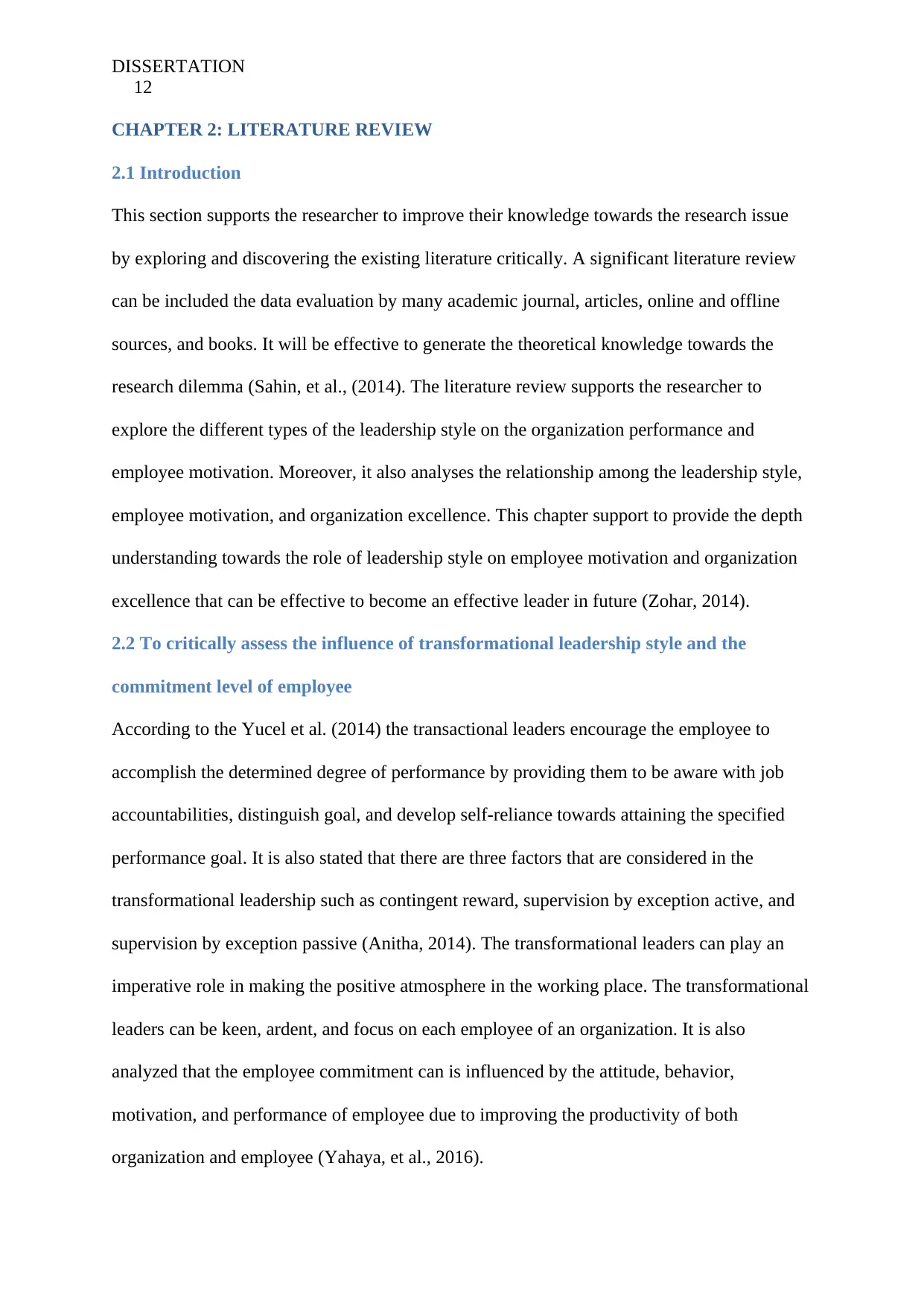
DISSERTATION
12
CHAPTER 2: LITERATURE REVIEW
2.1 Introduction
This section supports the researcher to improve their knowledge towards the research issue
by exploring and discovering the existing literature critically. A significant literature review
can be included the data evaluation by many academic journal, articles, online and offline
sources, and books. It will be effective to generate the theoretical knowledge towards the
research dilemma (Sahin, et al., (2014). The literature review supports the researcher to
explore the different types of the leadership style on the organization performance and
employee motivation. Moreover, it also analyses the relationship among the leadership style,
employee motivation, and organization excellence. This chapter support to provide the depth
understanding towards the role of leadership style on employee motivation and organization
excellence that can be effective to become an effective leader in future (Zohar, 2014).
2.2 To critically assess the influence of transformational leadership style and the
commitment level of employee
According to the Yucel et al. (2014) the transactional leaders encourage the employee to
accomplish the determined degree of performance by providing them to be aware with job
accountabilities, distinguish goal, and develop self-reliance towards attaining the specified
performance goal. It is also stated that there are three factors that are considered in the
transformational leadership such as contingent reward, supervision by exception active, and
supervision by exception passive (Anitha, 2014). The transformational leaders can play an
imperative role in making the positive atmosphere in the working place. The transformational
leaders can be keen, ardent, and focus on each employee of an organization. It is also
analyzed that the employee commitment can is influenced by the attitude, behavior,
motivation, and performance of employee due to improving the productivity of both
organization and employee (Yahaya, et al., 2016).
12
CHAPTER 2: LITERATURE REVIEW
2.1 Introduction
This section supports the researcher to improve their knowledge towards the research issue
by exploring and discovering the existing literature critically. A significant literature review
can be included the data evaluation by many academic journal, articles, online and offline
sources, and books. It will be effective to generate the theoretical knowledge towards the
research dilemma (Sahin, et al., (2014). The literature review supports the researcher to
explore the different types of the leadership style on the organization performance and
employee motivation. Moreover, it also analyses the relationship among the leadership style,
employee motivation, and organization excellence. This chapter support to provide the depth
understanding towards the role of leadership style on employee motivation and organization
excellence that can be effective to become an effective leader in future (Zohar, 2014).
2.2 To critically assess the influence of transformational leadership style and the
commitment level of employee
According to the Yucel et al. (2014) the transactional leaders encourage the employee to
accomplish the determined degree of performance by providing them to be aware with job
accountabilities, distinguish goal, and develop self-reliance towards attaining the specified
performance goal. It is also stated that there are three factors that are considered in the
transformational leadership such as contingent reward, supervision by exception active, and
supervision by exception passive (Anitha, 2014). The transformational leaders can play an
imperative role in making the positive atmosphere in the working place. The transformational
leaders can be keen, ardent, and focus on each employee of an organization. It is also
analyzed that the employee commitment can is influenced by the attitude, behavior,
motivation, and performance of employee due to improving the productivity of both
organization and employee (Yahaya, et al., 2016).
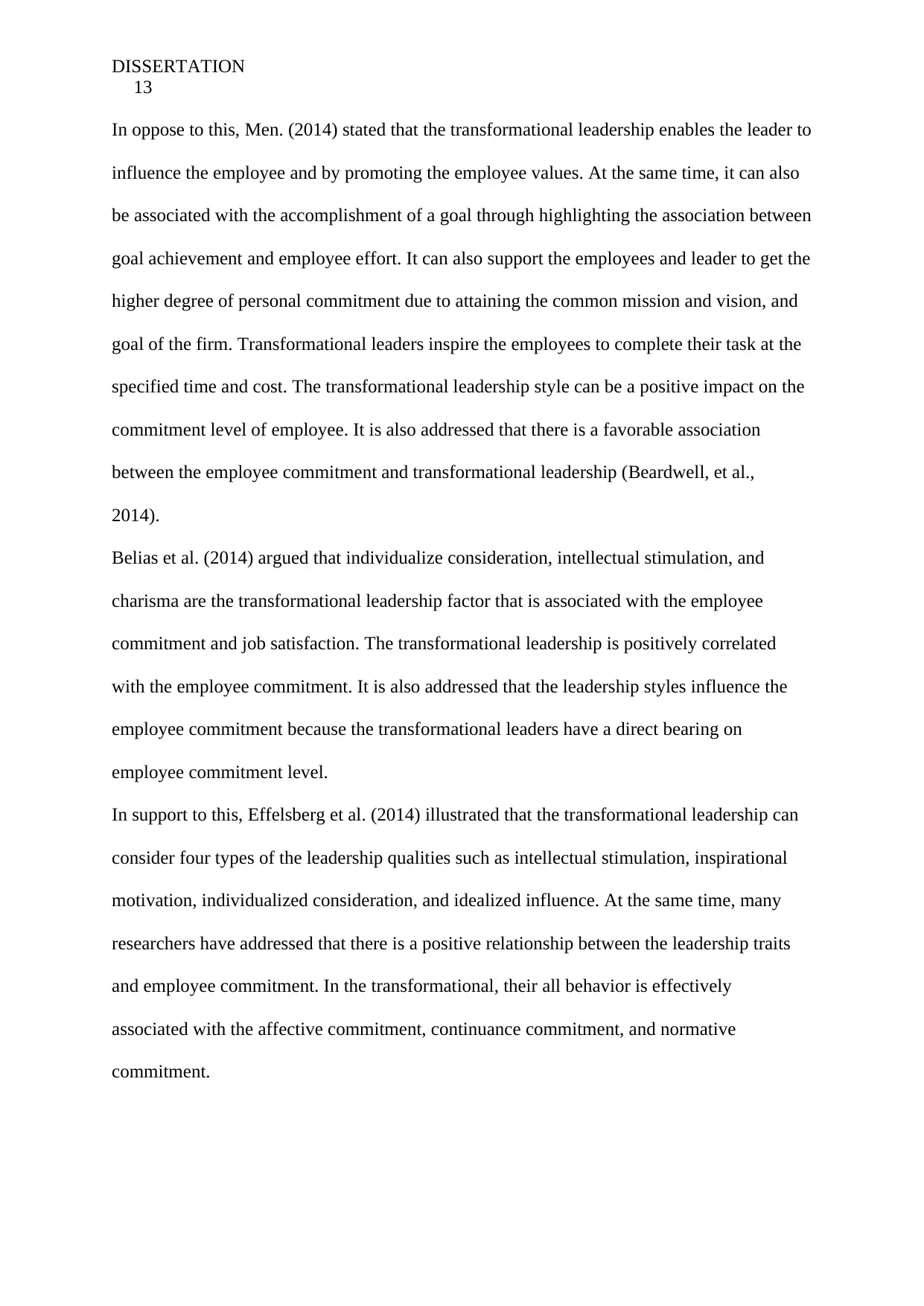
DISSERTATION
13
In oppose to this, Men. (2014) stated that the transformational leadership enables the leader to
influence the employee and by promoting the employee values. At the same time, it can also
be associated with the accomplishment of a goal through highlighting the association between
goal achievement and employee effort. It can also support the employees and leader to get the
higher degree of personal commitment due to attaining the common mission and vision, and
goal of the firm. Transformational leaders inspire the employees to complete their task at the
specified time and cost. The transformational leadership style can be a positive impact on the
commitment level of employee. It is also addressed that there is a favorable association
between the employee commitment and transformational leadership (Beardwell, et al.,
2014).
Belias et al. (2014) argued that individualize consideration, intellectual stimulation, and
charisma are the transformational leadership factor that is associated with the employee
commitment and job satisfaction. The transformational leadership is positively correlated
with the employee commitment. It is also addressed that the leadership styles influence the
employee commitment because the transformational leaders have a direct bearing on
employee commitment level.
In support to this, Effelsberg et al. (2014) illustrated that the transformational leadership can
consider four types of the leadership qualities such as intellectual stimulation, inspirational
motivation, individualized consideration, and idealized influence. At the same time, many
researchers have addressed that there is a positive relationship between the leadership traits
and employee commitment. In the transformational, their all behavior is effectively
associated with the affective commitment, continuance commitment, and normative
commitment.
13
In oppose to this, Men. (2014) stated that the transformational leadership enables the leader to
influence the employee and by promoting the employee values. At the same time, it can also
be associated with the accomplishment of a goal through highlighting the association between
goal achievement and employee effort. It can also support the employees and leader to get the
higher degree of personal commitment due to attaining the common mission and vision, and
goal of the firm. Transformational leaders inspire the employees to complete their task at the
specified time and cost. The transformational leadership style can be a positive impact on the
commitment level of employee. It is also addressed that there is a favorable association
between the employee commitment and transformational leadership (Beardwell, et al.,
2014).
Belias et al. (2014) argued that individualize consideration, intellectual stimulation, and
charisma are the transformational leadership factor that is associated with the employee
commitment and job satisfaction. The transformational leadership is positively correlated
with the employee commitment. It is also addressed that the leadership styles influence the
employee commitment because the transformational leaders have a direct bearing on
employee commitment level.
In support to this, Effelsberg et al. (2014) illustrated that the transformational leadership can
consider four types of the leadership qualities such as intellectual stimulation, inspirational
motivation, individualized consideration, and idealized influence. At the same time, many
researchers have addressed that there is a positive relationship between the leadership traits
and employee commitment. In the transformational, their all behavior is effectively
associated with the affective commitment, continuance commitment, and normative
commitment.
Paraphrase This Document
Need a fresh take? Get an instant paraphrase of this document with our AI Paraphraser
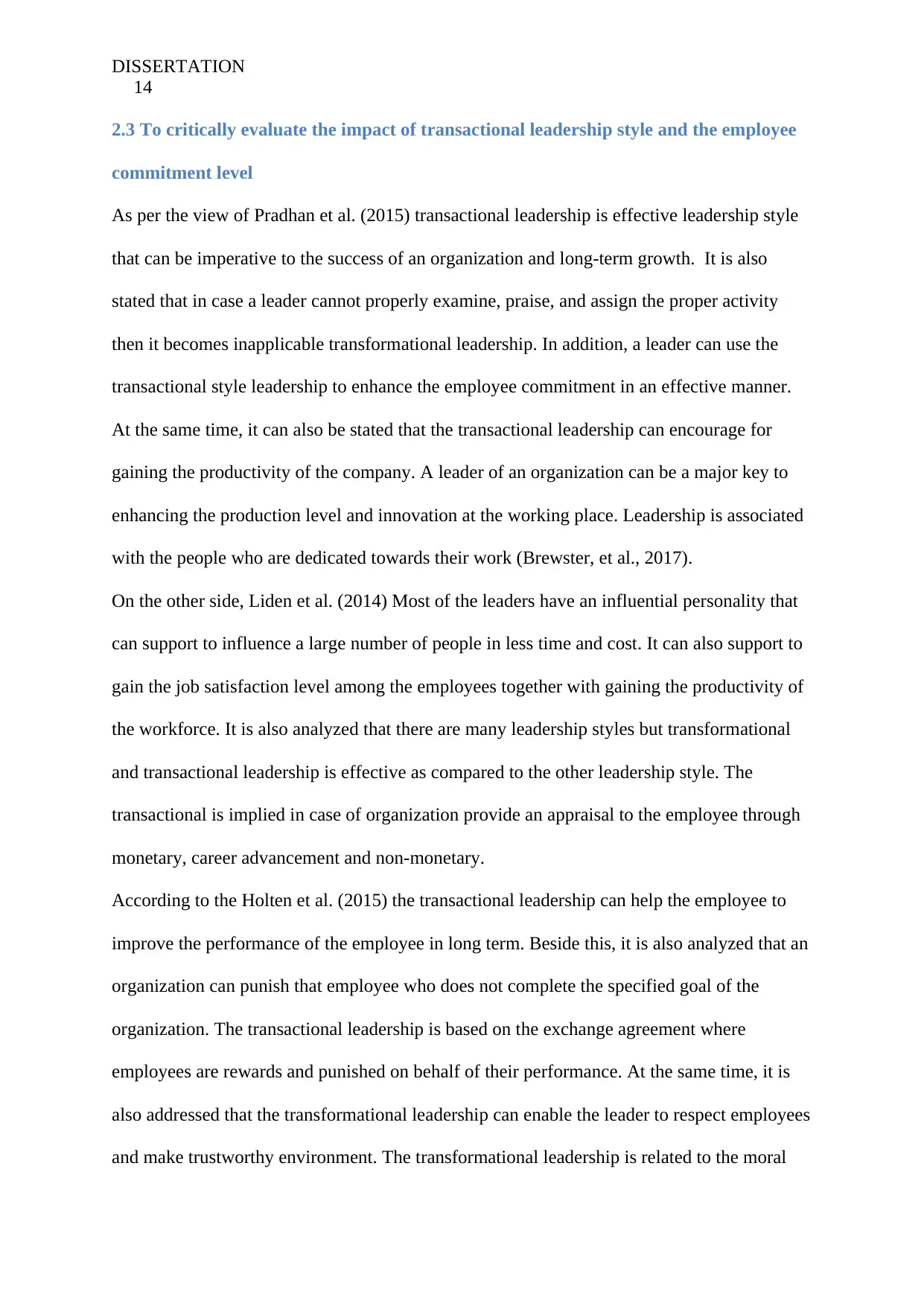
DISSERTATION
14
2.3 To critically evaluate the impact of transactional leadership style and the employee
commitment level
As per the view of Pradhan et al. (2015) transactional leadership is effective leadership style
that can be imperative to the success of an organization and long-term growth. It is also
stated that in case a leader cannot properly examine, praise, and assign the proper activity
then it becomes inapplicable transformational leadership. In addition, a leader can use the
transactional style leadership to enhance the employee commitment in an effective manner.
At the same time, it can also be stated that the transactional leadership can encourage for
gaining the productivity of the company. A leader of an organization can be a major key to
enhancing the production level and innovation at the working place. Leadership is associated
with the people who are dedicated towards their work (Brewster, et al., 2017).
On the other side, Liden et al. (2014) Most of the leaders have an influential personality that
can support to influence a large number of people in less time and cost. It can also support to
gain the job satisfaction level among the employees together with gaining the productivity of
the workforce. It is also analyzed that there are many leadership styles but transformational
and transactional leadership is effective as compared to the other leadership style. The
transactional is implied in case of organization provide an appraisal to the employee through
monetary, career advancement and non-monetary.
According to the Holten et al. (2015) the transactional leadership can help the employee to
improve the performance of the employee in long term. Beside this, it is also analyzed that an
organization can punish that employee who does not complete the specified goal of the
organization. The transactional leadership is based on the exchange agreement where
employees are rewards and punished on behalf of their performance. At the same time, it is
also addressed that the transformational leadership can enable the leader to respect employees
and make trustworthy environment. The transformational leadership is related to the moral
14
2.3 To critically evaluate the impact of transactional leadership style and the employee
commitment level
As per the view of Pradhan et al. (2015) transactional leadership is effective leadership style
that can be imperative to the success of an organization and long-term growth. It is also
stated that in case a leader cannot properly examine, praise, and assign the proper activity
then it becomes inapplicable transformational leadership. In addition, a leader can use the
transactional style leadership to enhance the employee commitment in an effective manner.
At the same time, it can also be stated that the transactional leadership can encourage for
gaining the productivity of the company. A leader of an organization can be a major key to
enhancing the production level and innovation at the working place. Leadership is associated
with the people who are dedicated towards their work (Brewster, et al., 2017).
On the other side, Liden et al. (2014) Most of the leaders have an influential personality that
can support to influence a large number of people in less time and cost. It can also support to
gain the job satisfaction level among the employees together with gaining the productivity of
the workforce. It is also analyzed that there are many leadership styles but transformational
and transactional leadership is effective as compared to the other leadership style. The
transactional is implied in case of organization provide an appraisal to the employee through
monetary, career advancement and non-monetary.
According to the Holten et al. (2015) the transactional leadership can help the employee to
improve the performance of the employee in long term. Beside this, it is also analyzed that an
organization can punish that employee who does not complete the specified goal of the
organization. The transactional leadership is based on the exchange agreement where
employees are rewards and punished on behalf of their performance. At the same time, it is
also addressed that the transformational leadership can enable the leader to respect employees
and make trustworthy environment. The transformational leadership is related to the moral
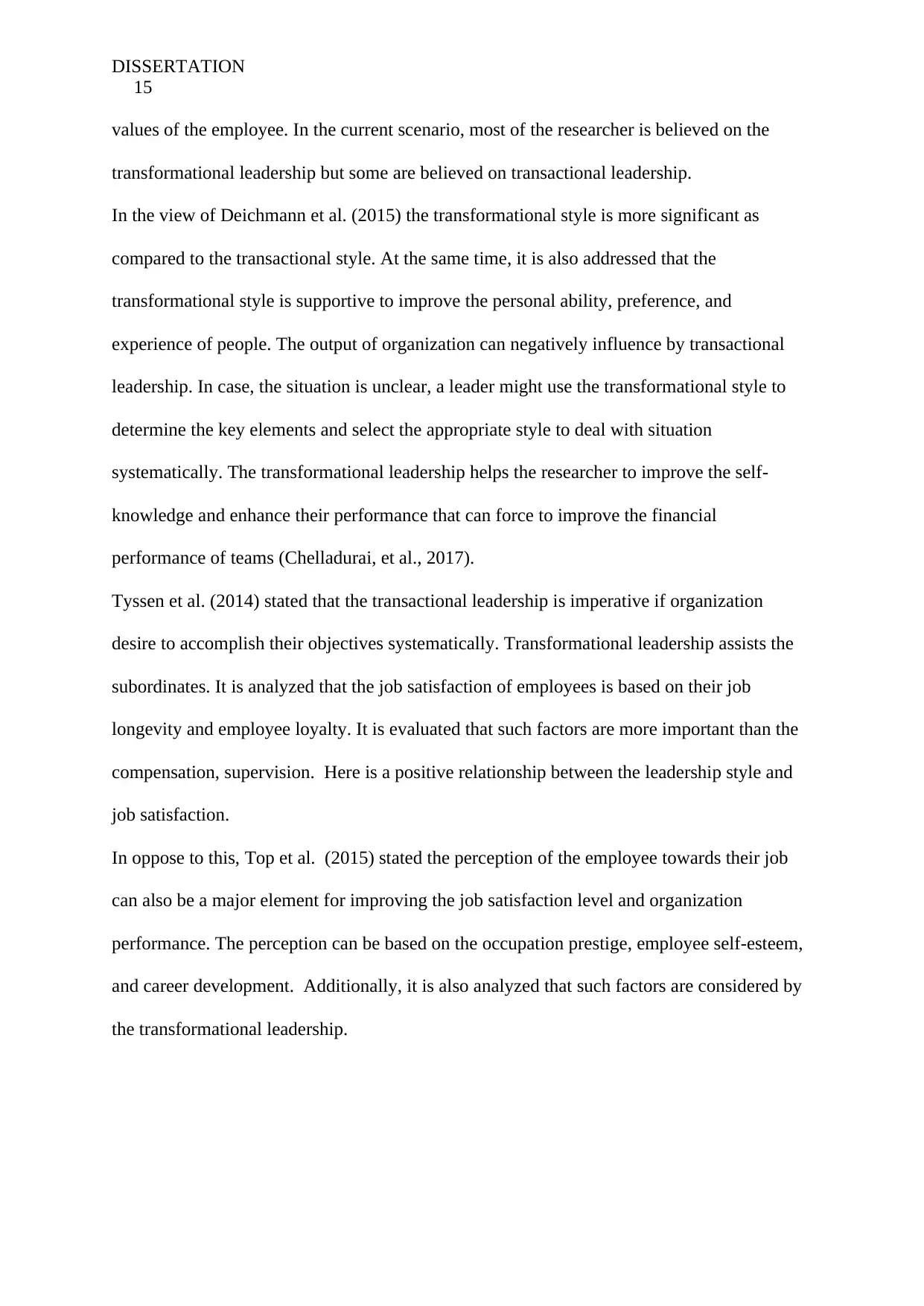
DISSERTATION
15
values of the employee. In the current scenario, most of the researcher is believed on the
transformational leadership but some are believed on transactional leadership.
In the view of Deichmann et al. (2015) the transformational style is more significant as
compared to the transactional style. At the same time, it is also addressed that the
transformational style is supportive to improve the personal ability, preference, and
experience of people. The output of organization can negatively influence by transactional
leadership. In case, the situation is unclear, a leader might use the transformational style to
determine the key elements and select the appropriate style to deal with situation
systematically. The transformational leadership helps the researcher to improve the self-
knowledge and enhance their performance that can force to improve the financial
performance of teams (Chelladurai, et al., 2017).
Tyssen et al. (2014) stated that the transactional leadership is imperative if organization
desire to accomplish their objectives systematically. Transformational leadership assists the
subordinates. It is analyzed that the job satisfaction of employees is based on their job
longevity and employee loyalty. It is evaluated that such factors are more important than the
compensation, supervision. Here is a positive relationship between the leadership style and
job satisfaction.
In oppose to this, Top et al. (2015) stated the perception of the employee towards their job
can also be a major element for improving the job satisfaction level and organization
performance. The perception can be based on the occupation prestige, employee self-esteem,
and career development. Additionally, it is also analyzed that such factors are considered by
the transformational leadership.
15
values of the employee. In the current scenario, most of the researcher is believed on the
transformational leadership but some are believed on transactional leadership.
In the view of Deichmann et al. (2015) the transformational style is more significant as
compared to the transactional style. At the same time, it is also addressed that the
transformational style is supportive to improve the personal ability, preference, and
experience of people. The output of organization can negatively influence by transactional
leadership. In case, the situation is unclear, a leader might use the transformational style to
determine the key elements and select the appropriate style to deal with situation
systematically. The transformational leadership helps the researcher to improve the self-
knowledge and enhance their performance that can force to improve the financial
performance of teams (Chelladurai, et al., 2017).
Tyssen et al. (2014) stated that the transactional leadership is imperative if organization
desire to accomplish their objectives systematically. Transformational leadership assists the
subordinates. It is analyzed that the job satisfaction of employees is based on their job
longevity and employee loyalty. It is evaluated that such factors are more important than the
compensation, supervision. Here is a positive relationship between the leadership style and
job satisfaction.
In oppose to this, Top et al. (2015) stated the perception of the employee towards their job
can also be a major element for improving the job satisfaction level and organization
performance. The perception can be based on the occupation prestige, employee self-esteem,
and career development. Additionally, it is also analyzed that such factors are considered by
the transformational leadership.

DISSERTATION
16
2.4 To critically assess the impact of the Laissez Faire leadership style and the level of
commitment of the employees
In support to this, Renko et al. (2015) the Laissez Faire style can enable the employee to
make their own decision and accomplish the task of organization. It can be a positive impact
on the commitment of employee. It is also analyzed that there is a positive relationship
between the laissez-faire leadership style and employee commitment. As a result, it can
motivate the employee to improve their confidence level and obtain the productivity of the
organization. The leaders cannot participate in the decision making of an organization that
can gain the productivity of organization in less time and cost.
2.5 To examine the influence of the transformational leadership style and the motivation
of employees
As per the view of Shurbagi (2014), the transformational leadership the quality of on an
individual that motivate others for accomplishing the specified goal systematically. The
transformational leadership is not only leading the employees but also aid in a complex
situation to gain the productivity of the employee. The leadership can be a combination of
two aspects such as property and process. It is also analyzed that the leadership is the
procedure to inspire the employees and lead them for accomplishing their specified task. It
can lead the employee to employee to attain their specified goal. Beside this, it can also
improve the productivity of employees as well as of the organization.
In oppose to this, Chen, et al. (2014) explained that the transformational leadership can
continuous procedure of inspiring the employees. An organization leader can also identify the
people who want to follow them. Leaders are the people who lead their team to increase their
loyalty and meet desired objectives. The transformation leadership enables the leaders to
effectively lead their team member and successfully deal with their issues. The
16
2.4 To critically assess the impact of the Laissez Faire leadership style and the level of
commitment of the employees
In support to this, Renko et al. (2015) the Laissez Faire style can enable the employee to
make their own decision and accomplish the task of organization. It can be a positive impact
on the commitment of employee. It is also analyzed that there is a positive relationship
between the laissez-faire leadership style and employee commitment. As a result, it can
motivate the employee to improve their confidence level and obtain the productivity of the
organization. The leaders cannot participate in the decision making of an organization that
can gain the productivity of organization in less time and cost.
2.5 To examine the influence of the transformational leadership style and the motivation
of employees
As per the view of Shurbagi (2014), the transformational leadership the quality of on an
individual that motivate others for accomplishing the specified goal systematically. The
transformational leadership is not only leading the employees but also aid in a complex
situation to gain the productivity of the employee. The leadership can be a combination of
two aspects such as property and process. It is also analyzed that the leadership is the
procedure to inspire the employees and lead them for accomplishing their specified task. It
can lead the employee to employee to attain their specified goal. Beside this, it can also
improve the productivity of employees as well as of the organization.
In oppose to this, Chen, et al. (2014) explained that the transformational leadership can
continuous procedure of inspiring the employees. An organization leader can also identify the
people who want to follow them. Leaders are the people who lead their team to increase their
loyalty and meet desired objectives. The transformation leadership enables the leaders to
effectively lead their team member and successfully deal with their issues. The
Secure Best Marks with AI Grader
Need help grading? Try our AI Grader for instant feedback on your assignments.
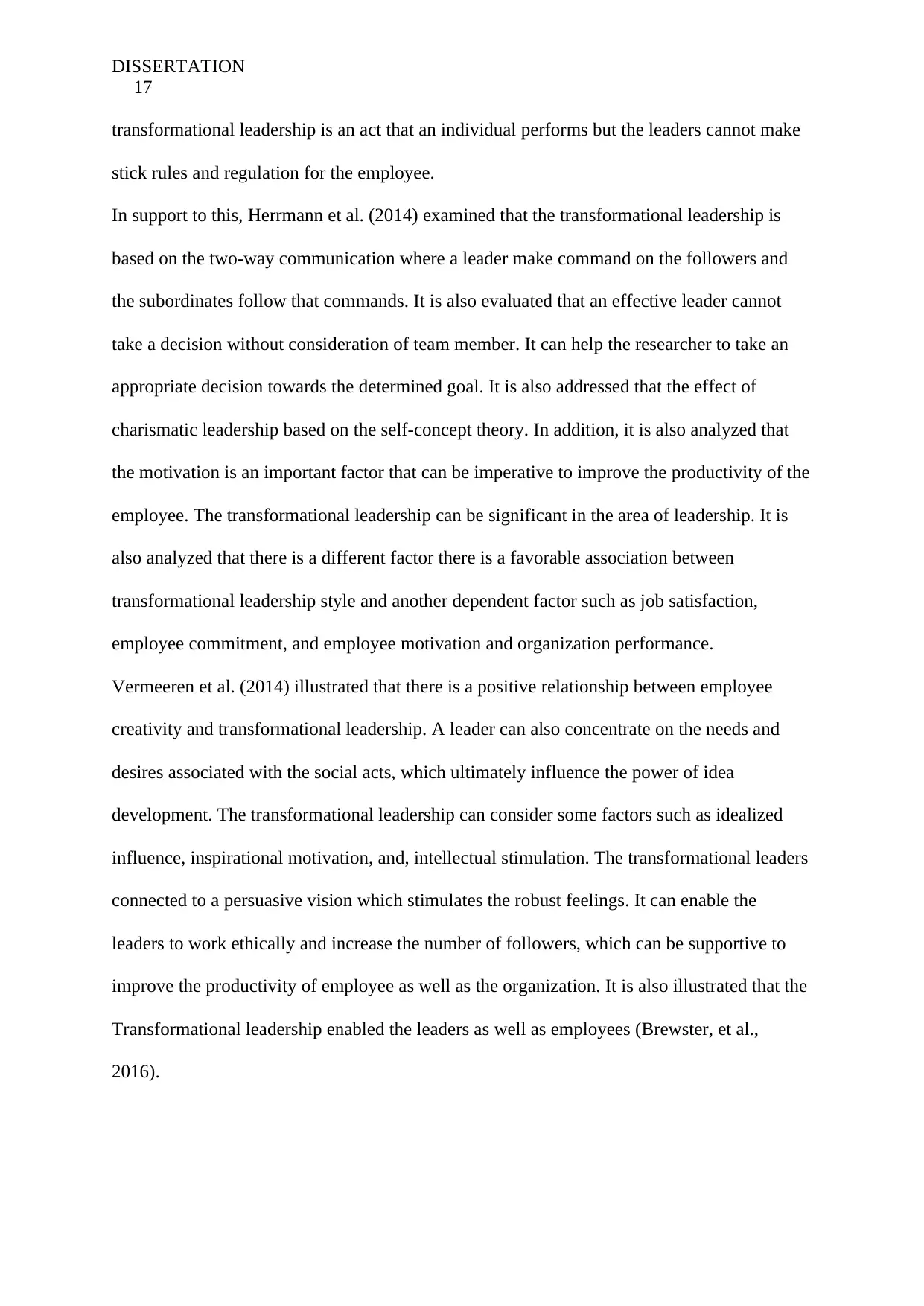
DISSERTATION
17
transformational leadership is an act that an individual performs but the leaders cannot make
stick rules and regulation for the employee.
In support to this, Herrmann et al. (2014) examined that the transformational leadership is
based on the two-way communication where a leader make command on the followers and
the subordinates follow that commands. It is also evaluated that an effective leader cannot
take a decision without consideration of team member. It can help the researcher to take an
appropriate decision towards the determined goal. It is also addressed that the effect of
charismatic leadership based on the self-concept theory. In addition, it is also analyzed that
the motivation is an important factor that can be imperative to improve the productivity of the
employee. The transformational leadership can be significant in the area of leadership. It is
also analyzed that there is a different factor there is a favorable association between
transformational leadership style and another dependent factor such as job satisfaction,
employee commitment, and employee motivation and organization performance.
Vermeeren et al. (2014) illustrated that there is a positive relationship between employee
creativity and transformational leadership. A leader can also concentrate on the needs and
desires associated with the social acts, which ultimately influence the power of idea
development. The transformational leadership can consider some factors such as idealized
influence, inspirational motivation, and, intellectual stimulation. The transformational leaders
connected to a persuasive vision which stimulates the robust feelings. It can enable the
leaders to work ethically and increase the number of followers, which can be supportive to
improve the productivity of employee as well as the organization. It is also illustrated that the
Transformational leadership enabled the leaders as well as employees (Brewster, et al.,
2016).
17
transformational leadership is an act that an individual performs but the leaders cannot make
stick rules and regulation for the employee.
In support to this, Herrmann et al. (2014) examined that the transformational leadership is
based on the two-way communication where a leader make command on the followers and
the subordinates follow that commands. It is also evaluated that an effective leader cannot
take a decision without consideration of team member. It can help the researcher to take an
appropriate decision towards the determined goal. It is also addressed that the effect of
charismatic leadership based on the self-concept theory. In addition, it is also analyzed that
the motivation is an important factor that can be imperative to improve the productivity of the
employee. The transformational leadership can be significant in the area of leadership. It is
also analyzed that there is a different factor there is a favorable association between
transformational leadership style and another dependent factor such as job satisfaction,
employee commitment, and employee motivation and organization performance.
Vermeeren et al. (2014) illustrated that there is a positive relationship between employee
creativity and transformational leadership. A leader can also concentrate on the needs and
desires associated with the social acts, which ultimately influence the power of idea
development. The transformational leadership can consider some factors such as idealized
influence, inspirational motivation, and, intellectual stimulation. The transformational leaders
connected to a persuasive vision which stimulates the robust feelings. It can enable the
leaders to work ethically and increase the number of followers, which can be supportive to
improve the productivity of employee as well as the organization. It is also illustrated that the
Transformational leadership enabled the leaders as well as employees (Brewster, et al.,
2016).
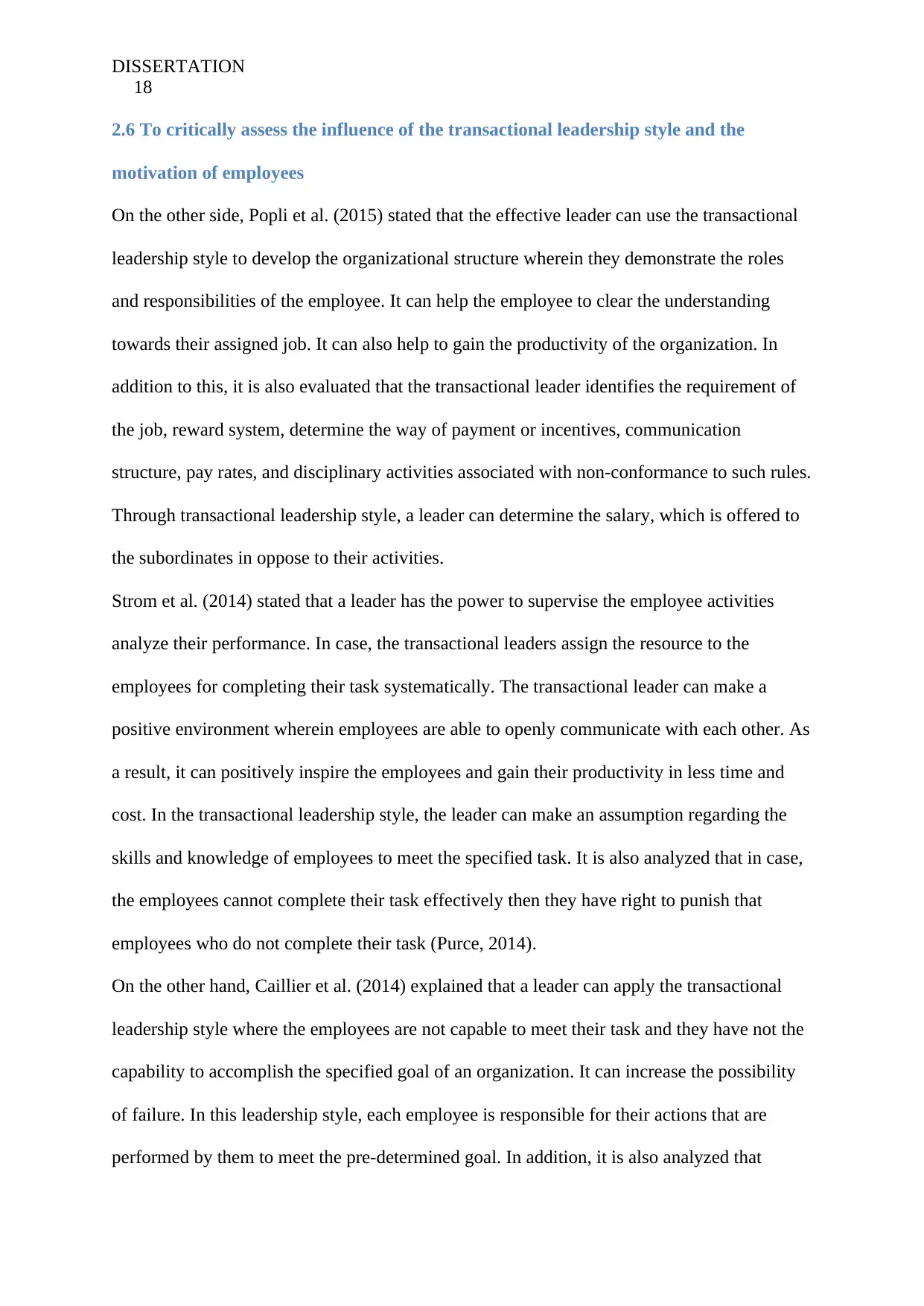
DISSERTATION
18
2.6 To critically assess the influence of the transactional leadership style and the
motivation of employees
On the other side, Popli et al. (2015) stated that the effective leader can use the transactional
leadership style to develop the organizational structure wherein they demonstrate the roles
and responsibilities of the employee. It can help the employee to clear the understanding
towards their assigned job. It can also help to gain the productivity of the organization. In
addition to this, it is also evaluated that the transactional leader identifies the requirement of
the job, reward system, determine the way of payment or incentives, communication
structure, pay rates, and disciplinary activities associated with non-conformance to such rules.
Through transactional leadership style, a leader can determine the salary, which is offered to
the subordinates in oppose to their activities.
Strom et al. (2014) stated that a leader has the power to supervise the employee activities
analyze their performance. In case, the transactional leaders assign the resource to the
employees for completing their task systematically. The transactional leader can make a
positive environment wherein employees are able to openly communicate with each other. As
a result, it can positively inspire the employees and gain their productivity in less time and
cost. In the transactional leadership style, the leader can make an assumption regarding the
skills and knowledge of employees to meet the specified task. It is also analyzed that in case,
the employees cannot complete their task effectively then they have right to punish that
employees who do not complete their task (Purce, 2014).
On the other hand, Caillier et al. (2014) explained that a leader can apply the transactional
leadership style where the employees are not capable to meet their task and they have not the
capability to accomplish the specified goal of an organization. It can increase the possibility
of failure. In this leadership style, each employee is responsible for their actions that are
performed by them to meet the pre-determined goal. In addition, it is also analyzed that
18
2.6 To critically assess the influence of the transactional leadership style and the
motivation of employees
On the other side, Popli et al. (2015) stated that the effective leader can use the transactional
leadership style to develop the organizational structure wherein they demonstrate the roles
and responsibilities of the employee. It can help the employee to clear the understanding
towards their assigned job. It can also help to gain the productivity of the organization. In
addition to this, it is also evaluated that the transactional leader identifies the requirement of
the job, reward system, determine the way of payment or incentives, communication
structure, pay rates, and disciplinary activities associated with non-conformance to such rules.
Through transactional leadership style, a leader can determine the salary, which is offered to
the subordinates in oppose to their activities.
Strom et al. (2014) stated that a leader has the power to supervise the employee activities
analyze their performance. In case, the transactional leaders assign the resource to the
employees for completing their task systematically. The transactional leader can make a
positive environment wherein employees are able to openly communicate with each other. As
a result, it can positively inspire the employees and gain their productivity in less time and
cost. In the transactional leadership style, the leader can make an assumption regarding the
skills and knowledge of employees to meet the specified task. It is also analyzed that in case,
the employees cannot complete their task effectively then they have right to punish that
employees who do not complete their task (Purce, 2014).
On the other hand, Caillier et al. (2014) explained that a leader can apply the transactional
leadership style where the employees are not capable to meet their task and they have not the
capability to accomplish the specified goal of an organization. It can increase the possibility
of failure. In this leadership style, each employee is responsible for their actions that are
performed by them to meet the pre-determined goal. In addition, it is also analyzed that
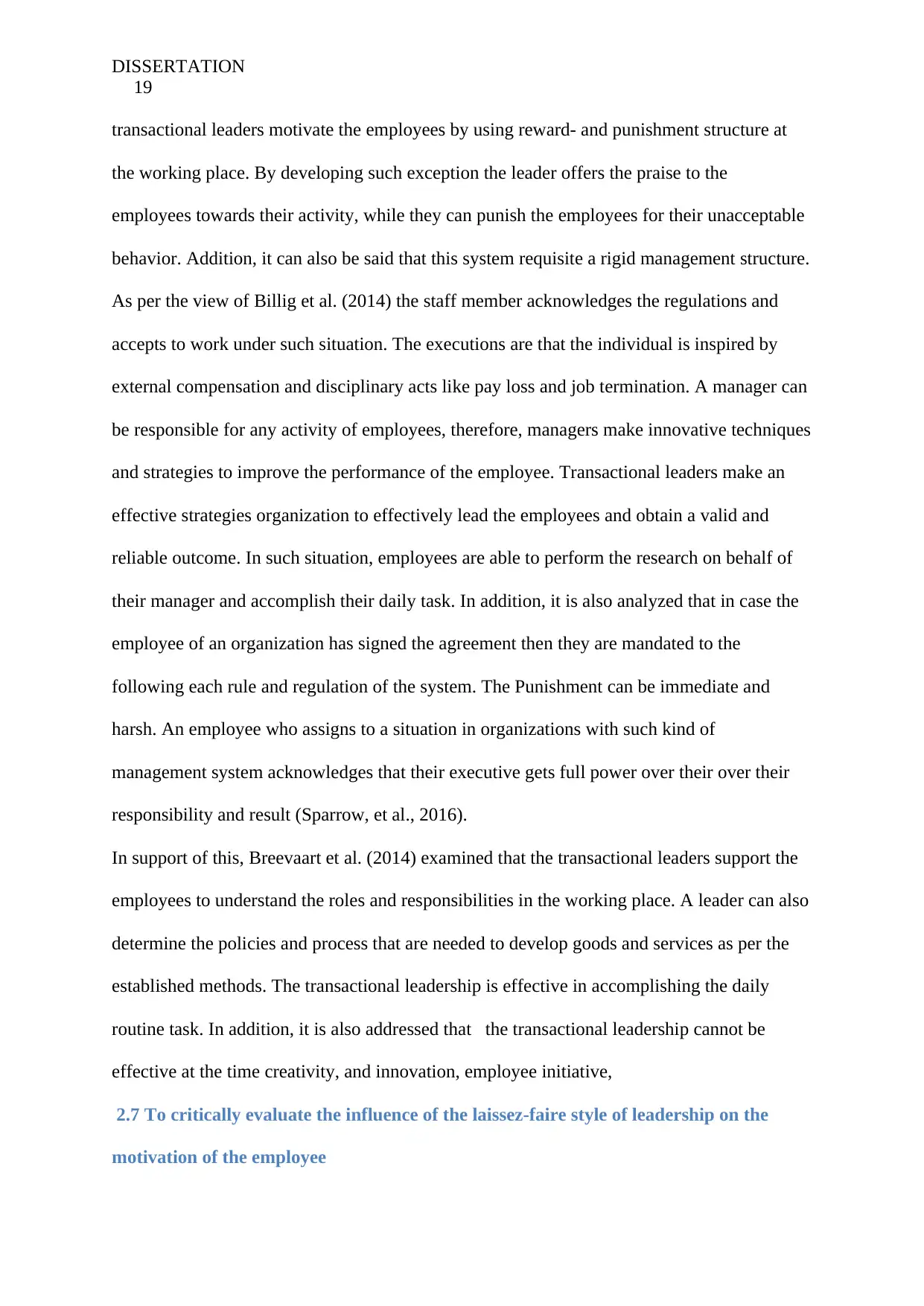
DISSERTATION
19
transactional leaders motivate the employees by using reward- and punishment structure at
the working place. By developing such exception the leader offers the praise to the
employees towards their activity, while they can punish the employees for their unacceptable
behavior. Addition, it can also be said that this system requisite a rigid management structure.
As per the view of Billig et al. (2014) the staff member acknowledges the regulations and
accepts to work under such situation. The executions are that the individual is inspired by
external compensation and disciplinary acts like pay loss and job termination. A manager can
be responsible for any activity of employees, therefore, managers make innovative techniques
and strategies to improve the performance of the employee. Transactional leaders make an
effective strategies organization to effectively lead the employees and obtain a valid and
reliable outcome. In such situation, employees are able to perform the research on behalf of
their manager and accomplish their daily task. In addition, it is also analyzed that in case the
employee of an organization has signed the agreement then they are mandated to the
following each rule and regulation of the system. The Punishment can be immediate and
harsh. An employee who assigns to a situation in organizations with such kind of
management system acknowledges that their executive gets full power over their over their
responsibility and result (Sparrow, et al., 2016).
In support of this, Breevaart et al. (2014) examined that the transactional leaders support the
employees to understand the roles and responsibilities in the working place. A leader can also
determine the policies and process that are needed to develop goods and services as per the
established methods. The transactional leadership is effective in accomplishing the daily
routine task. In addition, it is also addressed that the transactional leadership cannot be
effective at the time creativity, and innovation, employee initiative,
2.7 To critically evaluate the influence of the laissez-faire style of leadership on the
motivation of the employee
19
transactional leaders motivate the employees by using reward- and punishment structure at
the working place. By developing such exception the leader offers the praise to the
employees towards their activity, while they can punish the employees for their unacceptable
behavior. Addition, it can also be said that this system requisite a rigid management structure.
As per the view of Billig et al. (2014) the staff member acknowledges the regulations and
accepts to work under such situation. The executions are that the individual is inspired by
external compensation and disciplinary acts like pay loss and job termination. A manager can
be responsible for any activity of employees, therefore, managers make innovative techniques
and strategies to improve the performance of the employee. Transactional leaders make an
effective strategies organization to effectively lead the employees and obtain a valid and
reliable outcome. In such situation, employees are able to perform the research on behalf of
their manager and accomplish their daily task. In addition, it is also analyzed that in case the
employee of an organization has signed the agreement then they are mandated to the
following each rule and regulation of the system. The Punishment can be immediate and
harsh. An employee who assigns to a situation in organizations with such kind of
management system acknowledges that their executive gets full power over their over their
responsibility and result (Sparrow, et al., 2016).
In support of this, Breevaart et al. (2014) examined that the transactional leaders support the
employees to understand the roles and responsibilities in the working place. A leader can also
determine the policies and process that are needed to develop goods and services as per the
established methods. The transactional leadership is effective in accomplishing the daily
routine task. In addition, it is also addressed that the transactional leadership cannot be
effective at the time creativity, and innovation, employee initiative,
2.7 To critically evaluate the influence of the laissez-faire style of leadership on the
motivation of the employee
Paraphrase This Document
Need a fresh take? Get an instant paraphrase of this document with our AI Paraphraser
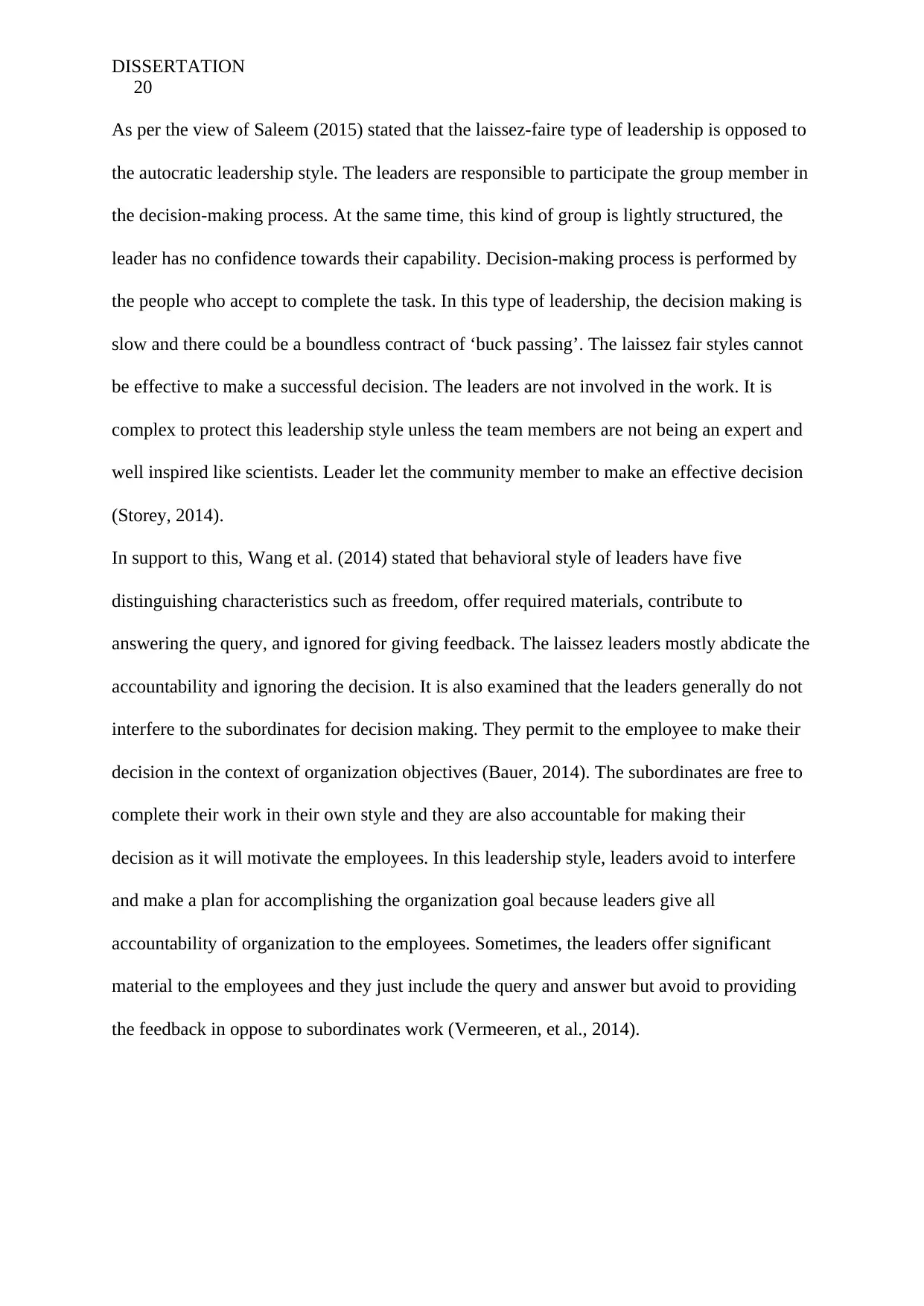
DISSERTATION
20
As per the view of Saleem (2015) stated that the laissez-faire type of leadership is opposed to
the autocratic leadership style. The leaders are responsible to participate the group member in
the decision-making process. At the same time, this kind of group is lightly structured, the
leader has no confidence towards their capability. Decision-making process is performed by
the people who accept to complete the task. In this type of leadership, the decision making is
slow and there could be a boundless contract of ‘buck passing’. The laissez fair styles cannot
be effective to make a successful decision. The leaders are not involved in the work. It is
complex to protect this leadership style unless the team members are not being an expert and
well inspired like scientists. Leader let the community member to make an effective decision
(Storey, 2014).
In support to this, Wang et al. (2014) stated that behavioral style of leaders have five
distinguishing characteristics such as freedom, offer required materials, contribute to
answering the query, and ignored for giving feedback. The laissez leaders mostly abdicate the
accountability and ignoring the decision. It is also examined that the leaders generally do not
interfere to the subordinates for decision making. They permit to the employee to make their
decision in the context of organization objectives (Bauer, 2014). The subordinates are free to
complete their work in their own style and they are also accountable for making their
decision as it will motivate the employees. In this leadership style, leaders avoid to interfere
and make a plan for accomplishing the organization goal because leaders give all
accountability of organization to the employees. Sometimes, the leaders offer significant
material to the employees and they just include the query and answer but avoid to providing
the feedback in oppose to subordinates work (Vermeeren, et al., 2014).
20
As per the view of Saleem (2015) stated that the laissez-faire type of leadership is opposed to
the autocratic leadership style. The leaders are responsible to participate the group member in
the decision-making process. At the same time, this kind of group is lightly structured, the
leader has no confidence towards their capability. Decision-making process is performed by
the people who accept to complete the task. In this type of leadership, the decision making is
slow and there could be a boundless contract of ‘buck passing’. The laissez fair styles cannot
be effective to make a successful decision. The leaders are not involved in the work. It is
complex to protect this leadership style unless the team members are not being an expert and
well inspired like scientists. Leader let the community member to make an effective decision
(Storey, 2014).
In support to this, Wang et al. (2014) stated that behavioral style of leaders have five
distinguishing characteristics such as freedom, offer required materials, contribute to
answering the query, and ignored for giving feedback. The laissez leaders mostly abdicate the
accountability and ignoring the decision. It is also examined that the leaders generally do not
interfere to the subordinates for decision making. They permit to the employee to make their
decision in the context of organization objectives (Bauer, 2014). The subordinates are free to
complete their work in their own style and they are also accountable for making their
decision as it will motivate the employees. In this leadership style, leaders avoid to interfere
and make a plan for accomplishing the organization goal because leaders give all
accountability of organization to the employees. Sometimes, the leaders offer significant
material to the employees and they just include the query and answer but avoid to providing
the feedback in oppose to subordinates work (Vermeeren, et al., 2014).
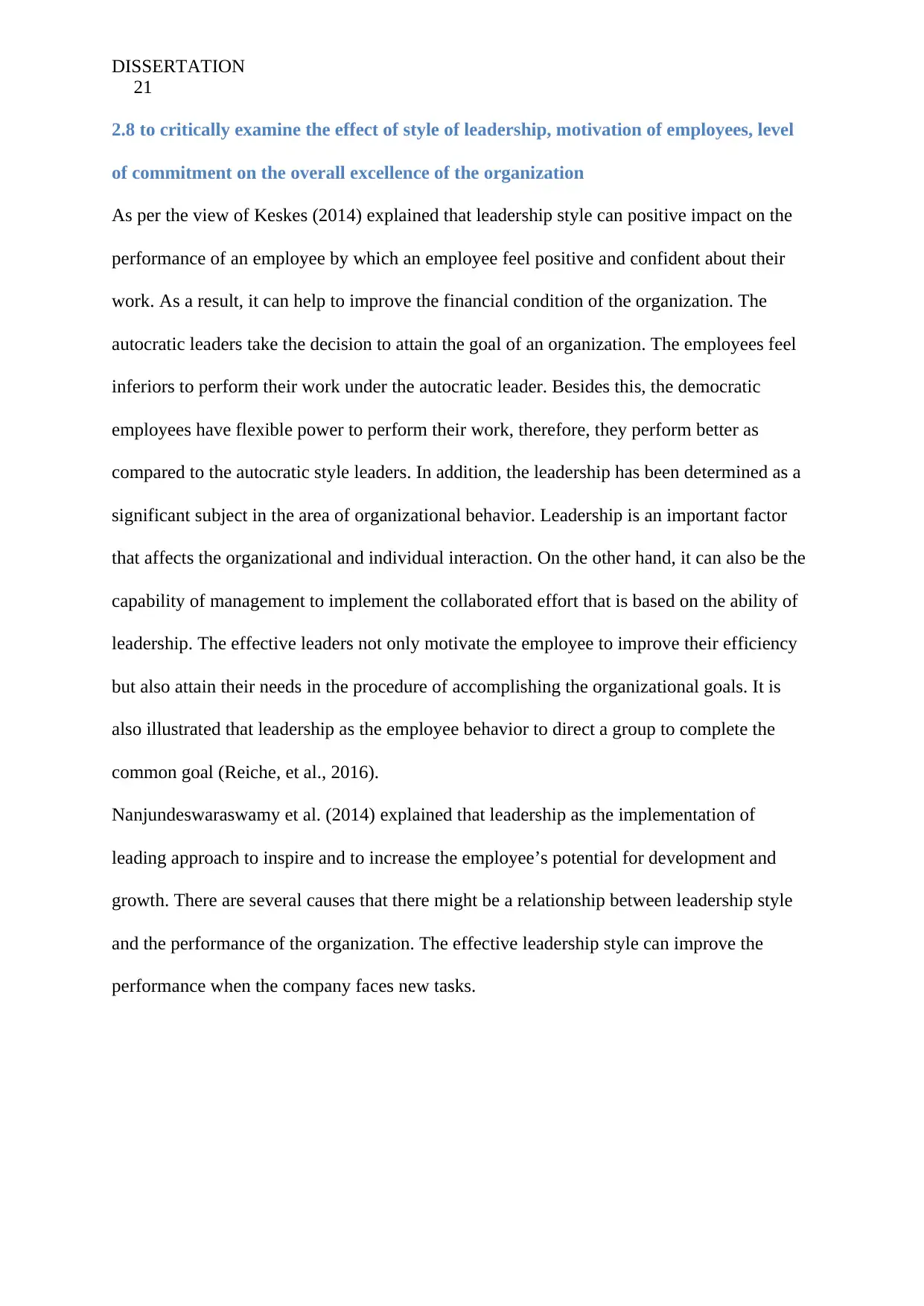
DISSERTATION
21
2.8 to critically examine the effect of style of leadership, motivation of employees, level
of commitment on the overall excellence of the organization
As per the view of Keskes (2014) explained that leadership style can positive impact on the
performance of an employee by which an employee feel positive and confident about their
work. As a result, it can help to improve the financial condition of the organization. The
autocratic leaders take the decision to attain the goal of an organization. The employees feel
inferiors to perform their work under the autocratic leader. Besides this, the democratic
employees have flexible power to perform their work, therefore, they perform better as
compared to the autocratic style leaders. In addition, the leadership has been determined as a
significant subject in the area of organizational behavior. Leadership is an important factor
that affects the organizational and individual interaction. On the other hand, it can also be the
capability of management to implement the collaborated effort that is based on the ability of
leadership. The effective leaders not only motivate the employee to improve their efficiency
but also attain their needs in the procedure of accomplishing the organizational goals. It is
also illustrated that leadership as the employee behavior to direct a group to complete the
common goal (Reiche, et al., 2016).
Nanjundeswaraswamy et al. (2014) explained that leadership as the implementation of
leading approach to inspire and to increase the employee’s potential for development and
growth. There are several causes that there might be a relationship between leadership style
and the performance of the organization. The effective leadership style can improve the
performance when the company faces new tasks.
21
2.8 to critically examine the effect of style of leadership, motivation of employees, level
of commitment on the overall excellence of the organization
As per the view of Keskes (2014) explained that leadership style can positive impact on the
performance of an employee by which an employee feel positive and confident about their
work. As a result, it can help to improve the financial condition of the organization. The
autocratic leaders take the decision to attain the goal of an organization. The employees feel
inferiors to perform their work under the autocratic leader. Besides this, the democratic
employees have flexible power to perform their work, therefore, they perform better as
compared to the autocratic style leaders. In addition, the leadership has been determined as a
significant subject in the area of organizational behavior. Leadership is an important factor
that affects the organizational and individual interaction. On the other hand, it can also be the
capability of management to implement the collaborated effort that is based on the ability of
leadership. The effective leaders not only motivate the employee to improve their efficiency
but also attain their needs in the procedure of accomplishing the organizational goals. It is
also illustrated that leadership as the employee behavior to direct a group to complete the
common goal (Reiche, et al., 2016).
Nanjundeswaraswamy et al. (2014) explained that leadership as the implementation of
leading approach to inspire and to increase the employee’s potential for development and
growth. There are several causes that there might be a relationship between leadership style
and the performance of the organization. The effective leadership style can improve the
performance when the company faces new tasks.
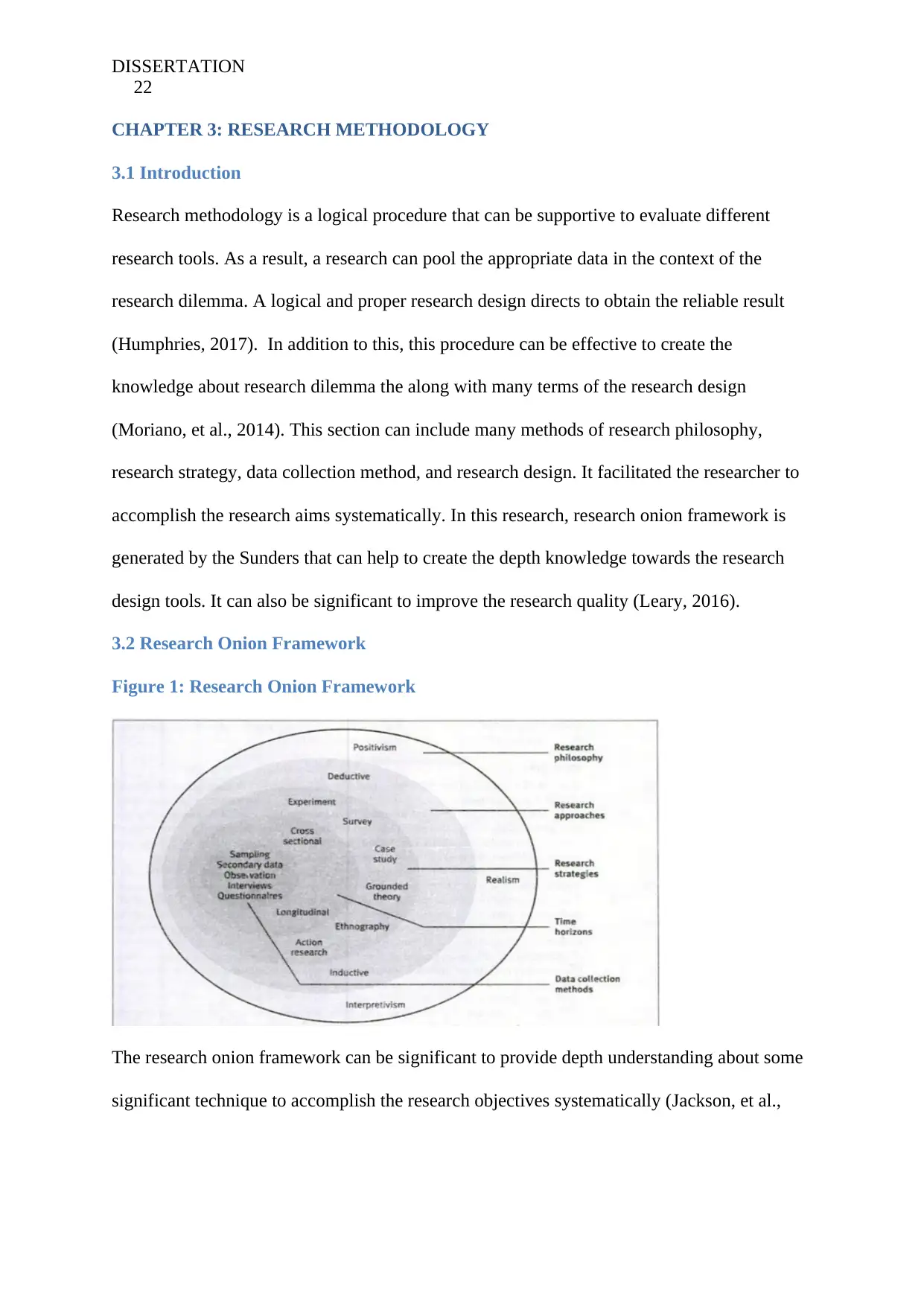
DISSERTATION
22
CHAPTER 3: RESEARCH METHODOLOGY
3.1 Introduction
Research methodology is a logical procedure that can be supportive to evaluate different
research tools. As a result, a research can pool the appropriate data in the context of the
research dilemma. A logical and proper research design directs to obtain the reliable result
(Humphries, 2017). In addition to this, this procedure can be effective to create the
knowledge about research dilemma the along with many terms of the research design
(Moriano, et al., 2014). This section can include many methods of research philosophy,
research strategy, data collection method, and research design. It facilitated the researcher to
accomplish the research aims systematically. In this research, research onion framework is
generated by the Sunders that can help to create the depth knowledge towards the research
design tools. It can also be significant to improve the research quality (Leary, 2016).
3.2 Research Onion Framework
Figure 1: Research Onion Framework
The research onion framework can be significant to provide depth understanding about some
significant technique to accomplish the research objectives systematically (Jackson, et al.,
22
CHAPTER 3: RESEARCH METHODOLOGY
3.1 Introduction
Research methodology is a logical procedure that can be supportive to evaluate different
research tools. As a result, a research can pool the appropriate data in the context of the
research dilemma. A logical and proper research design directs to obtain the reliable result
(Humphries, 2017). In addition to this, this procedure can be effective to create the
knowledge about research dilemma the along with many terms of the research design
(Moriano, et al., 2014). This section can include many methods of research philosophy,
research strategy, data collection method, and research design. It facilitated the researcher to
accomplish the research aims systematically. In this research, research onion framework is
generated by the Sunders that can help to create the depth knowledge towards the research
design tools. It can also be significant to improve the research quality (Leary, 2016).
3.2 Research Onion Framework
Figure 1: Research Onion Framework
The research onion framework can be significant to provide depth understanding about some
significant technique to accomplish the research objectives systematically (Jackson, et al.,
Secure Best Marks with AI Grader
Need help grading? Try our AI Grader for instant feedback on your assignments.
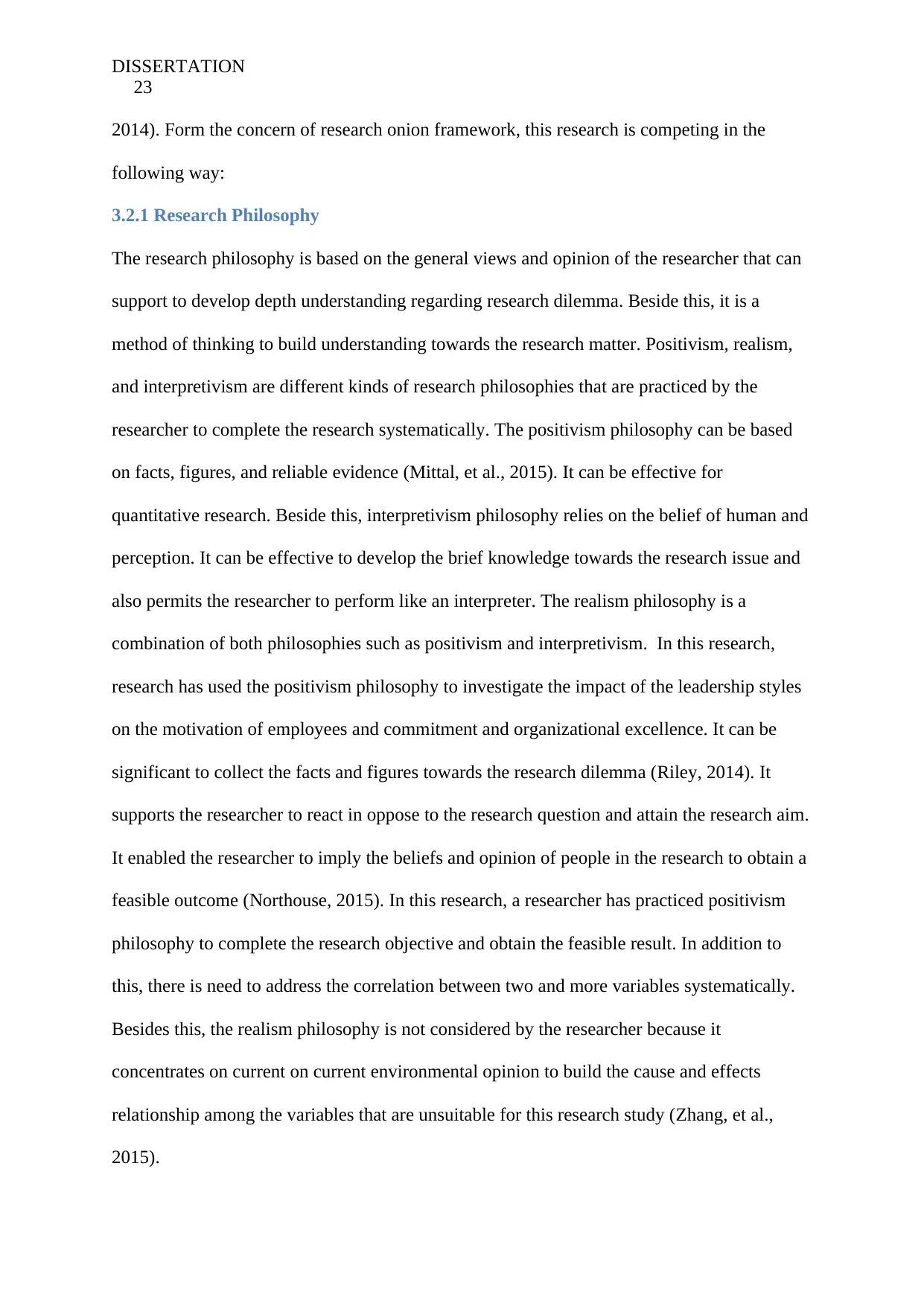
DISSERTATION
23
2014). Form the concern of research onion framework, this research is competing in the
following way:
3.2.1 Research Philosophy
The research philosophy is based on the general views and opinion of the researcher that can
support to develop depth understanding regarding research dilemma. Beside this, it is a
method of thinking to build understanding towards the research matter. Positivism, realism,
and interpretivism are different kinds of research philosophies that are practiced by the
researcher to complete the research systematically. The positivism philosophy can be based
on facts, figures, and reliable evidence (Mittal, et al., 2015). It can be effective for
quantitative research. Beside this, interpretivism philosophy relies on the belief of human and
perception. It can be effective to develop the brief knowledge towards the research issue and
also permits the researcher to perform like an interpreter. The realism philosophy is a
combination of both philosophies such as positivism and interpretivism. In this research,
research has used the positivism philosophy to investigate the impact of the leadership styles
on the motivation of employees and commitment and organizational excellence. It can be
significant to collect the facts and figures towards the research dilemma (Riley, 2014). It
supports the researcher to react in oppose to the research question and attain the research aim.
It enabled the researcher to imply the beliefs and opinion of people in the research to obtain a
feasible outcome (Northouse, 2015). In this research, a researcher has practiced positivism
philosophy to complete the research objective and obtain the feasible result. In addition to
this, there is need to address the correlation between two and more variables systematically.
Besides this, the realism philosophy is not considered by the researcher because it
concentrates on current on current environmental opinion to build the cause and effects
relationship among the variables that are unsuitable for this research study (Zhang, et al.,
2015).
23
2014). Form the concern of research onion framework, this research is competing in the
following way:
3.2.1 Research Philosophy
The research philosophy is based on the general views and opinion of the researcher that can
support to develop depth understanding regarding research dilemma. Beside this, it is a
method of thinking to build understanding towards the research matter. Positivism, realism,
and interpretivism are different kinds of research philosophies that are practiced by the
researcher to complete the research systematically. The positivism philosophy can be based
on facts, figures, and reliable evidence (Mittal, et al., 2015). It can be effective for
quantitative research. Beside this, interpretivism philosophy relies on the belief of human and
perception. It can be effective to develop the brief knowledge towards the research issue and
also permits the researcher to perform like an interpreter. The realism philosophy is a
combination of both philosophies such as positivism and interpretivism. In this research,
research has used the positivism philosophy to investigate the impact of the leadership styles
on the motivation of employees and commitment and organizational excellence. It can be
significant to collect the facts and figures towards the research dilemma (Riley, 2014). It
supports the researcher to react in oppose to the research question and attain the research aim.
It enabled the researcher to imply the beliefs and opinion of people in the research to obtain a
feasible outcome (Northouse, 2015). In this research, a researcher has practiced positivism
philosophy to complete the research objective and obtain the feasible result. In addition to
this, there is need to address the correlation between two and more variables systematically.
Besides this, the realism philosophy is not considered by the researcher because it
concentrates on current on current environmental opinion to build the cause and effects
relationship among the variables that are unsuitable for this research study (Zhang, et al.,
2015).
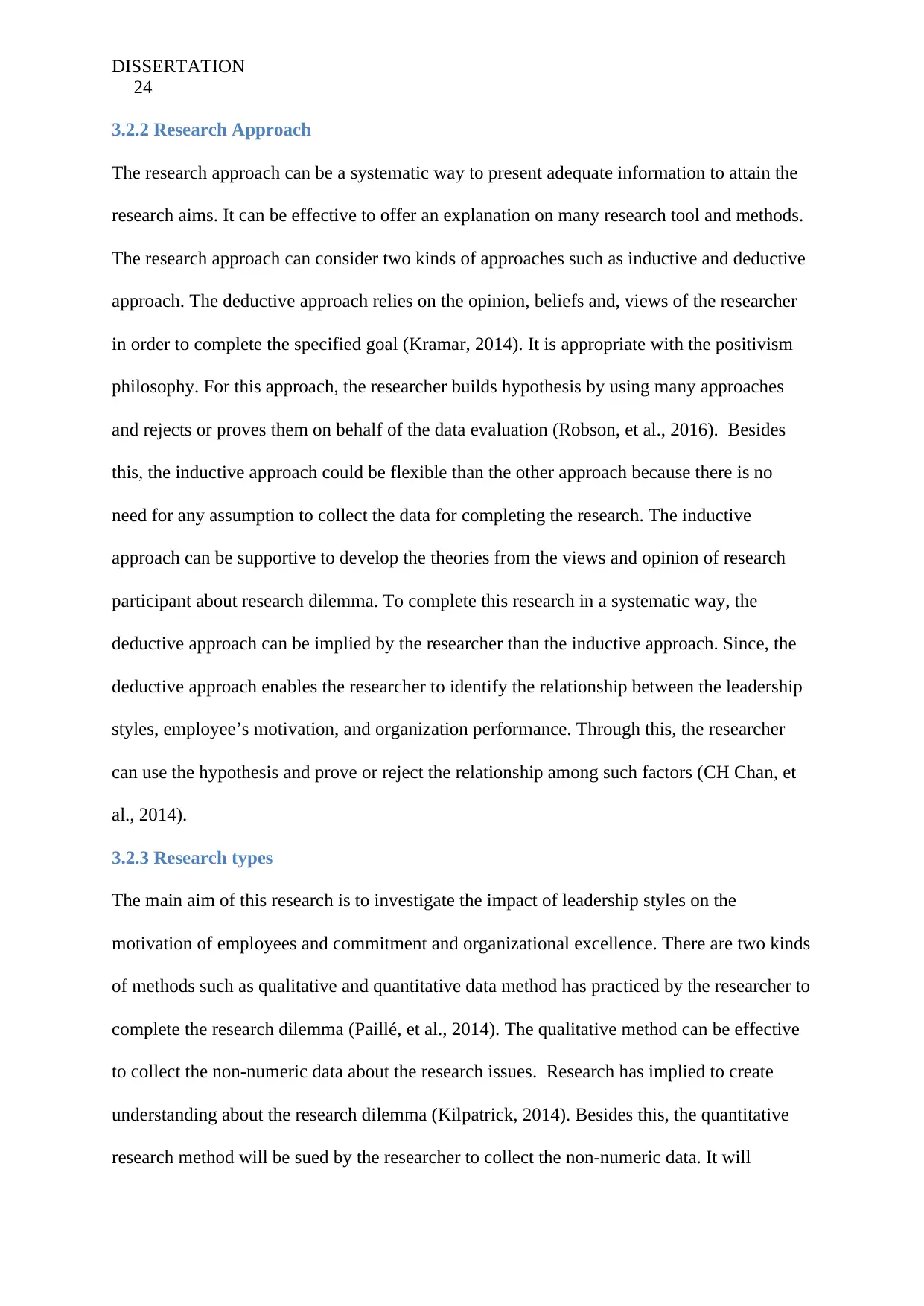
DISSERTATION
24
3.2.2 Research Approach
The research approach can be a systematic way to present adequate information to attain the
research aims. It can be effective to offer an explanation on many research tool and methods.
The research approach can consider two kinds of approaches such as inductive and deductive
approach. The deductive approach relies on the opinion, beliefs and, views of the researcher
in order to complete the specified goal (Kramar, 2014). It is appropriate with the positivism
philosophy. For this approach, the researcher builds hypothesis by using many approaches
and rejects or proves them on behalf of the data evaluation (Robson, et al., 2016). Besides
this, the inductive approach could be flexible than the other approach because there is no
need for any assumption to collect the data for completing the research. The inductive
approach can be supportive to develop the theories from the views and opinion of research
participant about research dilemma. To complete this research in a systematic way, the
deductive approach can be implied by the researcher than the inductive approach. Since, the
deductive approach enables the researcher to identify the relationship between the leadership
styles, employee’s motivation, and organization performance. Through this, the researcher
can use the hypothesis and prove or reject the relationship among such factors (CH Chan, et
al., 2014).
3.2.3 Research types
The main aim of this research is to investigate the impact of leadership styles on the
motivation of employees and commitment and organizational excellence. There are two kinds
of methods such as qualitative and quantitative data method has practiced by the researcher to
complete the research dilemma (Paillé, et al., 2014). The qualitative method can be effective
to collect the non-numeric data about the research issues. Research has implied to create
understanding about the research dilemma (Kilpatrick, 2014). Besides this, the quantitative
research method will be sued by the researcher to collect the non-numeric data. It will
24
3.2.2 Research Approach
The research approach can be a systematic way to present adequate information to attain the
research aims. It can be effective to offer an explanation on many research tool and methods.
The research approach can consider two kinds of approaches such as inductive and deductive
approach. The deductive approach relies on the opinion, beliefs and, views of the researcher
in order to complete the specified goal (Kramar, 2014). It is appropriate with the positivism
philosophy. For this approach, the researcher builds hypothesis by using many approaches
and rejects or proves them on behalf of the data evaluation (Robson, et al., 2016). Besides
this, the inductive approach could be flexible than the other approach because there is no
need for any assumption to collect the data for completing the research. The inductive
approach can be supportive to develop the theories from the views and opinion of research
participant about research dilemma. To complete this research in a systematic way, the
deductive approach can be implied by the researcher than the inductive approach. Since, the
deductive approach enables the researcher to identify the relationship between the leadership
styles, employee’s motivation, and organization performance. Through this, the researcher
can use the hypothesis and prove or reject the relationship among such factors (CH Chan, et
al., 2014).
3.2.3 Research types
The main aim of this research is to investigate the impact of leadership styles on the
motivation of employees and commitment and organizational excellence. There are two kinds
of methods such as qualitative and quantitative data method has practiced by the researcher to
complete the research dilemma (Paillé, et al., 2014). The qualitative method can be effective
to collect the non-numeric data about the research issues. Research has implied to create
understanding about the research dilemma (Kilpatrick, 2014). Besides this, the quantitative
research method will be sued by the researcher to collect the non-numeric data. It will
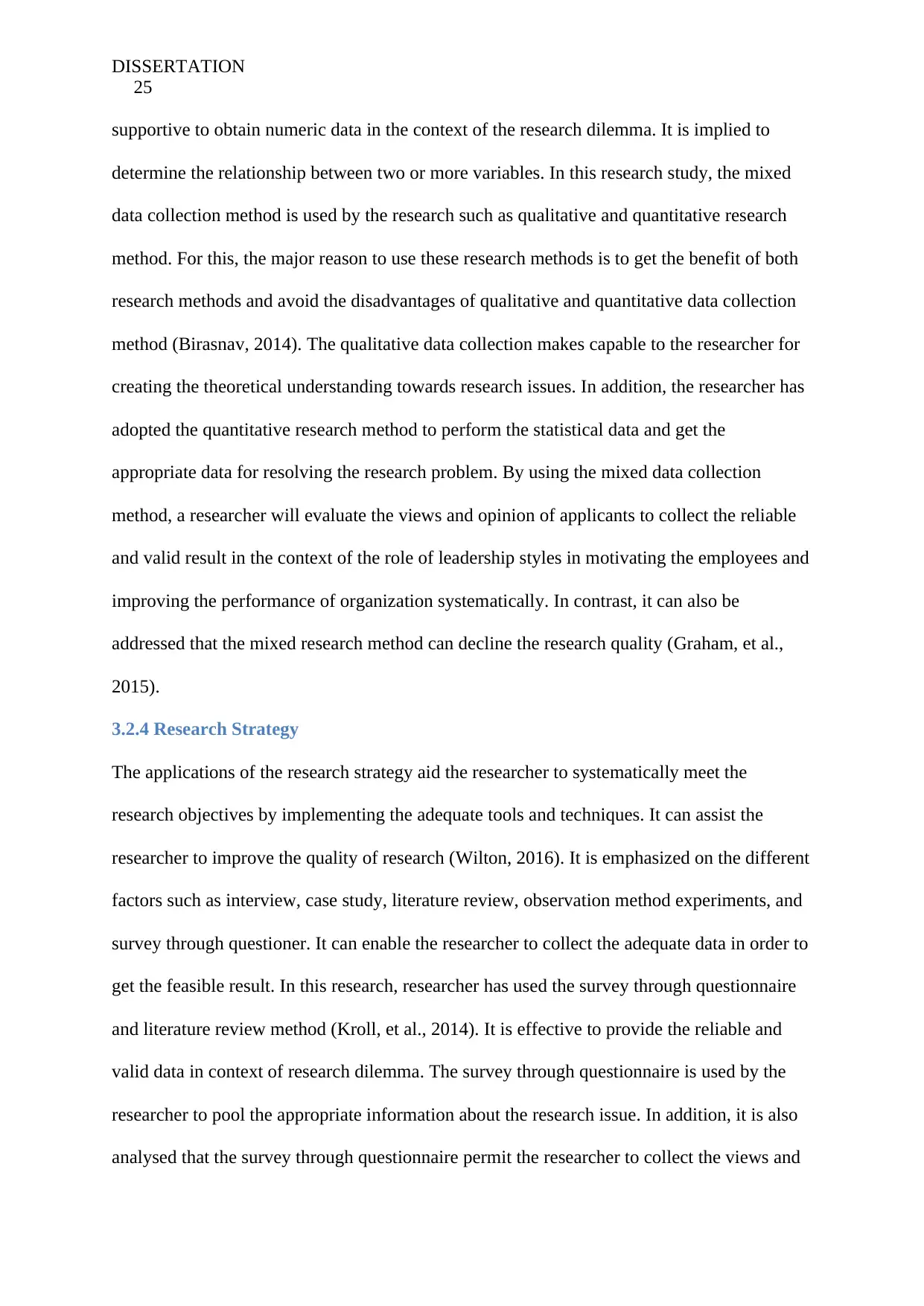
DISSERTATION
25
supportive to obtain numeric data in the context of the research dilemma. It is implied to
determine the relationship between two or more variables. In this research study, the mixed
data collection method is used by the research such as qualitative and quantitative research
method. For this, the major reason to use these research methods is to get the benefit of both
research methods and avoid the disadvantages of qualitative and quantitative data collection
method (Birasnav, 2014). The qualitative data collection makes capable to the researcher for
creating the theoretical understanding towards research issues. In addition, the researcher has
adopted the quantitative research method to perform the statistical data and get the
appropriate data for resolving the research problem. By using the mixed data collection
method, a researcher will evaluate the views and opinion of applicants to collect the reliable
and valid result in the context of the role of leadership styles in motivating the employees and
improving the performance of organization systematically. In contrast, it can also be
addressed that the mixed research method can decline the research quality (Graham, et al.,
2015).
3.2.4 Research Strategy
The applications of the research strategy aid the researcher to systematically meet the
research objectives by implementing the adequate tools and techniques. It can assist the
researcher to improve the quality of research (Wilton, 2016). It is emphasized on the different
factors such as interview, case study, literature review, observation method experiments, and
survey through questioner. It can enable the researcher to collect the adequate data in order to
get the feasible result. In this research, researcher has used the survey through questionnaire
and literature review method (Kroll, et al., 2014). It is effective to provide the reliable and
valid data in context of research dilemma. The survey through questionnaire is used by the
researcher to pool the appropriate information about the research issue. In addition, it is also
analysed that the survey through questionnaire permit the researcher to collect the views and
25
supportive to obtain numeric data in the context of the research dilemma. It is implied to
determine the relationship between two or more variables. In this research study, the mixed
data collection method is used by the research such as qualitative and quantitative research
method. For this, the major reason to use these research methods is to get the benefit of both
research methods and avoid the disadvantages of qualitative and quantitative data collection
method (Birasnav, 2014). The qualitative data collection makes capable to the researcher for
creating the theoretical understanding towards research issues. In addition, the researcher has
adopted the quantitative research method to perform the statistical data and get the
appropriate data for resolving the research problem. By using the mixed data collection
method, a researcher will evaluate the views and opinion of applicants to collect the reliable
and valid result in the context of the role of leadership styles in motivating the employees and
improving the performance of organization systematically. In contrast, it can also be
addressed that the mixed research method can decline the research quality (Graham, et al.,
2015).
3.2.4 Research Strategy
The applications of the research strategy aid the researcher to systematically meet the
research objectives by implementing the adequate tools and techniques. It can assist the
researcher to improve the quality of research (Wilton, 2016). It is emphasized on the different
factors such as interview, case study, literature review, observation method experiments, and
survey through questioner. It can enable the researcher to collect the adequate data in order to
get the feasible result. In this research, researcher has used the survey through questionnaire
and literature review method (Kroll, et al., 2014). It is effective to provide the reliable and
valid data in context of research dilemma. The survey through questionnaire is used by the
researcher to pool the appropriate information about the research issue. In addition, it is also
analysed that the survey through questionnaire permit the researcher to collect the views and
Paraphrase This Document
Need a fresh take? Get an instant paraphrase of this document with our AI Paraphraser
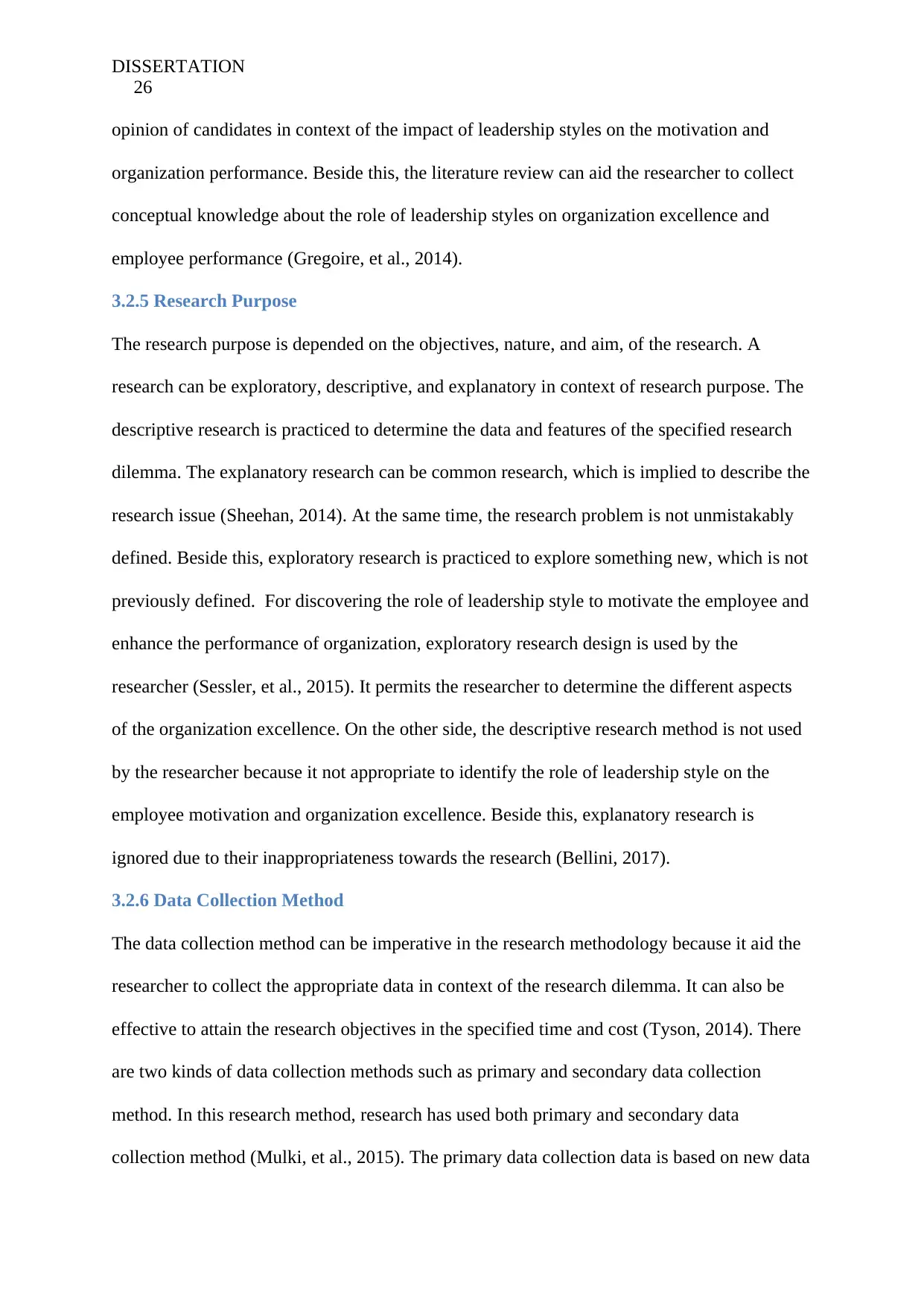
DISSERTATION
26
opinion of candidates in context of the impact of leadership styles on the motivation and
organization performance. Beside this, the literature review can aid the researcher to collect
conceptual knowledge about the role of leadership styles on organization excellence and
employee performance (Gregoire, et al., 2014).
3.2.5 Research Purpose
The research purpose is depended on the objectives, nature, and aim, of the research. A
research can be exploratory, descriptive, and explanatory in context of research purpose. The
descriptive research is practiced to determine the data and features of the specified research
dilemma. The explanatory research can be common research, which is implied to describe the
research issue (Sheehan, 2014). At the same time, the research problem is not unmistakably
defined. Beside this, exploratory research is practiced to explore something new, which is not
previously defined. For discovering the role of leadership style to motivate the employee and
enhance the performance of organization, exploratory research design is used by the
researcher (Sessler, et al., 2015). It permits the researcher to determine the different aspects
of the organization excellence. On the other side, the descriptive research method is not used
by the researcher because it not appropriate to identify the role of leadership style on the
employee motivation and organization excellence. Beside this, explanatory research is
ignored due to their inappropriateness towards the research (Bellini, 2017).
3.2.6 Data Collection Method
The data collection method can be imperative in the research methodology because it aid the
researcher to collect the appropriate data in context of the research dilemma. It can also be
effective to attain the research objectives in the specified time and cost (Tyson, 2014). There
are two kinds of data collection methods such as primary and secondary data collection
method. In this research method, research has used both primary and secondary data
collection method (Mulki, et al., 2015). The primary data collection data is based on new data
26
opinion of candidates in context of the impact of leadership styles on the motivation and
organization performance. Beside this, the literature review can aid the researcher to collect
conceptual knowledge about the role of leadership styles on organization excellence and
employee performance (Gregoire, et al., 2014).
3.2.5 Research Purpose
The research purpose is depended on the objectives, nature, and aim, of the research. A
research can be exploratory, descriptive, and explanatory in context of research purpose. The
descriptive research is practiced to determine the data and features of the specified research
dilemma. The explanatory research can be common research, which is implied to describe the
research issue (Sheehan, 2014). At the same time, the research problem is not unmistakably
defined. Beside this, exploratory research is practiced to explore something new, which is not
previously defined. For discovering the role of leadership style to motivate the employee and
enhance the performance of organization, exploratory research design is used by the
researcher (Sessler, et al., 2015). It permits the researcher to determine the different aspects
of the organization excellence. On the other side, the descriptive research method is not used
by the researcher because it not appropriate to identify the role of leadership style on the
employee motivation and organization excellence. Beside this, explanatory research is
ignored due to their inappropriateness towards the research (Bellini, 2017).
3.2.6 Data Collection Method
The data collection method can be imperative in the research methodology because it aid the
researcher to collect the appropriate data in context of the research dilemma. It can also be
effective to attain the research objectives in the specified time and cost (Tyson, 2014). There
are two kinds of data collection methods such as primary and secondary data collection
method. In this research method, research has used both primary and secondary data
collection method (Mulki, et al., 2015). The primary data collection data is based on new data
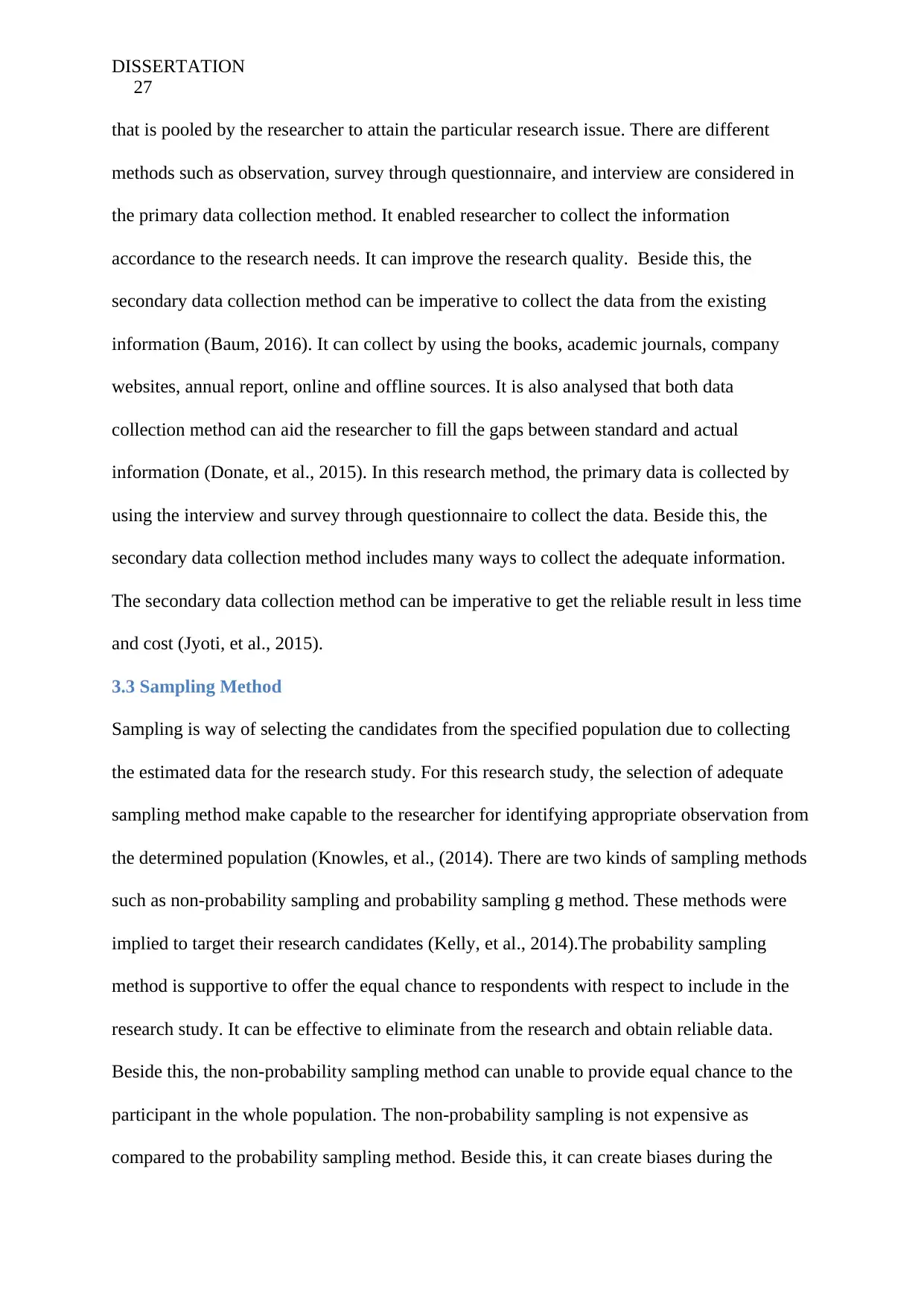
DISSERTATION
27
that is pooled by the researcher to attain the particular research issue. There are different
methods such as observation, survey through questionnaire, and interview are considered in
the primary data collection method. It enabled researcher to collect the information
accordance to the research needs. It can improve the research quality. Beside this, the
secondary data collection method can be imperative to collect the data from the existing
information (Baum, 2016). It can collect by using the books, academic journals, company
websites, annual report, online and offline sources. It is also analysed that both data
collection method can aid the researcher to fill the gaps between standard and actual
information (Donate, et al., 2015). In this research method, the primary data is collected by
using the interview and survey through questionnaire to collect the data. Beside this, the
secondary data collection method includes many ways to collect the adequate information.
The secondary data collection method can be imperative to get the reliable result in less time
and cost (Jyoti, et al., 2015).
3.3 Sampling Method
Sampling is way of selecting the candidates from the specified population due to collecting
the estimated data for the research study. For this research study, the selection of adequate
sampling method make capable to the researcher for identifying appropriate observation from
the determined population (Knowles, et al., (2014). There are two kinds of sampling methods
such as non-probability sampling and probability sampling g method. These methods were
implied to target their research candidates (Kelly, et al., 2014).The probability sampling
method is supportive to offer the equal chance to respondents with respect to include in the
research study. It can be effective to eliminate from the research and obtain reliable data.
Beside this, the non-probability sampling method can unable to provide equal chance to the
participant in the whole population. The non-probability sampling is not expensive as
compared to the probability sampling method. Beside this, it can create biases during the
27
that is pooled by the researcher to attain the particular research issue. There are different
methods such as observation, survey through questionnaire, and interview are considered in
the primary data collection method. It enabled researcher to collect the information
accordance to the research needs. It can improve the research quality. Beside this, the
secondary data collection method can be imperative to collect the data from the existing
information (Baum, 2016). It can collect by using the books, academic journals, company
websites, annual report, online and offline sources. It is also analysed that both data
collection method can aid the researcher to fill the gaps between standard and actual
information (Donate, et al., 2015). In this research method, the primary data is collected by
using the interview and survey through questionnaire to collect the data. Beside this, the
secondary data collection method includes many ways to collect the adequate information.
The secondary data collection method can be imperative to get the reliable result in less time
and cost (Jyoti, et al., 2015).
3.3 Sampling Method
Sampling is way of selecting the candidates from the specified population due to collecting
the estimated data for the research study. For this research study, the selection of adequate
sampling method make capable to the researcher for identifying appropriate observation from
the determined population (Knowles, et al., (2014). There are two kinds of sampling methods
such as non-probability sampling and probability sampling g method. These methods were
implied to target their research candidates (Kelly, et al., 2014).The probability sampling
method is supportive to offer the equal chance to respondents with respect to include in the
research study. It can be effective to eliminate from the research and obtain reliable data.
Beside this, the non-probability sampling method can unable to provide equal chance to the
participant in the whole population. The non-probability sampling is not expensive as
compared to the probability sampling method. Beside this, it can create biases during the
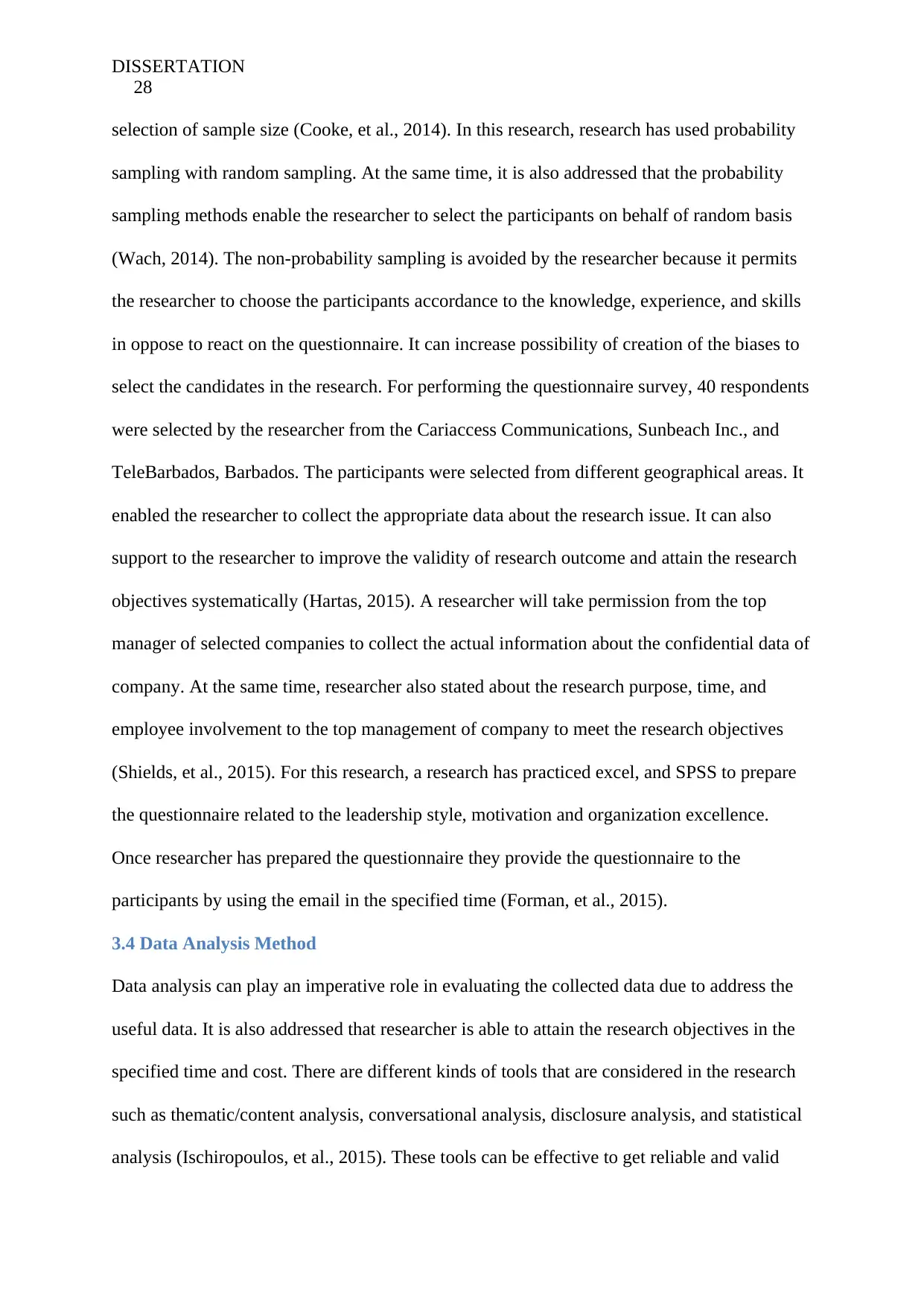
DISSERTATION
28
selection of sample size (Cooke, et al., 2014). In this research, research has used probability
sampling with random sampling. At the same time, it is also addressed that the probability
sampling methods enable the researcher to select the participants on behalf of random basis
(Wach, 2014). The non-probability sampling is avoided by the researcher because it permits
the researcher to choose the participants accordance to the knowledge, experience, and skills
in oppose to react on the questionnaire. It can increase possibility of creation of the biases to
select the candidates in the research. For performing the questionnaire survey, 40 respondents
were selected by the researcher from the Cariaccess Communications, Sunbeach Inc., and
TeleBarbados, Barbados. The participants were selected from different geographical areas. It
enabled the researcher to collect the appropriate data about the research issue. It can also
support to the researcher to improve the validity of research outcome and attain the research
objectives systematically (Hartas, 2015). A researcher will take permission from the top
manager of selected companies to collect the actual information about the confidential data of
company. At the same time, researcher also stated about the research purpose, time, and
employee involvement to the top management of company to meet the research objectives
(Shields, et al., 2015). For this research, a research has practiced excel, and SPSS to prepare
the questionnaire related to the leadership style, motivation and organization excellence.
Once researcher has prepared the questionnaire they provide the questionnaire to the
participants by using the email in the specified time (Forman, et al., 2015).
3.4 Data Analysis Method
Data analysis can play an imperative role in evaluating the collected data due to address the
useful data. It is also addressed that researcher is able to attain the research objectives in the
specified time and cost. There are different kinds of tools that are considered in the research
such as thematic/content analysis, conversational analysis, disclosure analysis, and statistical
analysis (Ischiropoulos, et al., 2015). These tools can be effective to get reliable and valid
28
selection of sample size (Cooke, et al., 2014). In this research, research has used probability
sampling with random sampling. At the same time, it is also addressed that the probability
sampling methods enable the researcher to select the participants on behalf of random basis
(Wach, 2014). The non-probability sampling is avoided by the researcher because it permits
the researcher to choose the participants accordance to the knowledge, experience, and skills
in oppose to react on the questionnaire. It can increase possibility of creation of the biases to
select the candidates in the research. For performing the questionnaire survey, 40 respondents
were selected by the researcher from the Cariaccess Communications, Sunbeach Inc., and
TeleBarbados, Barbados. The participants were selected from different geographical areas. It
enabled the researcher to collect the appropriate data about the research issue. It can also
support to the researcher to improve the validity of research outcome and attain the research
objectives systematically (Hartas, 2015). A researcher will take permission from the top
manager of selected companies to collect the actual information about the confidential data of
company. At the same time, researcher also stated about the research purpose, time, and
employee involvement to the top management of company to meet the research objectives
(Shields, et al., 2015). For this research, a research has practiced excel, and SPSS to prepare
the questionnaire related to the leadership style, motivation and organization excellence.
Once researcher has prepared the questionnaire they provide the questionnaire to the
participants by using the email in the specified time (Forman, et al., 2015).
3.4 Data Analysis Method
Data analysis can play an imperative role in evaluating the collected data due to address the
useful data. It is also addressed that researcher is able to attain the research objectives in the
specified time and cost. There are different kinds of tools that are considered in the research
such as thematic/content analysis, conversational analysis, disclosure analysis, and statistical
analysis (Ischiropoulos, et al., 2015). These tools can be effective to get reliable and valid
Secure Best Marks with AI Grader
Need help grading? Try our AI Grader for instant feedback on your assignments.
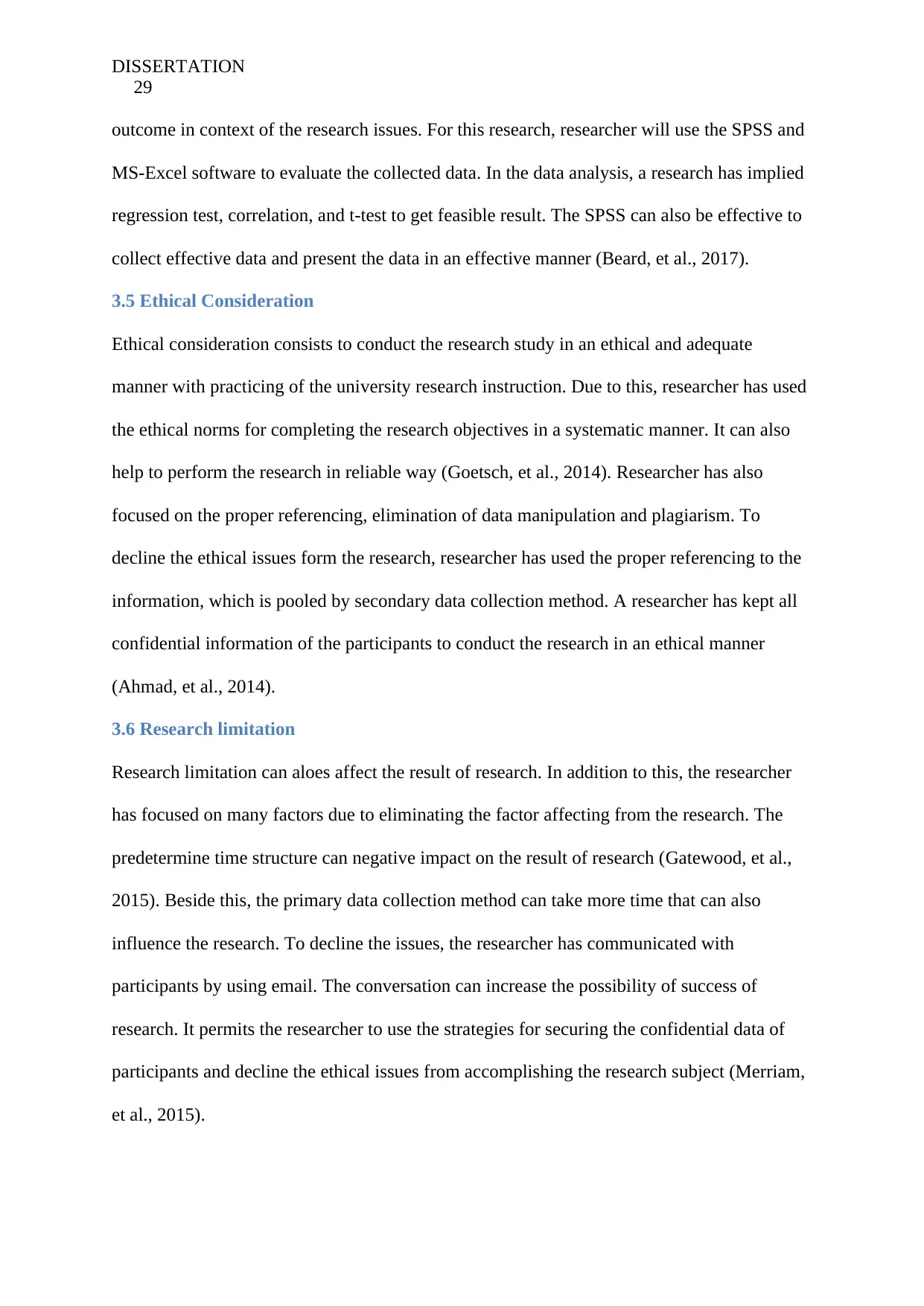
DISSERTATION
29
outcome in context of the research issues. For this research, researcher will use the SPSS and
MS-Excel software to evaluate the collected data. In the data analysis, a research has implied
regression test, correlation, and t-test to get feasible result. The SPSS can also be effective to
collect effective data and present the data in an effective manner (Beard, et al., 2017).
3.5 Ethical Consideration
Ethical consideration consists to conduct the research study in an ethical and adequate
manner with practicing of the university research instruction. Due to this, researcher has used
the ethical norms for completing the research objectives in a systematic manner. It can also
help to perform the research in reliable way (Goetsch, et al., 2014). Researcher has also
focused on the proper referencing, elimination of data manipulation and plagiarism. To
decline the ethical issues form the research, researcher has used the proper referencing to the
information, which is pooled by secondary data collection method. A researcher has kept all
confidential information of the participants to conduct the research in an ethical manner
(Ahmad, et al., 2014).
3.6 Research limitation
Research limitation can aloes affect the result of research. In addition to this, the researcher
has focused on many factors due to eliminating the factor affecting from the research. The
predetermine time structure can negative impact on the result of research (Gatewood, et al.,
2015). Beside this, the primary data collection method can take more time that can also
influence the research. To decline the issues, the researcher has communicated with
participants by using email. The conversation can increase the possibility of success of
research. It permits the researcher to use the strategies for securing the confidential data of
participants and decline the ethical issues from accomplishing the research subject (Merriam,
et al., 2015).
29
outcome in context of the research issues. For this research, researcher will use the SPSS and
MS-Excel software to evaluate the collected data. In the data analysis, a research has implied
regression test, correlation, and t-test to get feasible result. The SPSS can also be effective to
collect effective data and present the data in an effective manner (Beard, et al., 2017).
3.5 Ethical Consideration
Ethical consideration consists to conduct the research study in an ethical and adequate
manner with practicing of the university research instruction. Due to this, researcher has used
the ethical norms for completing the research objectives in a systematic manner. It can also
help to perform the research in reliable way (Goetsch, et al., 2014). Researcher has also
focused on the proper referencing, elimination of data manipulation and plagiarism. To
decline the ethical issues form the research, researcher has used the proper referencing to the
information, which is pooled by secondary data collection method. A researcher has kept all
confidential information of the participants to conduct the research in an ethical manner
(Ahmad, et al., 2014).
3.6 Research limitation
Research limitation can aloes affect the result of research. In addition to this, the researcher
has focused on many factors due to eliminating the factor affecting from the research. The
predetermine time structure can negative impact on the result of research (Gatewood, et al.,
2015). Beside this, the primary data collection method can take more time that can also
influence the research. To decline the issues, the researcher has communicated with
participants by using email. The conversation can increase the possibility of success of
research. It permits the researcher to use the strategies for securing the confidential data of
participants and decline the ethical issues from accomplishing the research subject (Merriam,
et al., 2015).
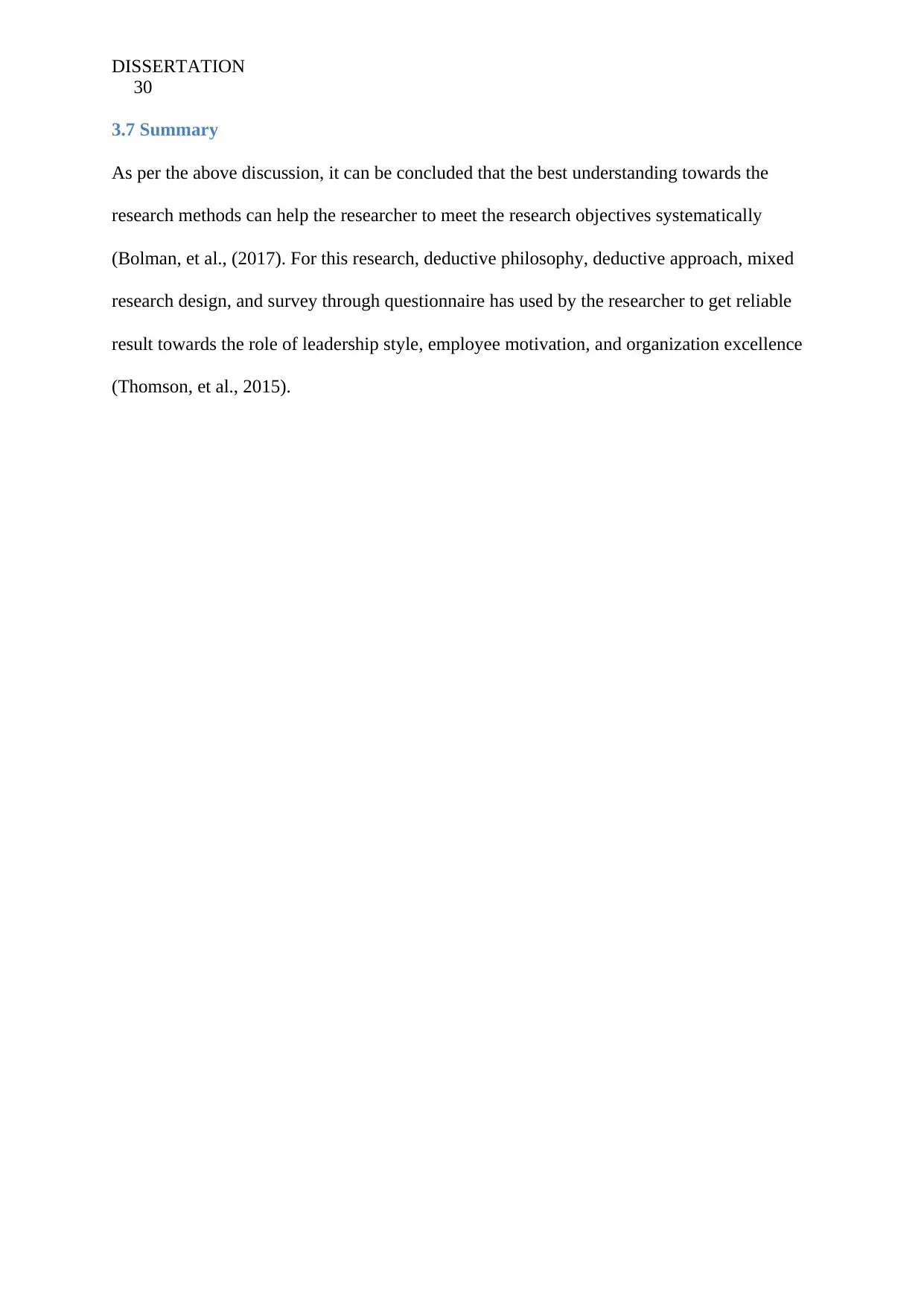
DISSERTATION
30
3.7 Summary
As per the above discussion, it can be concluded that the best understanding towards the
research methods can help the researcher to meet the research objectives systematically
(Bolman, et al., (2017). For this research, deductive philosophy, deductive approach, mixed
research design, and survey through questionnaire has used by the researcher to get reliable
result towards the role of leadership style, employee motivation, and organization excellence
(Thomson, et al., 2015).
30
3.7 Summary
As per the above discussion, it can be concluded that the best understanding towards the
research methods can help the researcher to meet the research objectives systematically
(Bolman, et al., (2017). For this research, deductive philosophy, deductive approach, mixed
research design, and survey through questionnaire has used by the researcher to get reliable
result towards the role of leadership style, employee motivation, and organization excellence
(Thomson, et al., 2015).

DISSERTATION
31
CHAPTER 4: DATA ANALYSIS AND FINDINGS
I. Demographic information
50%50%
Gender
Male Female
From the above chart, it is analyzed that researcher has selected 50% male and 50% female
due to avoiding the biases from the research.
Under 23 23-39 39- 55 More 55
0
2
4
6
8
10
12
14
Age
Age
On behalf of the above pie chart, it can also be evaluated that 39-55 group of people have
selected as a participant because of creating depth understanding about the research.
31
CHAPTER 4: DATA ANALYSIS AND FINDINGS
I. Demographic information
50%50%
Gender
Male Female
From the above chart, it is analyzed that researcher has selected 50% male and 50% female
due to avoiding the biases from the research.
Under 23 23-39 39- 55 More 55
0
2
4
6
8
10
12
14
Age
Age
On behalf of the above pie chart, it can also be evaluated that 39-55 group of people have
selected as a participant because of creating depth understanding about the research.
Paraphrase This Document
Need a fresh take? Get an instant paraphrase of this document with our AI Paraphraser
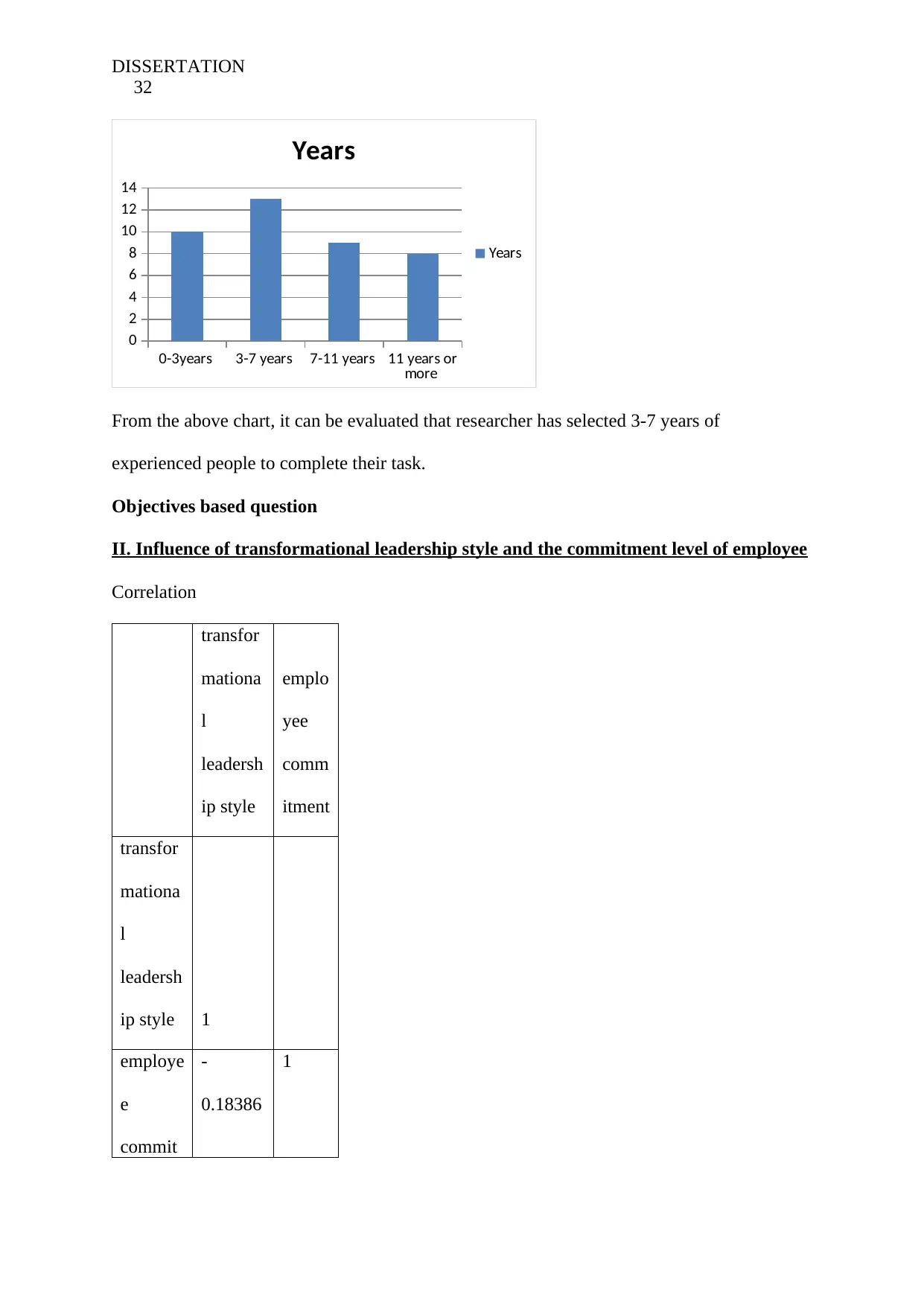
DISSERTATION
32
0-3years 3-7 years 7-11 years 11 years or
more
0
2
4
6
8
10
12
14
Years
Years
From the above chart, it can be evaluated that researcher has selected 3-7 years of
experienced people to complete their task.
Objectives based question
II. Influence of transformational leadership style and the commitment level of employee
Correlation
transfor
mationa
l
leadersh
ip style
emplo
yee
comm
itment
transfor
mationa
l
leadersh
ip style 1
employe
e
commit
-
0.18386
1
32
0-3years 3-7 years 7-11 years 11 years or
more
0
2
4
6
8
10
12
14
Years
Years
From the above chart, it can be evaluated that researcher has selected 3-7 years of
experienced people to complete their task.
Objectives based question
II. Influence of transformational leadership style and the commitment level of employee
Correlation
transfor
mationa
l
leadersh
ip style
emplo
yee
comm
itment
transfor
mationa
l
leadersh
ip style 1
employe
e
commit
-
0.18386
1
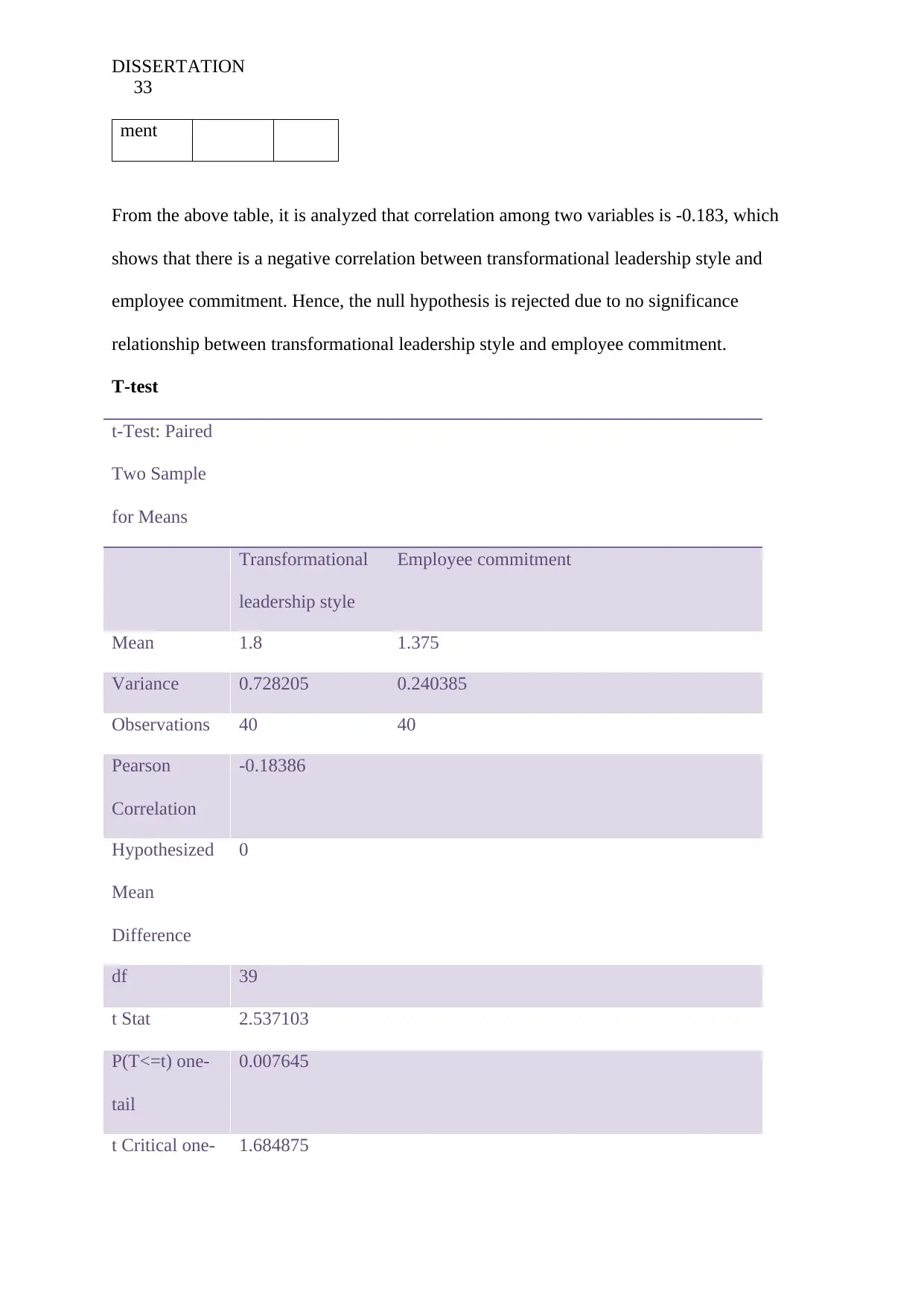
DISSERTATION
33
ment
From the above table, it is analyzed that correlation among two variables is -0.183, which
shows that there is a negative correlation between transformational leadership style and
employee commitment. Hence, the null hypothesis is rejected due to no significance
relationship between transformational leadership style and employee commitment.
T-test
t-Test: Paired
Two Sample
for Means
Transformational
leadership style
Employee commitment
Mean 1.8 1.375
Variance 0.728205 0.240385
Observations 40 40
Pearson
Correlation
-0.18386
Hypothesized
Mean
Difference
0
df 39
t Stat 2.537103
P(T<=t) one-
tail
0.007645
t Critical one- 1.684875
33
ment
From the above table, it is analyzed that correlation among two variables is -0.183, which
shows that there is a negative correlation between transformational leadership style and
employee commitment. Hence, the null hypothesis is rejected due to no significance
relationship between transformational leadership style and employee commitment.
T-test
t-Test: Paired
Two Sample
for Means
Transformational
leadership style
Employee commitment
Mean 1.8 1.375
Variance 0.728205 0.240385
Observations 40 40
Pearson
Correlation
-0.18386
Hypothesized
Mean
Difference
0
df 39
t Stat 2.537103
P(T<=t) one-
tail
0.007645
t Critical one- 1.684875
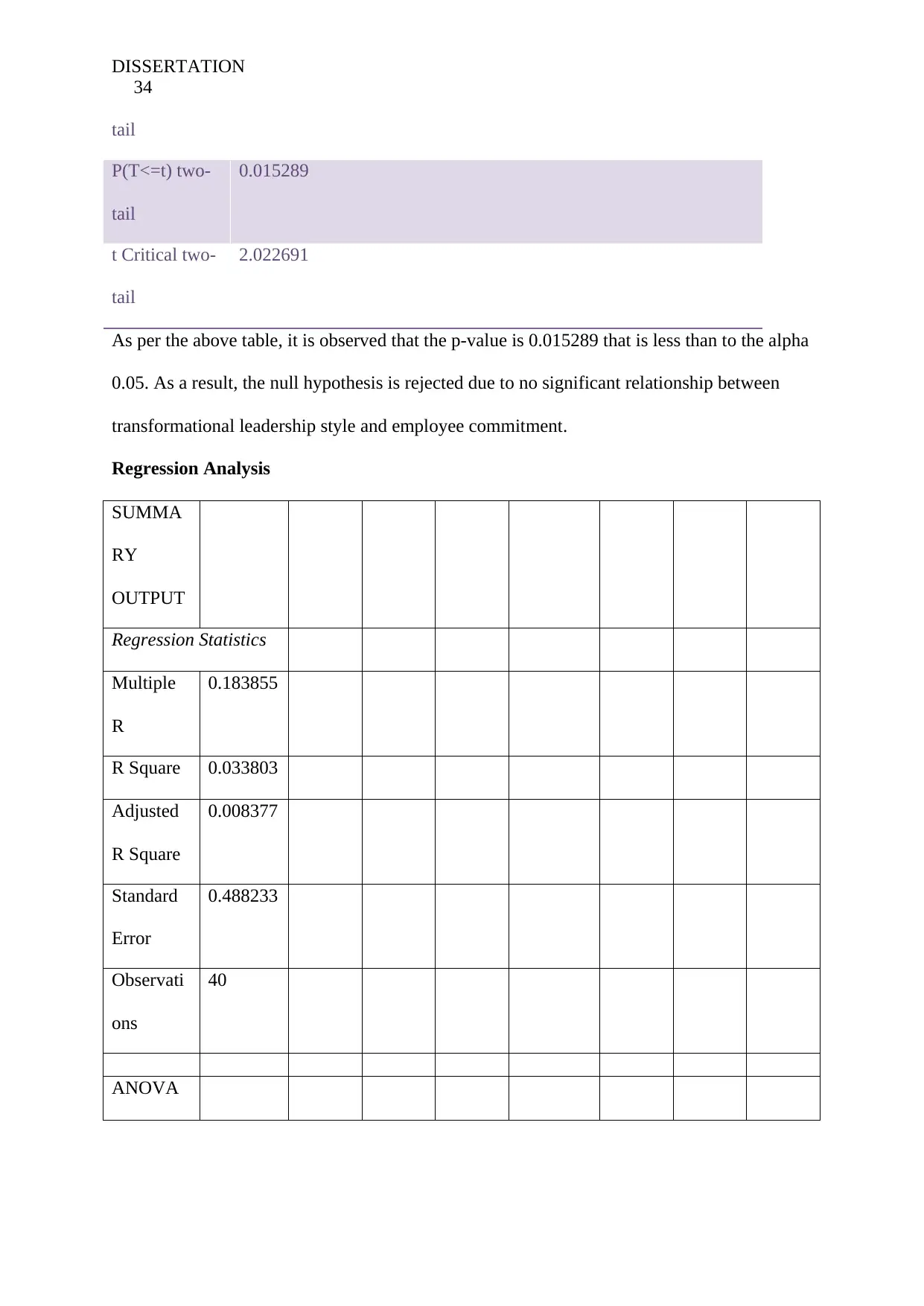
DISSERTATION
34
tail
P(T<=t) two-
tail
0.015289
t Critical two-
tail
2.022691
As per the above table, it is observed that the p-value is 0.015289 that is less than to the alpha
0.05. As a result, the null hypothesis is rejected due to no significant relationship between
transformational leadership style and employee commitment.
Regression Analysis
SUMMA
RY
OUTPUT
Regression Statistics
Multiple
R
0.183855
R Square 0.033803
Adjusted
R Square
0.008377
Standard
Error
0.488233
Observati
ons
40
ANOVA
34
tail
P(T<=t) two-
tail
0.015289
t Critical two-
tail
2.022691
As per the above table, it is observed that the p-value is 0.015289 that is less than to the alpha
0.05. As a result, the null hypothesis is rejected due to no significant relationship between
transformational leadership style and employee commitment.
Regression Analysis
SUMMA
RY
OUTPUT
Regression Statistics
Multiple
R
0.183855
R Square 0.033803
Adjusted
R Square
0.008377
Standard
Error
0.488233
Observati
ons
40
ANOVA
Secure Best Marks with AI Grader
Need help grading? Try our AI Grader for instant feedback on your assignments.
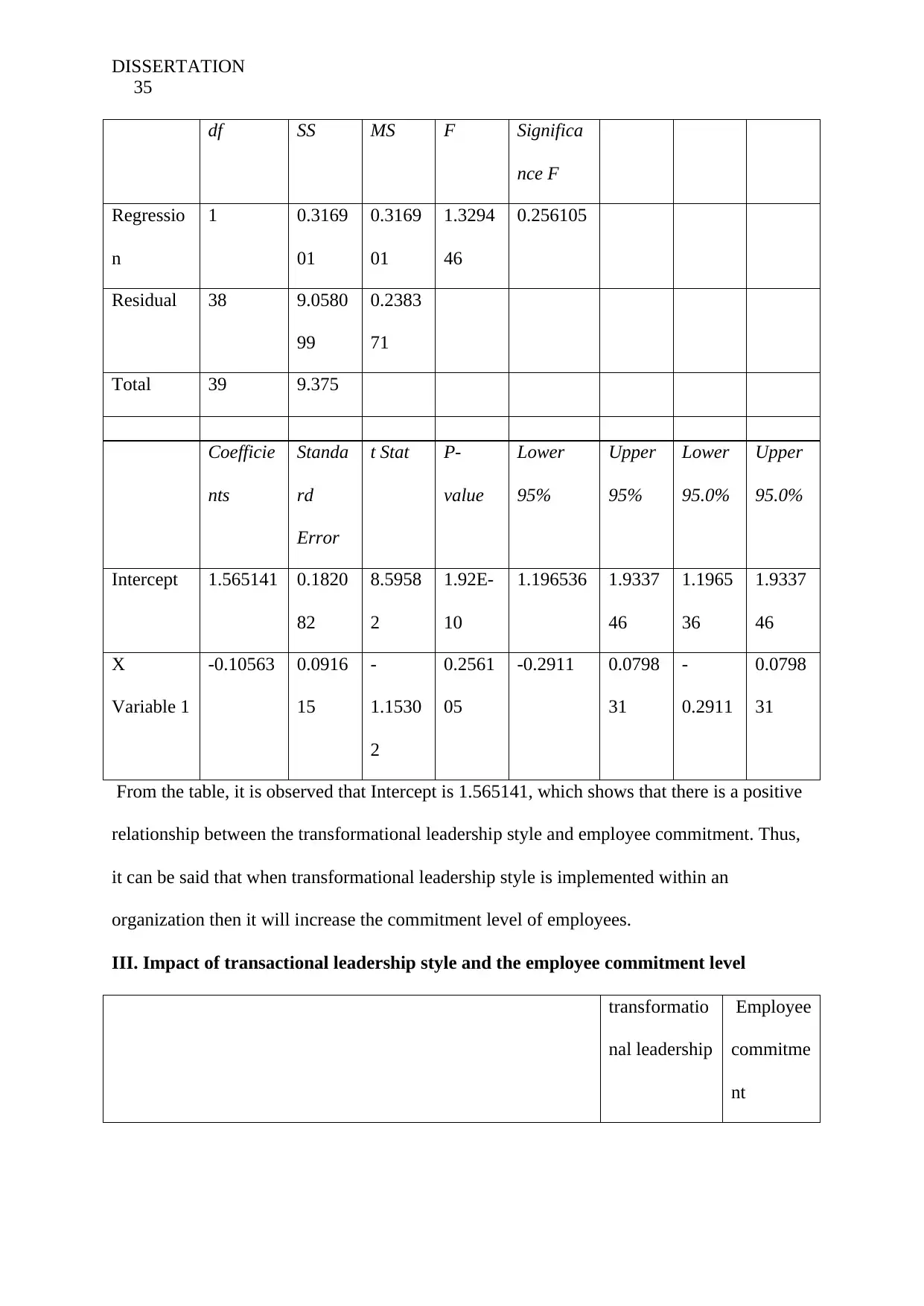
DISSERTATION
35
df SS MS F Significa
nce F
Regressio
n
1 0.3169
01
0.3169
01
1.3294
46
0.256105
Residual 38 9.0580
99
0.2383
71
Total 39 9.375
Coefficie
nts
Standa
rd
Error
t Stat P-
value
Lower
95%
Upper
95%
Lower
95.0%
Upper
95.0%
Intercept 1.565141 0.1820
82
8.5958
2
1.92E-
10
1.196536 1.9337
46
1.1965
36
1.9337
46
X
Variable 1
-0.10563 0.0916
15
-
1.1530
2
0.2561
05
-0.2911 0.0798
31
-
0.2911
0.0798
31
From the table, it is observed that Intercept is 1.565141, which shows that there is a positive
relationship between the transformational leadership style and employee commitment. Thus,
it can be said that when transformational leadership style is implemented within an
organization then it will increase the commitment level of employees.
III. Impact of transactional leadership style and the employee commitment level
transformatio
nal leadership
Employee
commitme
nt
35
df SS MS F Significa
nce F
Regressio
n
1 0.3169
01
0.3169
01
1.3294
46
0.256105
Residual 38 9.0580
99
0.2383
71
Total 39 9.375
Coefficie
nts
Standa
rd
Error
t Stat P-
value
Lower
95%
Upper
95%
Lower
95.0%
Upper
95.0%
Intercept 1.565141 0.1820
82
8.5958
2
1.92E-
10
1.196536 1.9337
46
1.1965
36
1.9337
46
X
Variable 1
-0.10563 0.0916
15
-
1.1530
2
0.2561
05
-0.2911 0.0798
31
-
0.2911
0.0798
31
From the table, it is observed that Intercept is 1.565141, which shows that there is a positive
relationship between the transformational leadership style and employee commitment. Thus,
it can be said that when transformational leadership style is implemented within an
organization then it will increase the commitment level of employees.
III. Impact of transactional leadership style and the employee commitment level
transformatio
nal leadership
Employee
commitme
nt
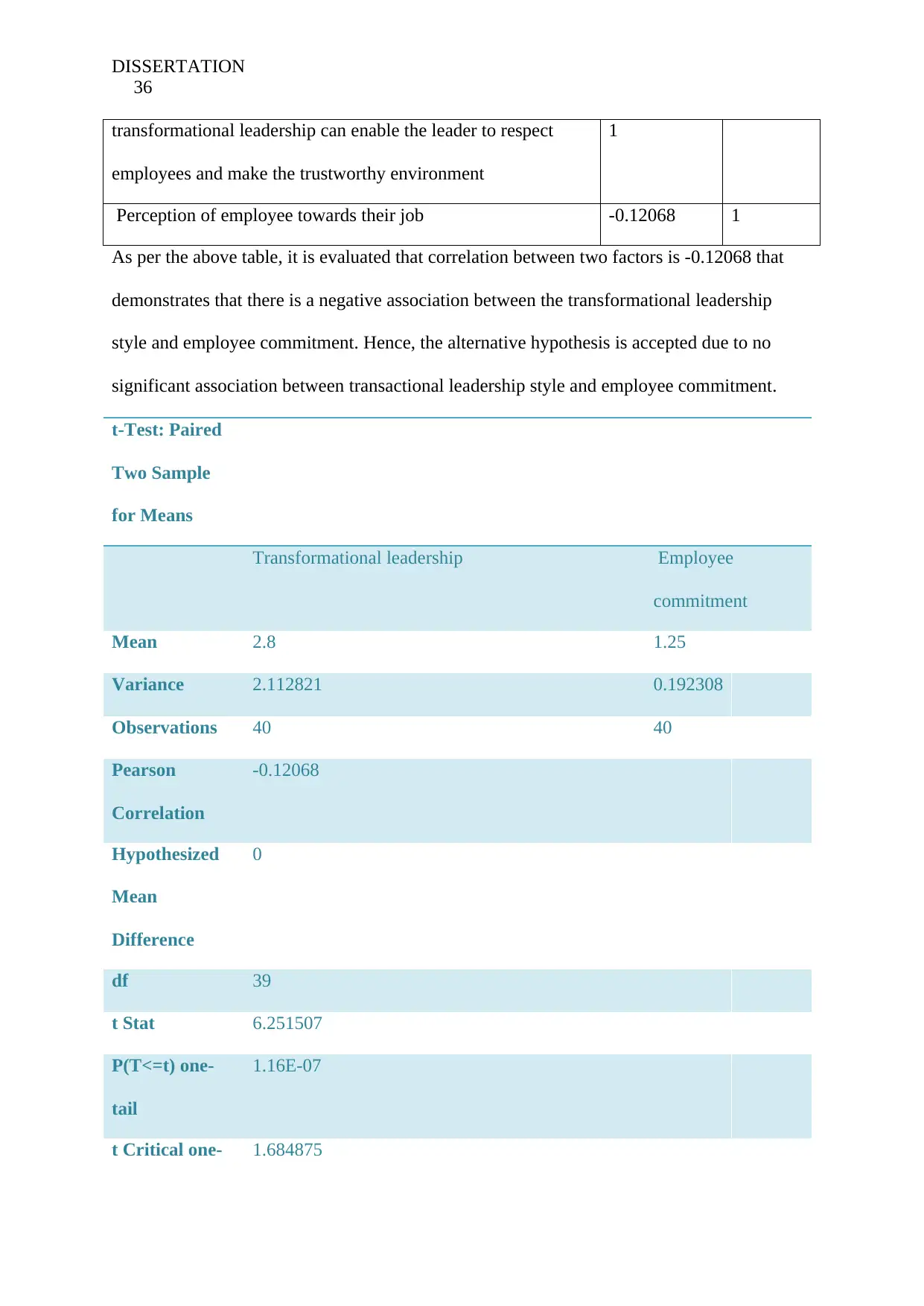
DISSERTATION
36
transformational leadership can enable the leader to respect
employees and make the trustworthy environment
1
Perception of employee towards their job -0.12068 1
As per the above table, it is evaluated that correlation between two factors is -0.12068 that
demonstrates that there is a negative association between the transformational leadership
style and employee commitment. Hence, the alternative hypothesis is accepted due to no
significant association between transactional leadership style and employee commitment.
t-Test: Paired
Two Sample
for Means
Transformational leadership Employee
commitment
Mean 2.8 1.25
Variance 2.112821 0.192308
Observations 40 40
Pearson
Correlation
-0.12068
Hypothesized
Mean
Difference
0
df 39
t Stat 6.251507
P(T<=t) one-
tail
1.16E-07
t Critical one- 1.684875
36
transformational leadership can enable the leader to respect
employees and make the trustworthy environment
1
Perception of employee towards their job -0.12068 1
As per the above table, it is evaluated that correlation between two factors is -0.12068 that
demonstrates that there is a negative association between the transformational leadership
style and employee commitment. Hence, the alternative hypothesis is accepted due to no
significant association between transactional leadership style and employee commitment.
t-Test: Paired
Two Sample
for Means
Transformational leadership Employee
commitment
Mean 2.8 1.25
Variance 2.112821 0.192308
Observations 40 40
Pearson
Correlation
-0.12068
Hypothesized
Mean
Difference
0
df 39
t Stat 6.251507
P(T<=t) one-
tail
1.16E-07
t Critical one- 1.684875
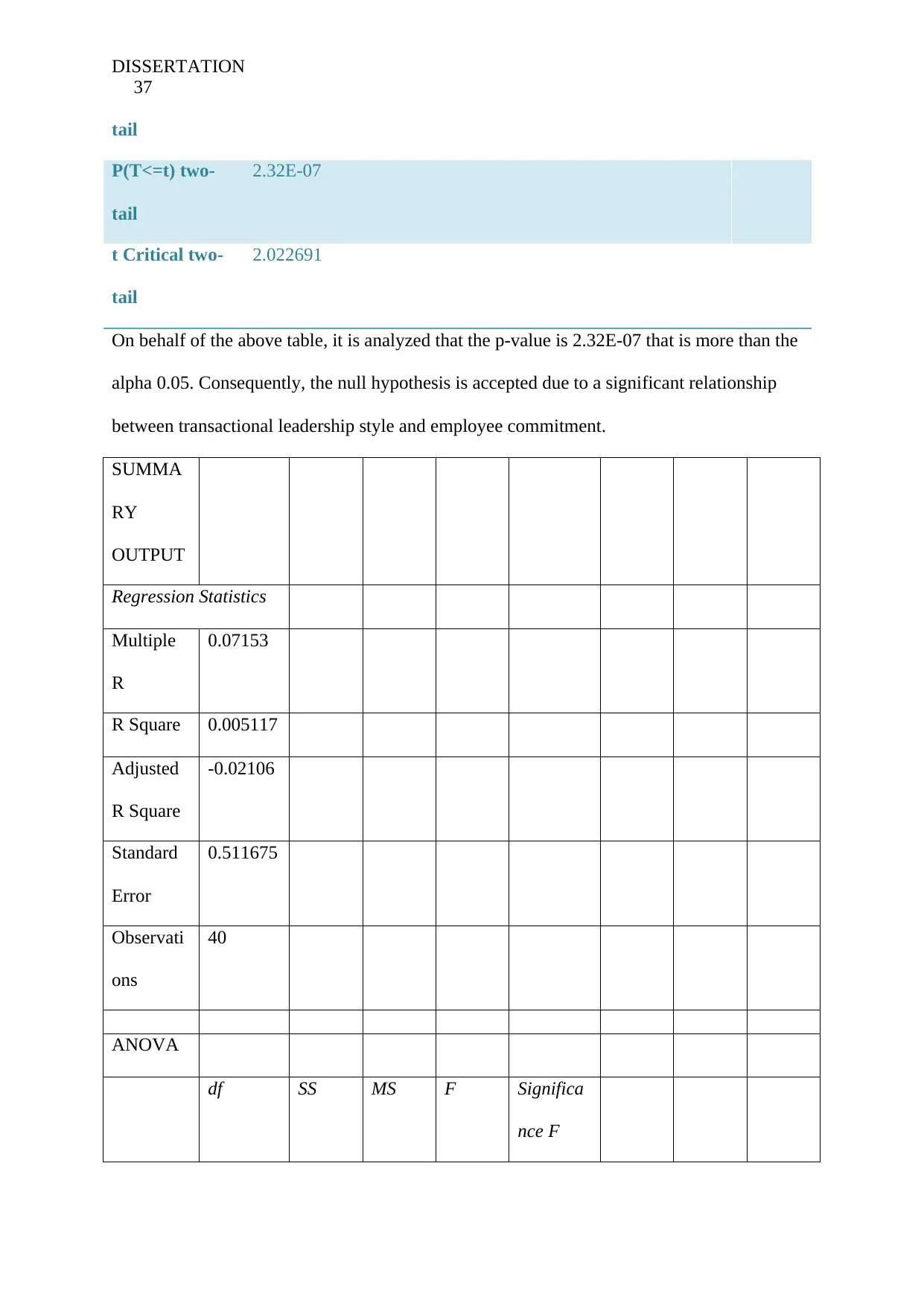
DISSERTATION
37
tail
P(T<=t) two-
tail
2.32E-07
t Critical two-
tail
2.022691
On behalf of the above table, it is analyzed that the p-value is 2.32E-07 that is more than the
alpha 0.05. Consequently, the null hypothesis is accepted due to a significant relationship
between transactional leadership style and employee commitment.
SUMMA
RY
OUTPUT
Regression Statistics
Multiple
R
0.07153
R Square 0.005117
Adjusted
R Square
-0.02106
Standard
Error
0.511675
Observati
ons
40
ANOVA
df SS MS F Significa
nce F
37
tail
P(T<=t) two-
tail
2.32E-07
t Critical two-
tail
2.022691
On behalf of the above table, it is analyzed that the p-value is 2.32E-07 that is more than the
alpha 0.05. Consequently, the null hypothesis is accepted due to a significant relationship
between transactional leadership style and employee commitment.
SUMMA
RY
OUTPUT
Regression Statistics
Multiple
R
0.07153
R Square 0.005117
Adjusted
R Square
-0.02106
Standard
Error
0.511675
Observati
ons
40
ANOVA
df SS MS F Significa
nce F
Paraphrase This Document
Need a fresh take? Get an instant paraphrase of this document with our AI Paraphraser
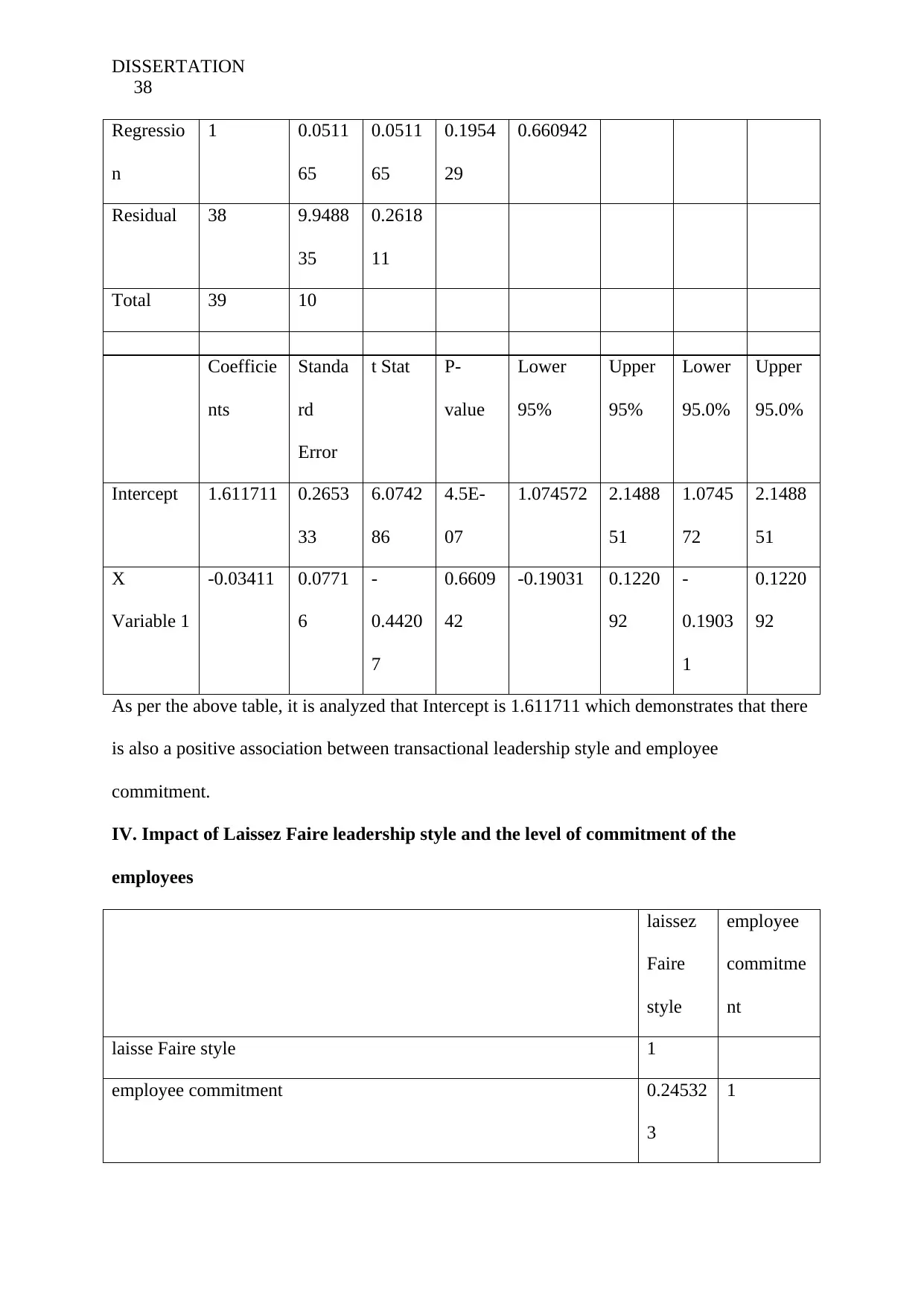
DISSERTATION
38
Regressio
n
1 0.0511
65
0.0511
65
0.1954
29
0.660942
Residual 38 9.9488
35
0.2618
11
Total 39 10
Coefficie
nts
Standa
rd
Error
t Stat P-
value
Lower
95%
Upper
95%
Lower
95.0%
Upper
95.0%
Intercept 1.611711 0.2653
33
6.0742
86
4.5E-
07
1.074572 2.1488
51
1.0745
72
2.1488
51
X
Variable 1
-0.03411 0.0771
6
-
0.4420
7
0.6609
42
-0.19031 0.1220
92
-
0.1903
1
0.1220
92
As per the above table, it is analyzed that Intercept is 1.611711 which demonstrates that there
is also a positive association between transactional leadership style and employee
commitment.
IV. Impact of Laissez Faire leadership style and the level of commitment of the
employees
laissez
Faire
style
employee
commitme
nt
laisse Faire style 1
employee commitment 0.24532
3
1
38
Regressio
n
1 0.0511
65
0.0511
65
0.1954
29
0.660942
Residual 38 9.9488
35
0.2618
11
Total 39 10
Coefficie
nts
Standa
rd
Error
t Stat P-
value
Lower
95%
Upper
95%
Lower
95.0%
Upper
95.0%
Intercept 1.611711 0.2653
33
6.0742
86
4.5E-
07
1.074572 2.1488
51
1.0745
72
2.1488
51
X
Variable 1
-0.03411 0.0771
6
-
0.4420
7
0.6609
42
-0.19031 0.1220
92
-
0.1903
1
0.1220
92
As per the above table, it is analyzed that Intercept is 1.611711 which demonstrates that there
is also a positive association between transactional leadership style and employee
commitment.
IV. Impact of Laissez Faire leadership style and the level of commitment of the
employees
laissez
Faire
style
employee
commitme
nt
laisse Faire style 1
employee commitment 0.24532
3
1

DISSERTATION
39
As per the above table, it can be examined that correlation between two variables is 0.245323
that shows that there is a positive relationship between the laissez-faire style and employee
commitment. Hence, the null hypothesis is accepted due to significance relationship between
laissez Faire style and employee commitment.
39
As per the above table, it can be examined that correlation between two variables is 0.245323
that shows that there is a positive relationship between the laissez-faire style and employee
commitment. Hence, the null hypothesis is accepted due to significance relationship between
laissez Faire style and employee commitment.
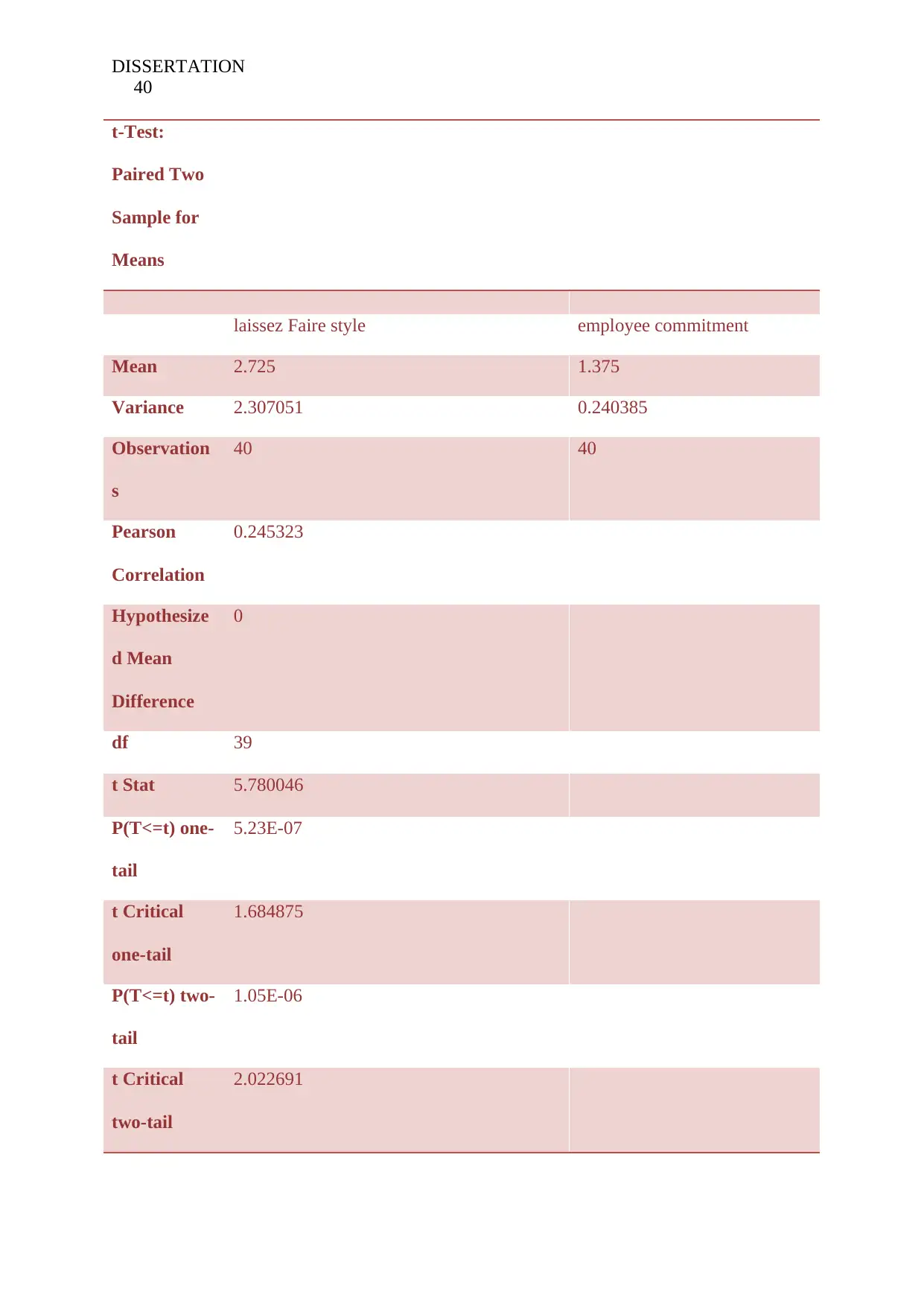
DISSERTATION
40
t-Test:
Paired Two
Sample for
Means
laissez Faire style employee commitment
Mean 2.725 1.375
Variance 2.307051 0.240385
Observation
s
40 40
Pearson
Correlation
0.245323
Hypothesize
d Mean
Difference
0
df 39
t Stat 5.780046
P(T<=t) one-
tail
5.23E-07
t Critical
one-tail
1.684875
P(T<=t) two-
tail
1.05E-06
t Critical
two-tail
2.022691
40
t-Test:
Paired Two
Sample for
Means
laissez Faire style employee commitment
Mean 2.725 1.375
Variance 2.307051 0.240385
Observation
s
40 40
Pearson
Correlation
0.245323
Hypothesize
d Mean
Difference
0
df 39
t Stat 5.780046
P(T<=t) one-
tail
5.23E-07
t Critical
one-tail
1.684875
P(T<=t) two-
tail
1.05E-06
t Critical
two-tail
2.022691
Secure Best Marks with AI Grader
Need help grading? Try our AI Grader for instant feedback on your assignments.
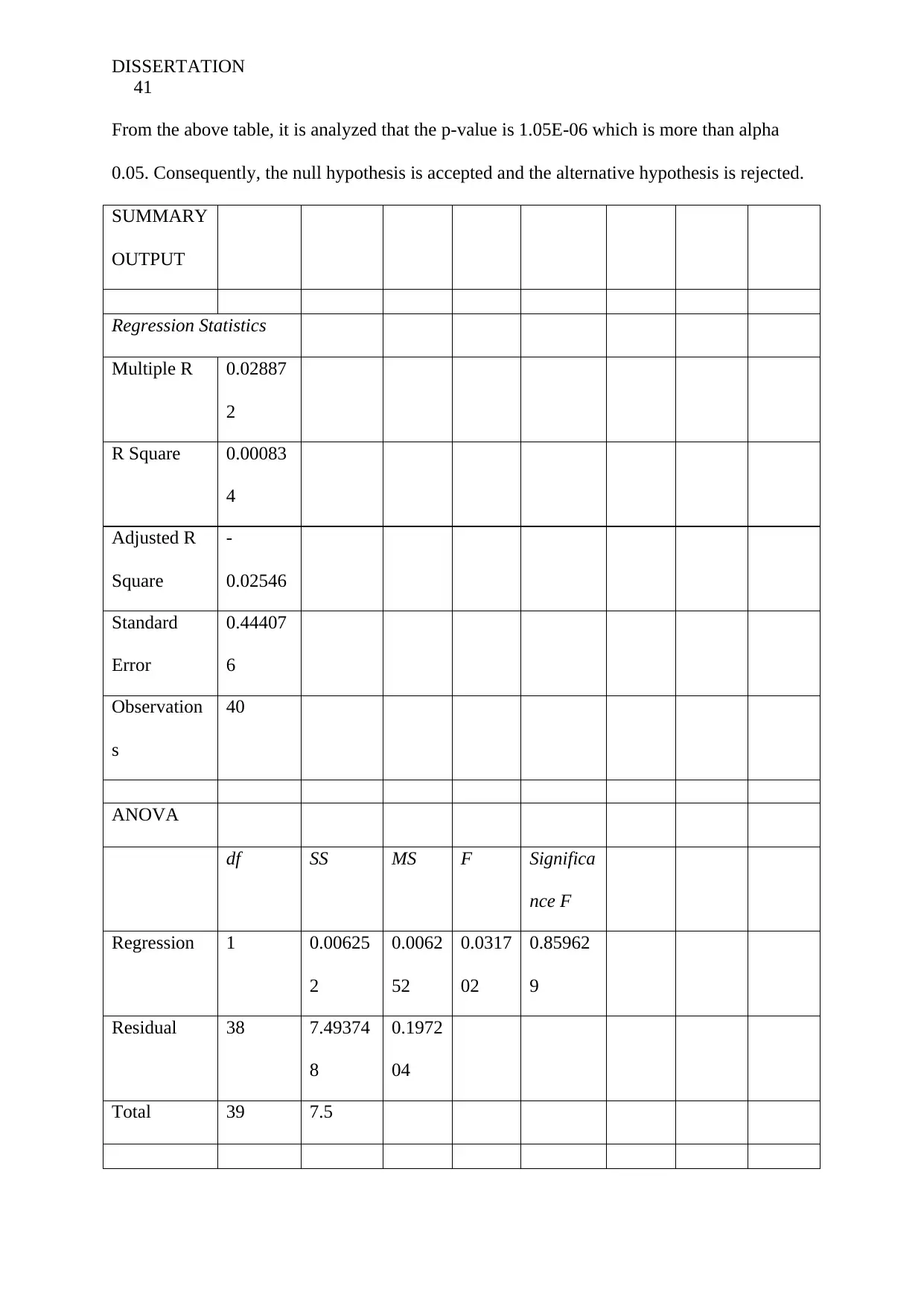
DISSERTATION
41
From the above table, it is analyzed that the p-value is 1.05E-06 which is more than alpha
0.05. Consequently, the null hypothesis is accepted and the alternative hypothesis is rejected.
SUMMARY
OUTPUT
Regression Statistics
Multiple R 0.02887
2
R Square 0.00083
4
Adjusted R
Square
-
0.02546
Standard
Error
0.44407
6
Observation
s
40
ANOVA
df SS MS F Significa
nce F
Regression 1 0.00625
2
0.0062
52
0.0317
02
0.85962
9
Residual 38 7.49374
8
0.1972
04
Total 39 7.5
41
From the above table, it is analyzed that the p-value is 1.05E-06 which is more than alpha
0.05. Consequently, the null hypothesis is accepted and the alternative hypothesis is rejected.
SUMMARY
OUTPUT
Regression Statistics
Multiple R 0.02887
2
R Square 0.00083
4
Adjusted R
Square
-
0.02546
Standard
Error
0.44407
6
Observation
s
40
ANOVA
df SS MS F Significa
nce F
Regression 1 0.00625
2
0.0062
52
0.0317
02
0.85962
9
Residual 38 7.49374
8
0.1972
04
Total 39 7.5

DISSERTATION
42
Coeffici
ents
Standar
d Error
t Stat P-
value
Lower
95%
Upper
95%
Lower
95.0%
Upper
95.0%
Intercept 1.22728
5
0.14562 8.4279
75
3.16E-
10
0.93249
2
1.5220
79
0.9324
92
1.5220
79
X Variable 1 0.00833
6
0.04681
6
0.1780
5
0.8596
29
-0.08644 0.1031
1
-
0.0864
4
0.1031
1
From the above table, it is observed that the intercept is 1.227285 which means there is a
favorable relationship between transformational leadership style and employee commitment.
Hence, it is analyzed that the implementation of transformation leadership style can affect the
employee commitment level.
V. Impact of the transformational leadership style and the motivation of employees
transformatio
nal leadership
Employe
e
motivati
on
transformational leadership 1
Employee motivation 0.070775 1
As per the above table, it is analyzed that correlation among two variables is 0.070775, which
shows that there is a positive relationship between transformational leadership style and
employee motivation. Hence, the null hypothesis is accepted due to a significant association
between the transformational leadership style and employee motivation.
t-Test:
Paired Two
Sample for
42
Coeffici
ents
Standar
d Error
t Stat P-
value
Lower
95%
Upper
95%
Lower
95.0%
Upper
95.0%
Intercept 1.22728
5
0.14562 8.4279
75
3.16E-
10
0.93249
2
1.5220
79
0.9324
92
1.5220
79
X Variable 1 0.00833
6
0.04681
6
0.1780
5
0.8596
29
-0.08644 0.1031
1
-
0.0864
4
0.1031
1
From the above table, it is observed that the intercept is 1.227285 which means there is a
favorable relationship between transformational leadership style and employee commitment.
Hence, it is analyzed that the implementation of transformation leadership style can affect the
employee commitment level.
V. Impact of the transformational leadership style and the motivation of employees
transformatio
nal leadership
Employe
e
motivati
on
transformational leadership 1
Employee motivation 0.070775 1
As per the above table, it is analyzed that correlation among two variables is 0.070775, which
shows that there is a positive relationship between transformational leadership style and
employee motivation. Hence, the null hypothesis is accepted due to a significant association
between the transformational leadership style and employee motivation.
t-Test:
Paired Two
Sample for
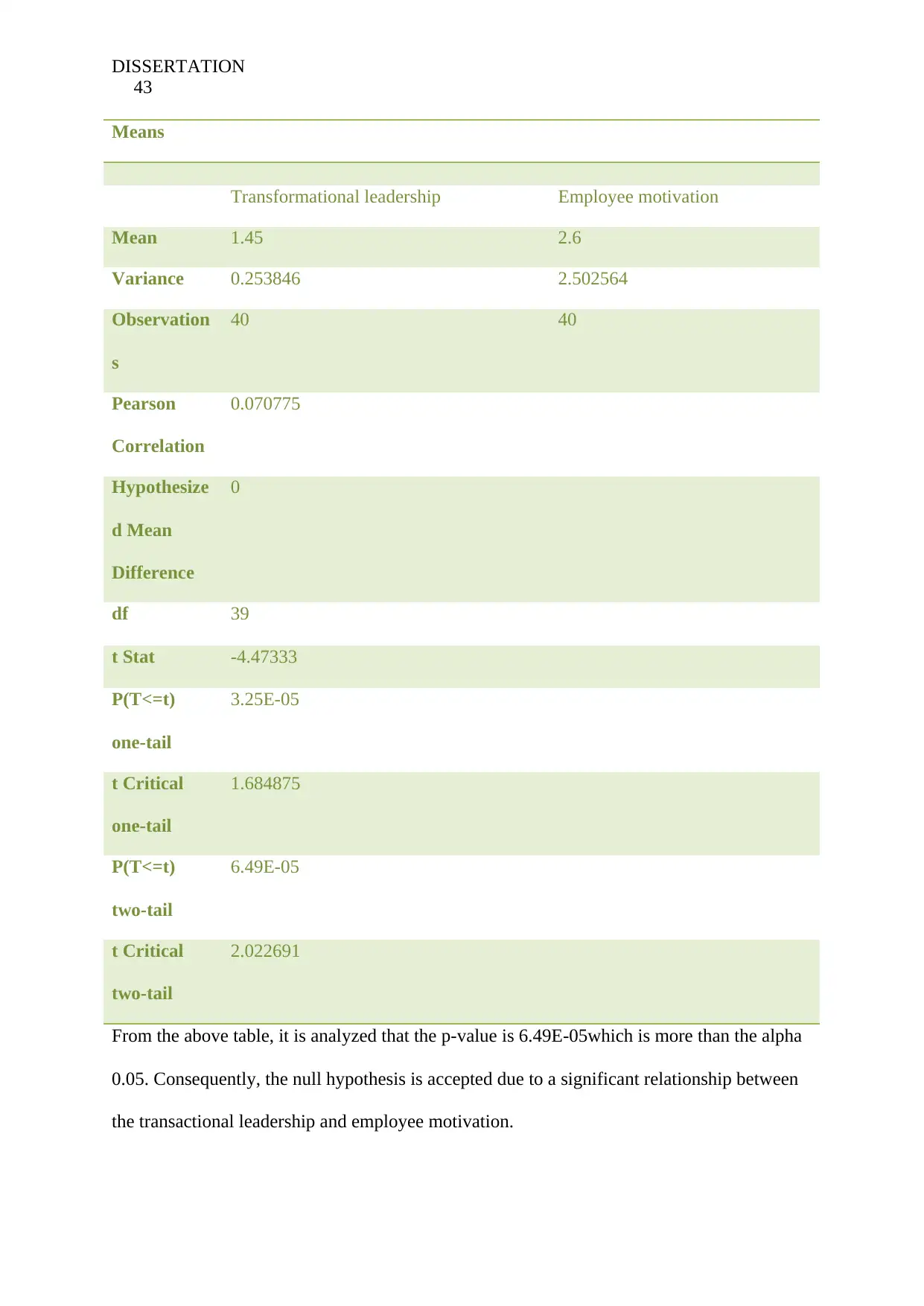
DISSERTATION
43
Means
Transformational leadership Employee motivation
Mean 1.45 2.6
Variance 0.253846 2.502564
Observation
s
40 40
Pearson
Correlation
0.070775
Hypothesize
d Mean
Difference
0
df 39
t Stat -4.47333
P(T<=t)
one-tail
3.25E-05
t Critical
one-tail
1.684875
P(T<=t)
two-tail
6.49E-05
t Critical
two-tail
2.022691
From the above table, it is analyzed that the p-value is 6.49E-05which is more than the alpha
0.05. Consequently, the null hypothesis is accepted due to a significant relationship between
the transactional leadership and employee motivation.
43
Means
Transformational leadership Employee motivation
Mean 1.45 2.6
Variance 0.253846 2.502564
Observation
s
40 40
Pearson
Correlation
0.070775
Hypothesize
d Mean
Difference
0
df 39
t Stat -4.47333
P(T<=t)
one-tail
3.25E-05
t Critical
one-tail
1.684875
P(T<=t)
two-tail
6.49E-05
t Critical
two-tail
2.022691
From the above table, it is analyzed that the p-value is 6.49E-05which is more than the alpha
0.05. Consequently, the null hypothesis is accepted due to a significant relationship between
the transactional leadership and employee motivation.
Paraphrase This Document
Need a fresh take? Get an instant paraphrase of this document with our AI Paraphraser
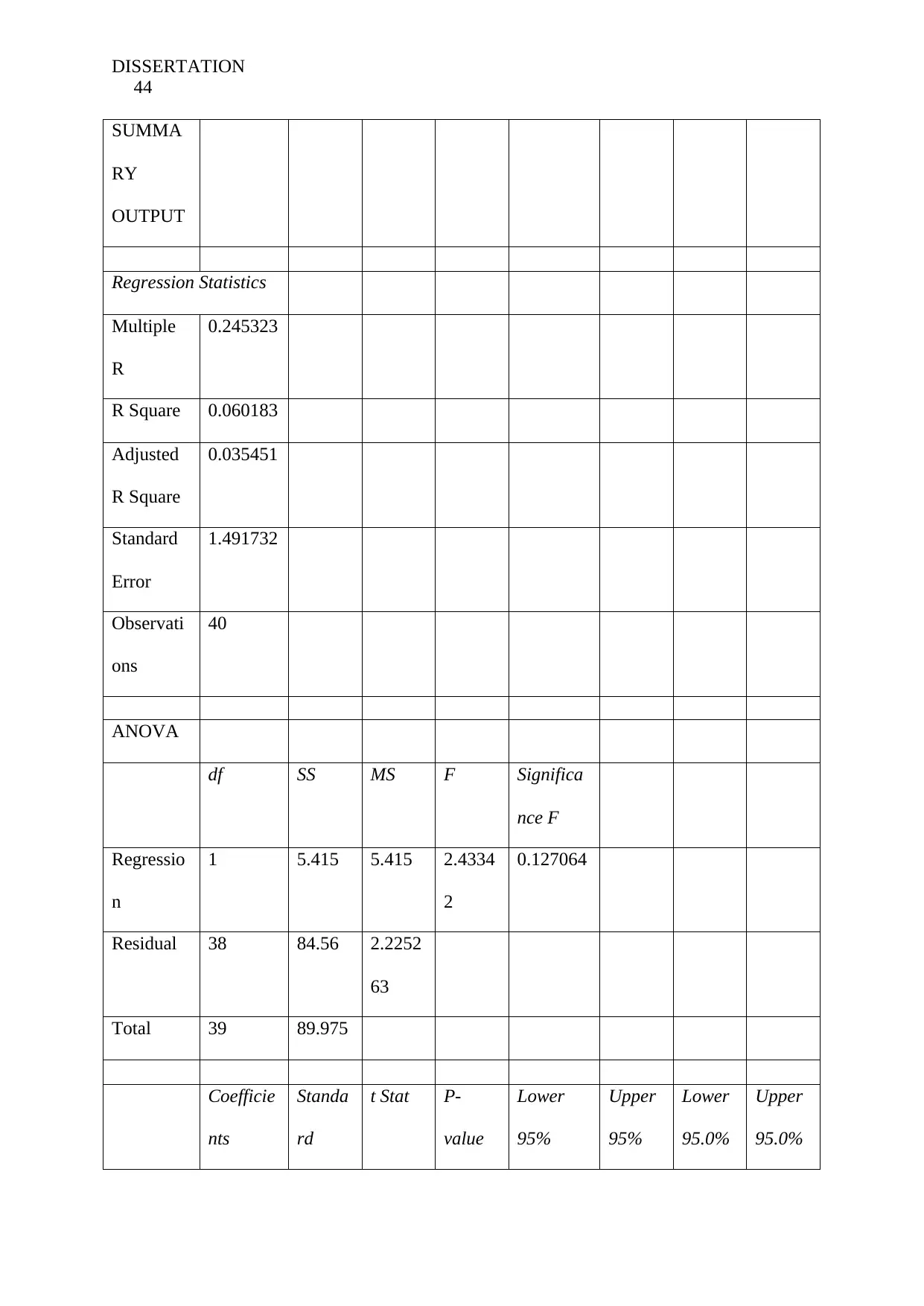
DISSERTATION
44
SUMMA
RY
OUTPUT
Regression Statistics
Multiple
R
0.245323
R Square 0.060183
Adjusted
R Square
0.035451
Standard
Error
1.491732
Observati
ons
40
ANOVA
df SS MS F Significa
nce F
Regressio
n
1 5.415 5.415 2.4334
2
0.127064
Residual 38 84.56 2.2252
63
Total 39 89.975
Coefficie
nts
Standa
rd
t Stat P-
value
Lower
95%
Upper
95%
Lower
95.0%
Upper
95.0%
44
SUMMA
RY
OUTPUT
Regression Statistics
Multiple
R
0.245323
R Square 0.060183
Adjusted
R Square
0.035451
Standard
Error
1.491732
Observati
ons
40
ANOVA
df SS MS F Significa
nce F
Regressio
n
1 5.415 5.415 2.4334
2
0.127064
Residual 38 84.56 2.2252
63
Total 39 89.975
Coefficie
nts
Standa
rd
t Stat P-
value
Lower
95%
Upper
95%
Lower
95.0%
Upper
95.0%
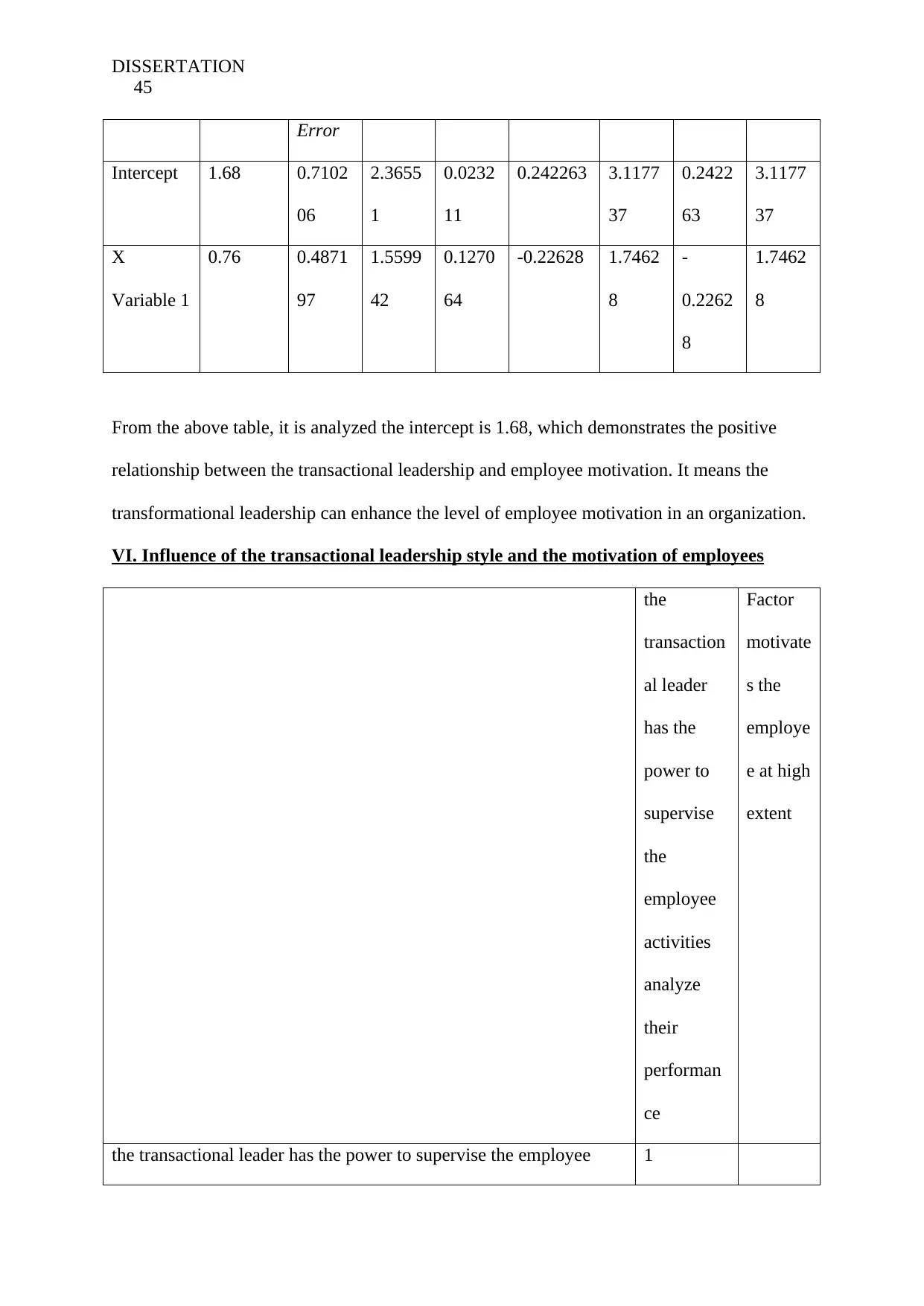
DISSERTATION
45
Error
Intercept 1.68 0.7102
06
2.3655
1
0.0232
11
0.242263 3.1177
37
0.2422
63
3.1177
37
X
Variable 1
0.76 0.4871
97
1.5599
42
0.1270
64
-0.22628 1.7462
8
-
0.2262
8
1.7462
8
From the above table, it is analyzed the intercept is 1.68, which demonstrates the positive
relationship between the transactional leadership and employee motivation. It means the
transformational leadership can enhance the level of employee motivation in an organization.
VI. Influence of the transactional leadership style and the motivation of employees
the
transaction
al leader
has the
power to
supervise
the
employee
activities
analyze
their
performan
ce
Factor
motivate
s the
employe
e at high
extent
the transactional leader has the power to supervise the employee 1
45
Error
Intercept 1.68 0.7102
06
2.3655
1
0.0232
11
0.242263 3.1177
37
0.2422
63
3.1177
37
X
Variable 1
0.76 0.4871
97
1.5599
42
0.1270
64
-0.22628 1.7462
8
-
0.2262
8
1.7462
8
From the above table, it is analyzed the intercept is 1.68, which demonstrates the positive
relationship between the transactional leadership and employee motivation. It means the
transformational leadership can enhance the level of employee motivation in an organization.
VI. Influence of the transactional leadership style and the motivation of employees
the
transaction
al leader
has the
power to
supervise
the
employee
activities
analyze
their
performan
ce
Factor
motivate
s the
employe
e at high
extent
the transactional leader has the power to supervise the employee 1
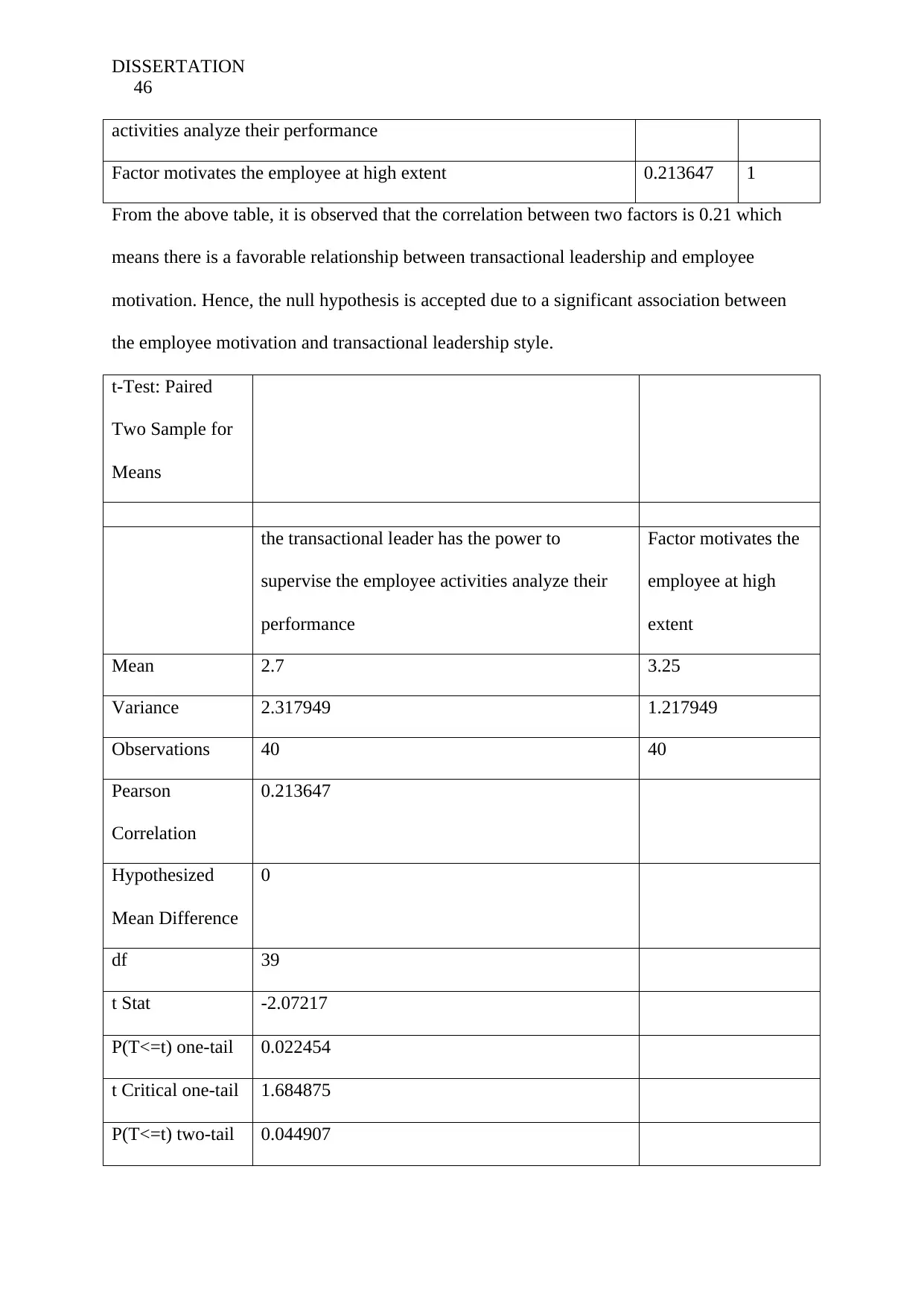
DISSERTATION
46
activities analyze their performance
Factor motivates the employee at high extent 0.213647 1
From the above table, it is observed that the correlation between two factors is 0.21 which
means there is a favorable relationship between transactional leadership and employee
motivation. Hence, the null hypothesis is accepted due to a significant association between
the employee motivation and transactional leadership style.
t-Test: Paired
Two Sample for
Means
the transactional leader has the power to
supervise the employee activities analyze their
performance
Factor motivates the
employee at high
extent
Mean 2.7 3.25
Variance 2.317949 1.217949
Observations 40 40
Pearson
Correlation
0.213647
Hypothesized
Mean Difference
0
df 39
t Stat -2.07217
P(T<=t) one-tail 0.022454
t Critical one-tail 1.684875
P(T<=t) two-tail 0.044907
46
activities analyze their performance
Factor motivates the employee at high extent 0.213647 1
From the above table, it is observed that the correlation between two factors is 0.21 which
means there is a favorable relationship between transactional leadership and employee
motivation. Hence, the null hypothesis is accepted due to a significant association between
the employee motivation and transactional leadership style.
t-Test: Paired
Two Sample for
Means
the transactional leader has the power to
supervise the employee activities analyze their
performance
Factor motivates the
employee at high
extent
Mean 2.7 3.25
Variance 2.317949 1.217949
Observations 40 40
Pearson
Correlation
0.213647
Hypothesized
Mean Difference
0
df 39
t Stat -2.07217
P(T<=t) one-tail 0.022454
t Critical one-tail 1.684875
P(T<=t) two-tail 0.044907
Secure Best Marks with AI Grader
Need help grading? Try our AI Grader for instant feedback on your assignments.
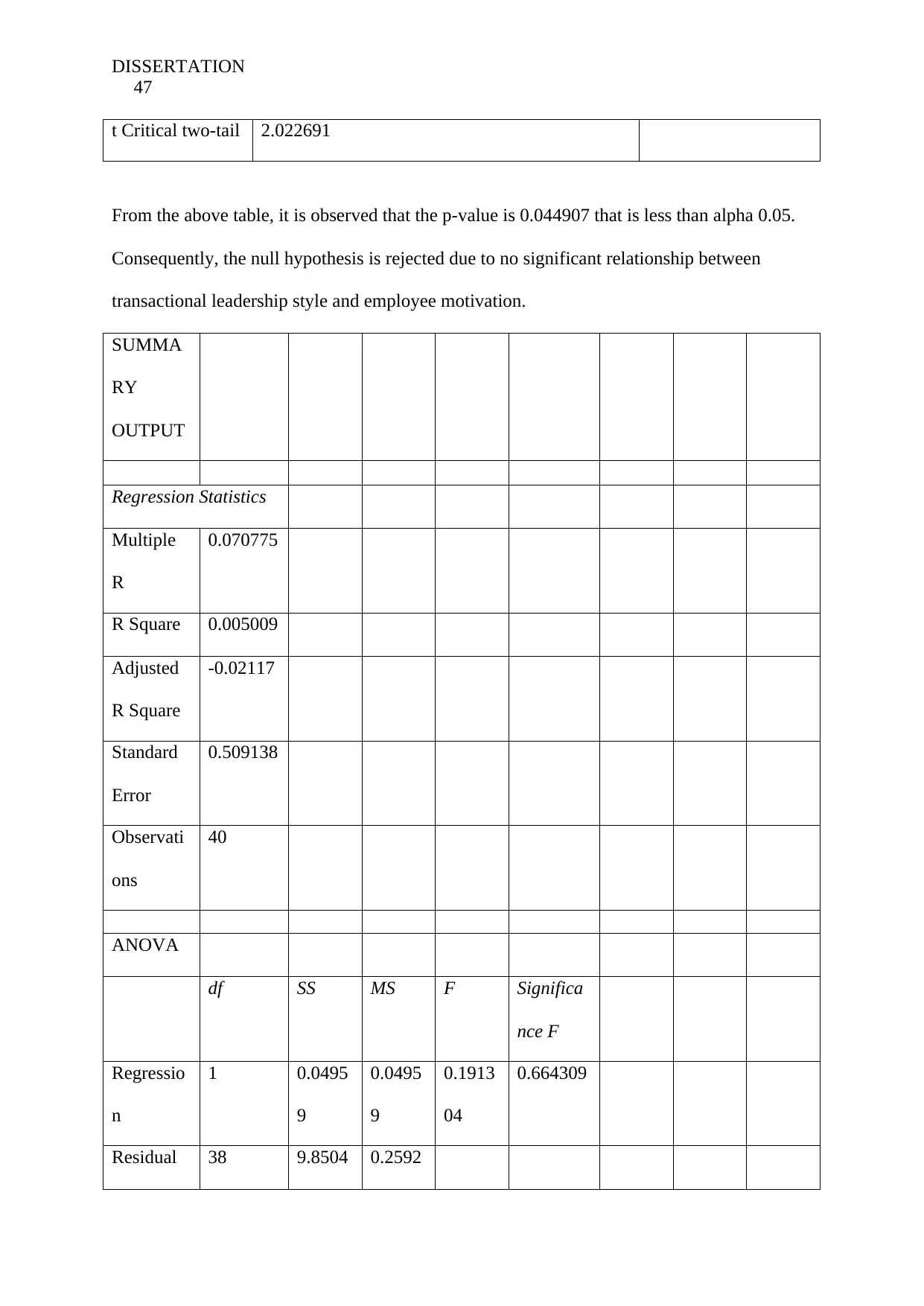
DISSERTATION
47
t Critical two-tail 2.022691
From the above table, it is observed that the p-value is 0.044907 that is less than alpha 0.05.
Consequently, the null hypothesis is rejected due to no significant relationship between
transactional leadership style and employee motivation.
SUMMA
RY
OUTPUT
Regression Statistics
Multiple
R
0.070775
R Square 0.005009
Adjusted
R Square
-0.02117
Standard
Error
0.509138
Observati
ons
40
ANOVA
df SS MS F Significa
nce F
Regressio
n
1 0.0495
9
0.0495
9
0.1913
04
0.664309
Residual 38 9.8504 0.2592
47
t Critical two-tail 2.022691
From the above table, it is observed that the p-value is 0.044907 that is less than alpha 0.05.
Consequently, the null hypothesis is rejected due to no significant relationship between
transactional leadership style and employee motivation.
SUMMA
RY
OUTPUT
Regression Statistics
Multiple
R
0.070775
R Square 0.005009
Adjusted
R Square
-0.02117
Standard
Error
0.509138
Observati
ons
40
ANOVA
df SS MS F Significa
nce F
Regressio
n
1 0.0495
9
0.0495
9
0.1913
04
0.664309
Residual 38 9.8504 0.2592
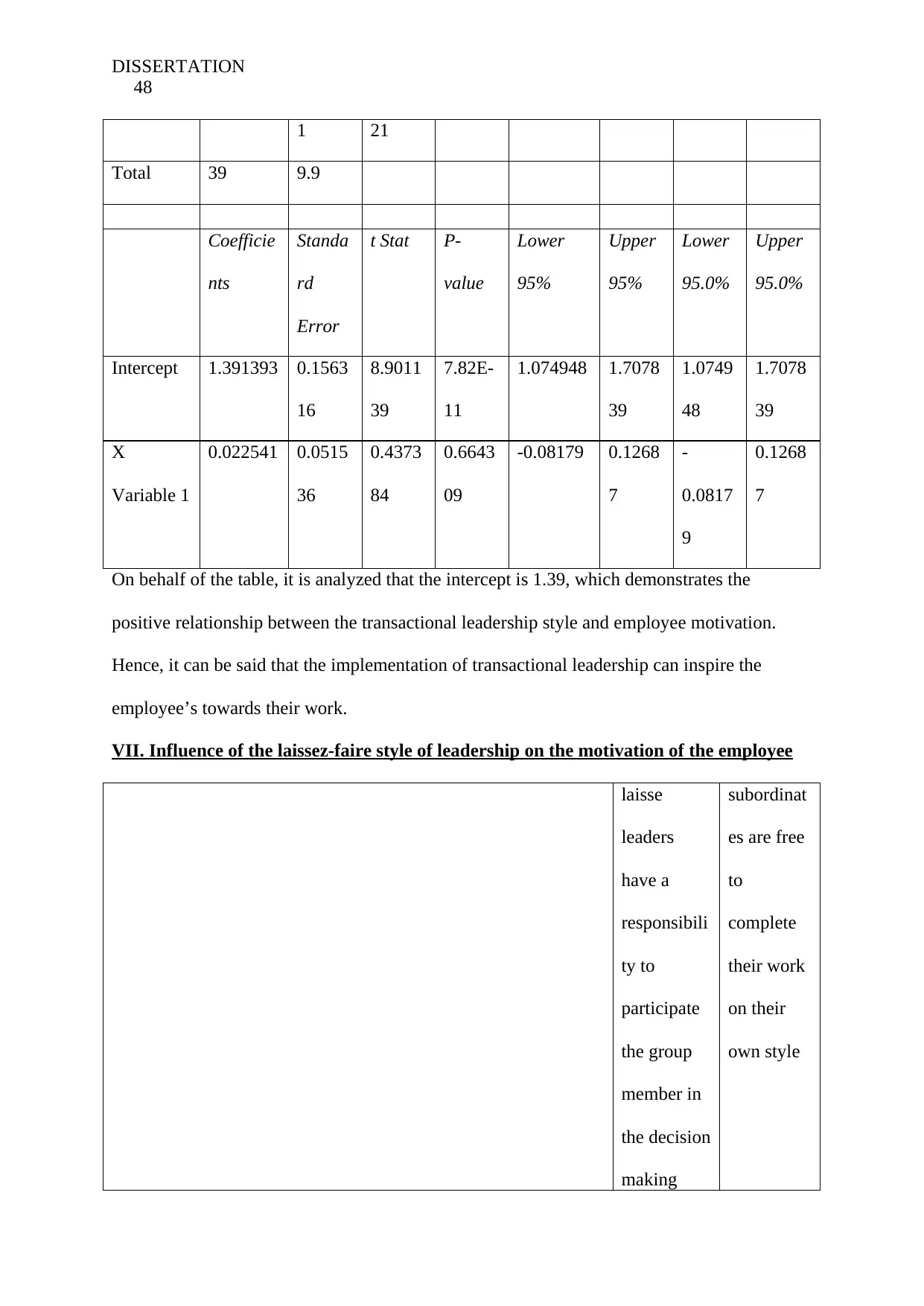
DISSERTATION
48
1 21
Total 39 9.9
Coefficie
nts
Standa
rd
Error
t Stat P-
value
Lower
95%
Upper
95%
Lower
95.0%
Upper
95.0%
Intercept 1.391393 0.1563
16
8.9011
39
7.82E-
11
1.074948 1.7078
39
1.0749
48
1.7078
39
X
Variable 1
0.022541 0.0515
36
0.4373
84
0.6643
09
-0.08179 0.1268
7
-
0.0817
9
0.1268
7
On behalf of the table, it is analyzed that the intercept is 1.39, which demonstrates the
positive relationship between the transactional leadership style and employee motivation.
Hence, it can be said that the implementation of transactional leadership can inspire the
employee’s towards their work.
VII. Influence of the laissez-faire style of leadership on the motivation of the employee
laisse
leaders
have a
responsibili
ty to
participate
the group
member in
the decision
making
subordinat
es are free
to
complete
their work
on their
own style
48
1 21
Total 39 9.9
Coefficie
nts
Standa
rd
Error
t Stat P-
value
Lower
95%
Upper
95%
Lower
95.0%
Upper
95.0%
Intercept 1.391393 0.1563
16
8.9011
39
7.82E-
11
1.074948 1.7078
39
1.0749
48
1.7078
39
X
Variable 1
0.022541 0.0515
36
0.4373
84
0.6643
09
-0.08179 0.1268
7
-
0.0817
9
0.1268
7
On behalf of the table, it is analyzed that the intercept is 1.39, which demonstrates the
positive relationship between the transactional leadership style and employee motivation.
Hence, it can be said that the implementation of transactional leadership can inspire the
employee’s towards their work.
VII. Influence of the laissez-faire style of leadership on the motivation of the employee
laisse
leaders
have a
responsibili
ty to
participate
the group
member in
the decision
making
subordinat
es are free
to
complete
their work
on their
own style
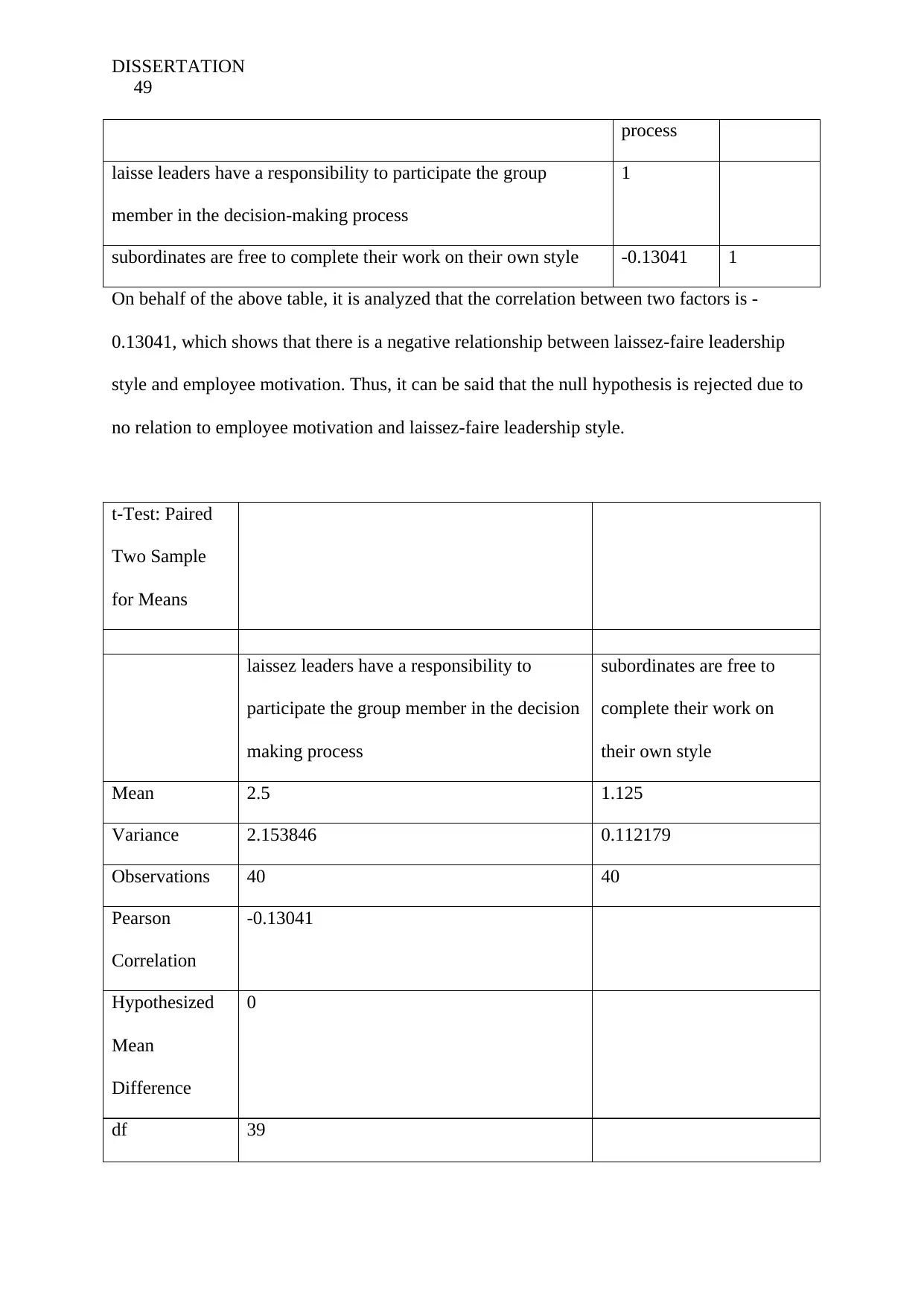
DISSERTATION
49
process
laisse leaders have a responsibility to participate the group
member in the decision-making process
1
subordinates are free to complete their work on their own style -0.13041 1
On behalf of the above table, it is analyzed that the correlation between two factors is -
0.13041, which shows that there is a negative relationship between laissez-faire leadership
style and employee motivation. Thus, it can be said that the null hypothesis is rejected due to
no relation to employee motivation and laissez-faire leadership style.
t-Test: Paired
Two Sample
for Means
laissez leaders have a responsibility to
participate the group member in the decision
making process
subordinates are free to
complete their work on
their own style
Mean 2.5 1.125
Variance 2.153846 0.112179
Observations 40 40
Pearson
Correlation
-0.13041
Hypothesized
Mean
Difference
0
df 39
49
process
laisse leaders have a responsibility to participate the group
member in the decision-making process
1
subordinates are free to complete their work on their own style -0.13041 1
On behalf of the above table, it is analyzed that the correlation between two factors is -
0.13041, which shows that there is a negative relationship between laissez-faire leadership
style and employee motivation. Thus, it can be said that the null hypothesis is rejected due to
no relation to employee motivation and laissez-faire leadership style.
t-Test: Paired
Two Sample
for Means
laissez leaders have a responsibility to
participate the group member in the decision
making process
subordinates are free to
complete their work on
their own style
Mean 2.5 1.125
Variance 2.153846 0.112179
Observations 40 40
Pearson
Correlation
-0.13041
Hypothesized
Mean
Difference
0
df 39
Paraphrase This Document
Need a fresh take? Get an instant paraphrase of this document with our AI Paraphraser
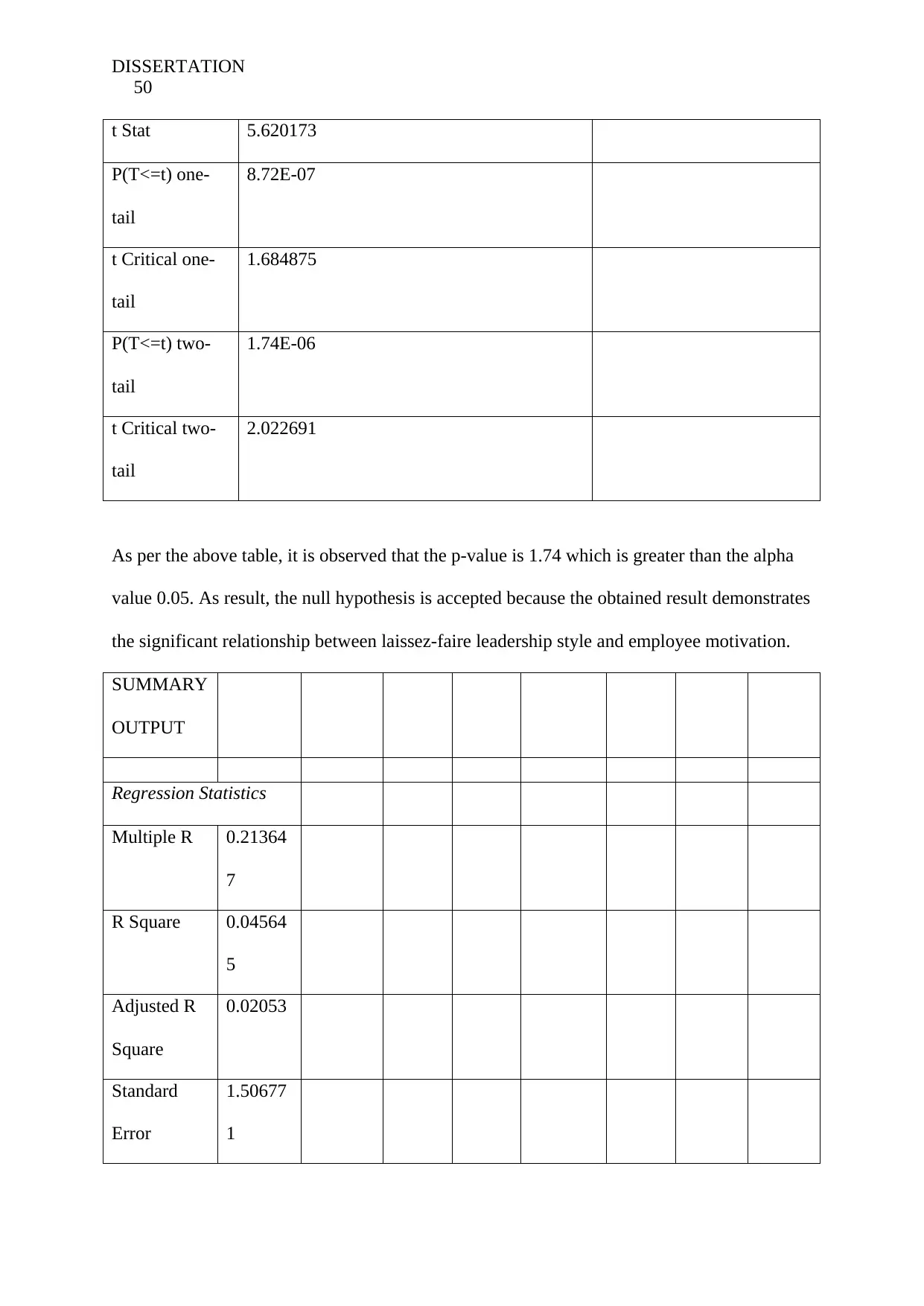
DISSERTATION
50
t Stat 5.620173
P(T<=t) one-
tail
8.72E-07
t Critical one-
tail
1.684875
P(T<=t) two-
tail
1.74E-06
t Critical two-
tail
2.022691
As per the above table, it is observed that the p-value is 1.74 which is greater than the alpha
value 0.05. As result, the null hypothesis is accepted because the obtained result demonstrates
the significant relationship between laissez-faire leadership style and employee motivation.
SUMMARY
OUTPUT
Regression Statistics
Multiple R 0.21364
7
R Square 0.04564
5
Adjusted R
Square
0.02053
Standard
Error
1.50677
1
50
t Stat 5.620173
P(T<=t) one-
tail
8.72E-07
t Critical one-
tail
1.684875
P(T<=t) two-
tail
1.74E-06
t Critical two-
tail
2.022691
As per the above table, it is observed that the p-value is 1.74 which is greater than the alpha
value 0.05. As result, the null hypothesis is accepted because the obtained result demonstrates
the significant relationship between laissez-faire leadership style and employee motivation.
SUMMARY
OUTPUT
Regression Statistics
Multiple R 0.21364
7
R Square 0.04564
5
Adjusted R
Square
0.02053
Standard
Error
1.50677
1
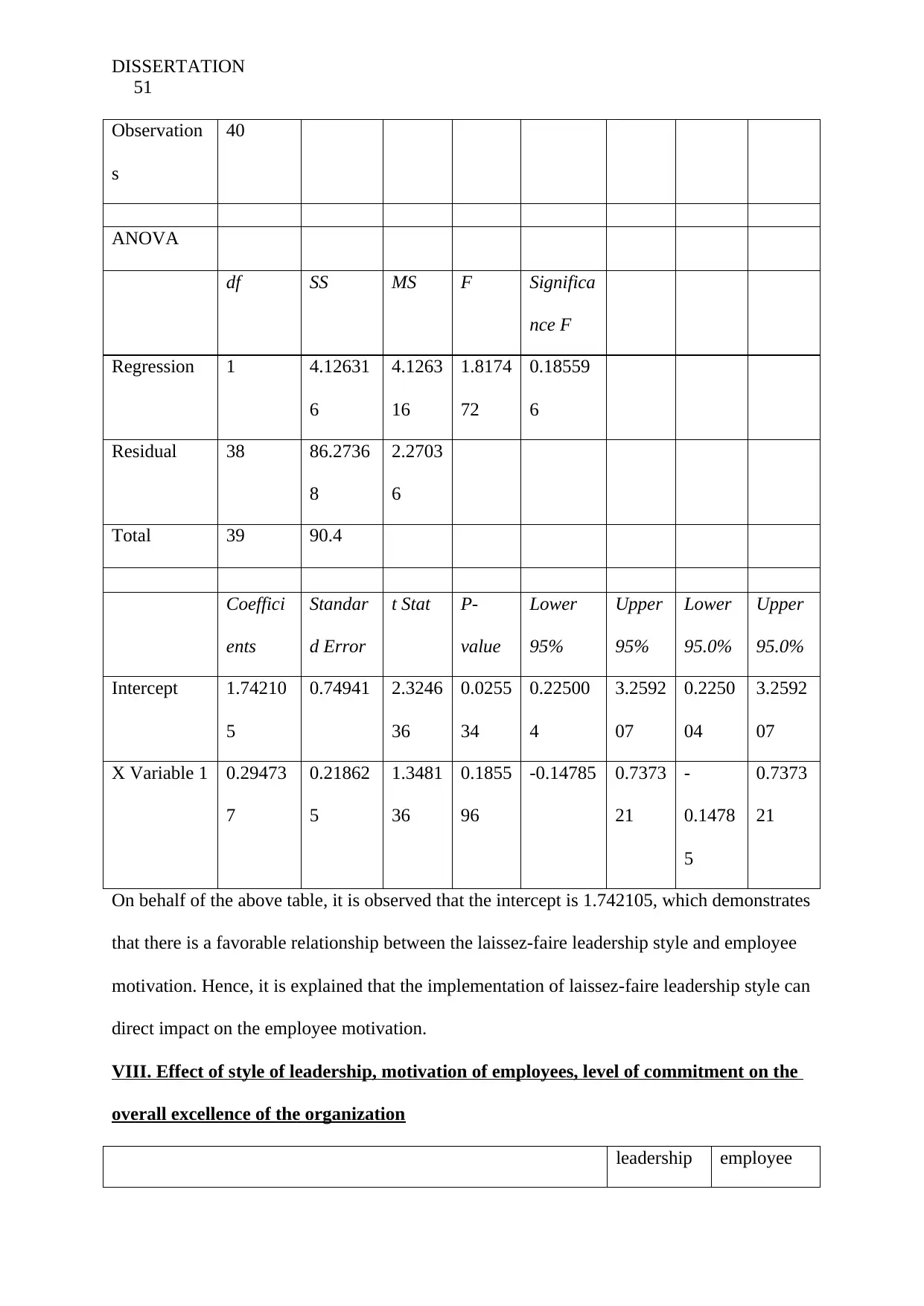
DISSERTATION
51
Observation
s
40
ANOVA
df SS MS F Significa
nce F
Regression 1 4.12631
6
4.1263
16
1.8174
72
0.18559
6
Residual 38 86.2736
8
2.2703
6
Total 39 90.4
Coeffici
ents
Standar
d Error
t Stat P-
value
Lower
95%
Upper
95%
Lower
95.0%
Upper
95.0%
Intercept 1.74210
5
0.74941 2.3246
36
0.0255
34
0.22500
4
3.2592
07
0.2250
04
3.2592
07
X Variable 1 0.29473
7
0.21862
5
1.3481
36
0.1855
96
-0.14785 0.7373
21
-
0.1478
5
0.7373
21
On behalf of the above table, it is observed that the intercept is 1.742105, which demonstrates
that there is a favorable relationship between the laissez-faire leadership style and employee
motivation. Hence, it is explained that the implementation of laissez-faire leadership style can
direct impact on the employee motivation.
VIII. Effect of style of leadership, motivation of employees, level of commitment on the
overall excellence of the organization
leadership employee
51
Observation
s
40
ANOVA
df SS MS F Significa
nce F
Regression 1 4.12631
6
4.1263
16
1.8174
72
0.18559
6
Residual 38 86.2736
8
2.2703
6
Total 39 90.4
Coeffici
ents
Standar
d Error
t Stat P-
value
Lower
95%
Upper
95%
Lower
95.0%
Upper
95.0%
Intercept 1.74210
5
0.74941 2.3246
36
0.0255
34
0.22500
4
3.2592
07
0.2250
04
3.2592
07
X Variable 1 0.29473
7
0.21862
5
1.3481
36
0.1855
96
-0.14785 0.7373
21
-
0.1478
5
0.7373
21
On behalf of the above table, it is observed that the intercept is 1.742105, which demonstrates
that there is a favorable relationship between the laissez-faire leadership style and employee
motivation. Hence, it is explained that the implementation of laissez-faire leadership style can
direct impact on the employee motivation.
VIII. Effect of style of leadership, motivation of employees, level of commitment on the
overall excellence of the organization
leadership employee
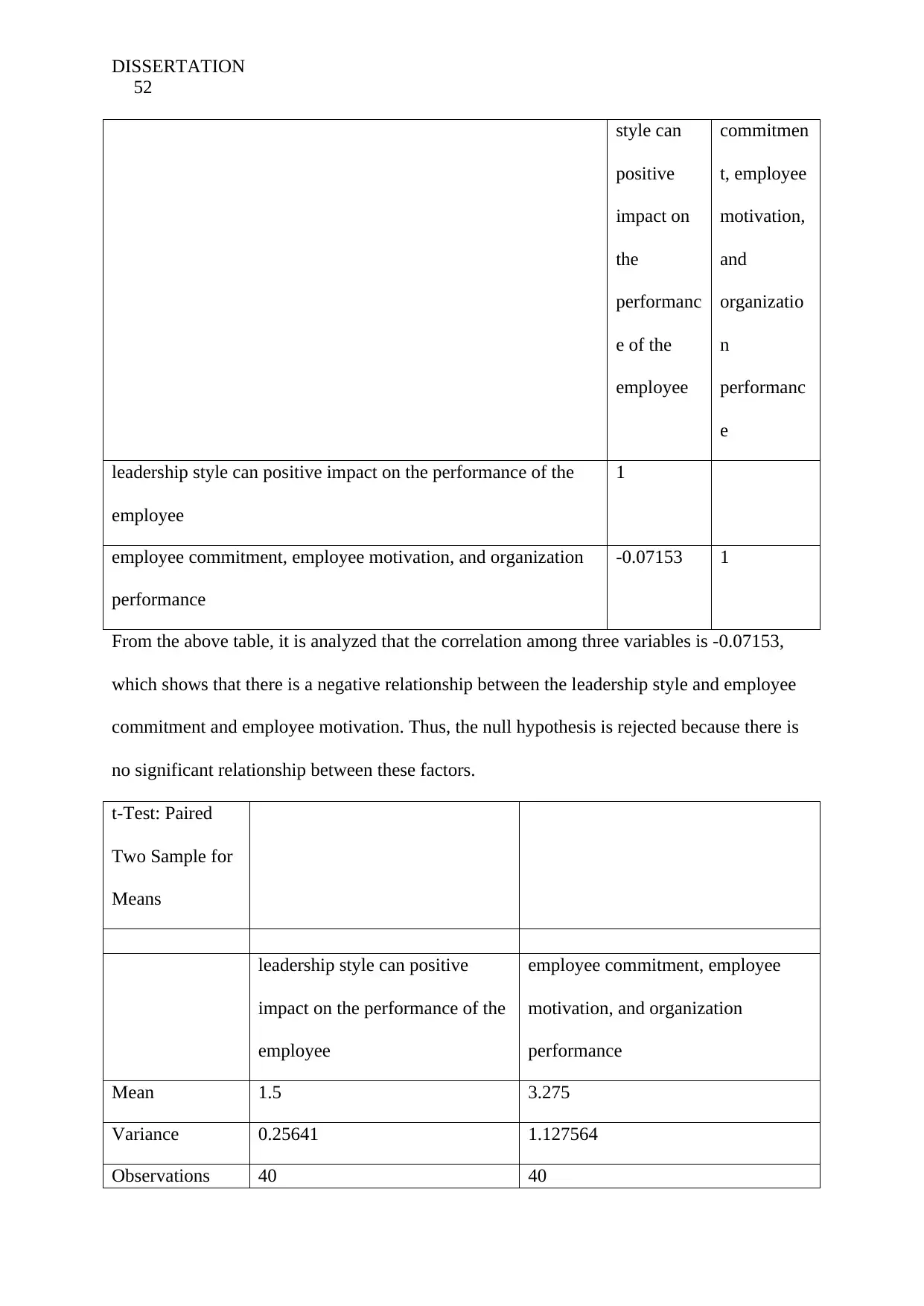
DISSERTATION
52
style can
positive
impact on
the
performanc
e of the
employee
commitmen
t, employee
motivation,
and
organizatio
n
performanc
e
leadership style can positive impact on the performance of the
employee
1
employee commitment, employee motivation, and organization
performance
-0.07153 1
From the above table, it is analyzed that the correlation among three variables is -0.07153,
which shows that there is a negative relationship between the leadership style and employee
commitment and employee motivation. Thus, the null hypothesis is rejected because there is
no significant relationship between these factors.
t-Test: Paired
Two Sample for
Means
leadership style can positive
impact on the performance of the
employee
employee commitment, employee
motivation, and organization
performance
Mean 1.5 3.275
Variance 0.25641 1.127564
Observations 40 40
52
style can
positive
impact on
the
performanc
e of the
employee
commitmen
t, employee
motivation,
and
organizatio
n
performanc
e
leadership style can positive impact on the performance of the
employee
1
employee commitment, employee motivation, and organization
performance
-0.07153 1
From the above table, it is analyzed that the correlation among three variables is -0.07153,
which shows that there is a negative relationship between the leadership style and employee
commitment and employee motivation. Thus, the null hypothesis is rejected because there is
no significant relationship between these factors.
t-Test: Paired
Two Sample for
Means
leadership style can positive
impact on the performance of the
employee
employee commitment, employee
motivation, and organization
performance
Mean 1.5 3.275
Variance 0.25641 1.127564
Observations 40 40
Secure Best Marks with AI Grader
Need help grading? Try our AI Grader for instant feedback on your assignments.

DISSERTATION
53
Pearson
Correlation
-0.07153
Hypothesized
Mean Difference
0
df 39
t Stat -9.28792
P(T<=t) one-tail 9.93E-12
t Critical one-tail 1.684875
P(T<=t) two-tail 1.99E-11
t Critical two-tail 2.022691
From the above analysis, it is analyzed that the p-value is 1.99E-11 that is more than the
alpha 0.05. Consequently, the null hypothesis is accepted because there is a positive
relationship between leadership style, employee commitment, and employee motivation.
SUMMARY
OUTPUT
Regression Statistics
Multiple R 0.13041
R Square 0.01700
7
Adjusted R
Square
-
0.00886
Standard
Error
1.47408
7
53
Pearson
Correlation
-0.07153
Hypothesized
Mean Difference
0
df 39
t Stat -9.28792
P(T<=t) one-tail 9.93E-12
t Critical one-tail 1.684875
P(T<=t) two-tail 1.99E-11
t Critical two-tail 2.022691
From the above analysis, it is analyzed that the p-value is 1.99E-11 that is more than the
alpha 0.05. Consequently, the null hypothesis is accepted because there is a positive
relationship between leadership style, employee commitment, and employee motivation.
SUMMARY
OUTPUT
Regression Statistics
Multiple R 0.13041
R Square 0.01700
7
Adjusted R
Square
-
0.00886
Standard
Error
1.47408
7

DISSERTATION
54
Observation
s
40
ANOVA
df SS MS F Significa
nce F
Regression 1 1.42857
1
1.4285
71
0.6574
39
0.42251
5
Residual 38 82.5714
3
2.1729
32
Total 39 84
Coeffici
ents
Standar
d Error
t Stat P-
value
Lower
95%
Upper
95%
Lower
95.0%
Upper
95.0%
Intercept 3.14285
7
0.82639
1
3.8031
13
0.0005
04
1.46991
7
4.8157
98
1.4699
17
4.8157
98
X Variable 1 -
0.57143
0.70474
8
-
0.8108
3
0.4225
15
-1.99812 0.8552
6
-
1.9981
2
0.8552
6
From the above table, it is analyzed that the intercept is 3.14 which shows that there is a
positive relationship between the leadership style, employee commitment, and employee
motivation. Hence, it can be said that the leadership style can enhance the employee
commitment level and employee motivation, which can be supportive to improve the
performance of the organization.
Reliability test
54
Observation
s
40
ANOVA
df SS MS F Significa
nce F
Regression 1 1.42857
1
1.4285
71
0.6574
39
0.42251
5
Residual 38 82.5714
3
2.1729
32
Total 39 84
Coeffici
ents
Standar
d Error
t Stat P-
value
Lower
95%
Upper
95%
Lower
95.0%
Upper
95.0%
Intercept 3.14285
7
0.82639
1
3.8031
13
0.0005
04
1.46991
7
4.8157
98
1.4699
17
4.8157
98
X Variable 1 -
0.57143
0.70474
8
-
0.8108
3
0.4225
15
-1.99812 0.8552
6
-
1.9981
2
0.8552
6
From the above table, it is analyzed that the intercept is 3.14 which shows that there is a
positive relationship between the leadership style, employee commitment, and employee
motivation. Hence, it can be said that the leadership style can enhance the employee
commitment level and employee motivation, which can be supportive to improve the
performance of the organization.
Reliability test
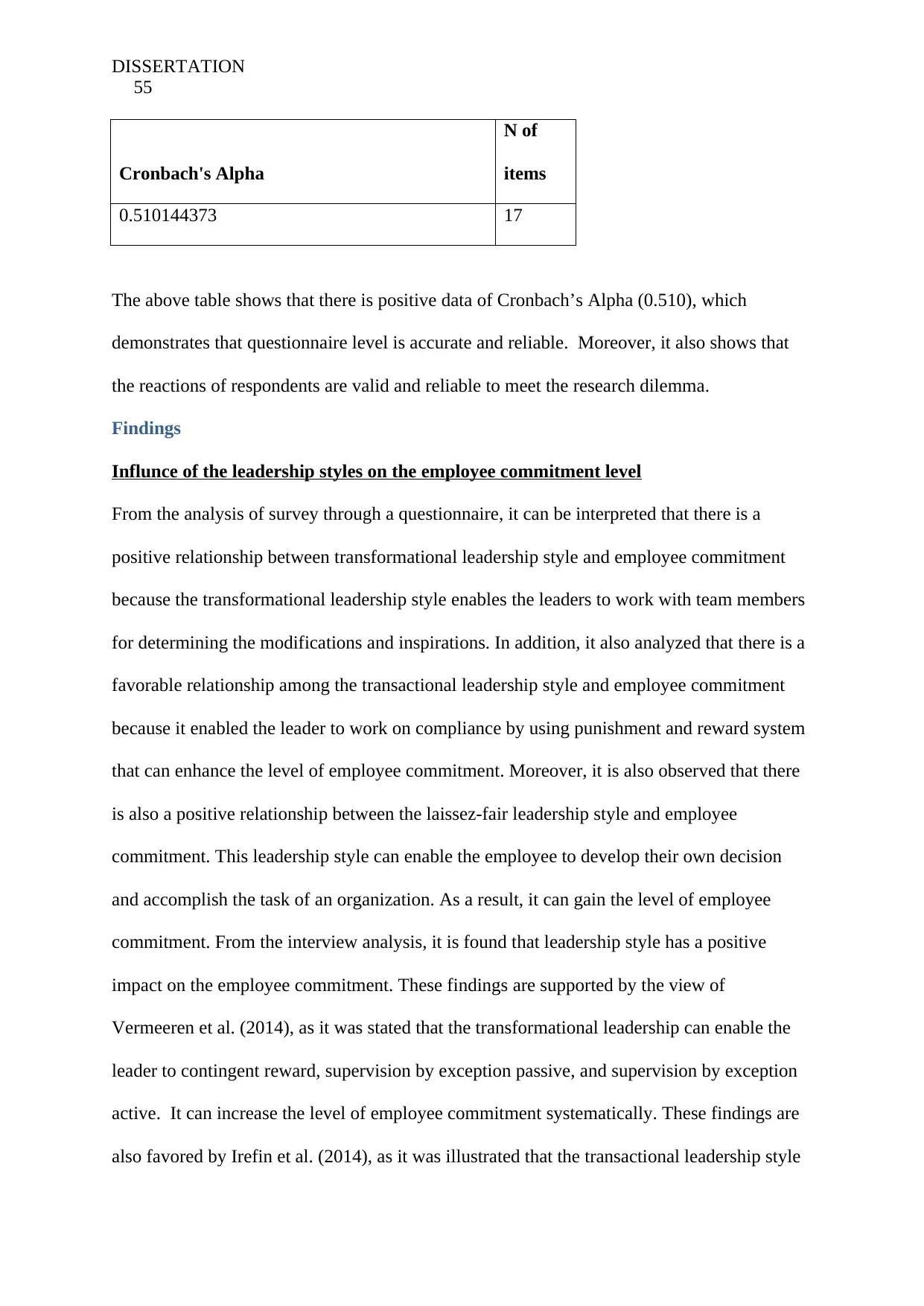
DISSERTATION
55
Cronbach's Alpha
N of
items
0.510144373 17
The above table shows that there is positive data of Cronbach’s Alpha (0.510), which
demonstrates that questionnaire level is accurate and reliable. Moreover, it also shows that
the reactions of respondents are valid and reliable to meet the research dilemma.
Findings
Influnce of the leadership styles on the employee commitment level
From the analysis of survey through a questionnaire, it can be interpreted that there is a
positive relationship between transformational leadership style and employee commitment
because the transformational leadership style enables the leaders to work with team members
for determining the modifications and inspirations. In addition, it also analyzed that there is a
favorable relationship among the transactional leadership style and employee commitment
because it enabled the leader to work on compliance by using punishment and reward system
that can enhance the level of employee commitment. Moreover, it is also observed that there
is also a positive relationship between the laissez-fair leadership style and employee
commitment. This leadership style can enable the employee to develop their own decision
and accomplish the task of an organization. As a result, it can gain the level of employee
commitment. From the interview analysis, it is found that leadership style has a positive
impact on the employee commitment. These findings are supported by the view of
Vermeeren et al. (2014), as it was stated that the transformational leadership can enable the
leader to contingent reward, supervision by exception passive, and supervision by exception
active. It can increase the level of employee commitment systematically. These findings are
also favored by Irefin et al. (2014), as it was illustrated that the transactional leadership style
55
Cronbach's Alpha
N of
items
0.510144373 17
The above table shows that there is positive data of Cronbach’s Alpha (0.510), which
demonstrates that questionnaire level is accurate and reliable. Moreover, it also shows that
the reactions of respondents are valid and reliable to meet the research dilemma.
Findings
Influnce of the leadership styles on the employee commitment level
From the analysis of survey through a questionnaire, it can be interpreted that there is a
positive relationship between transformational leadership style and employee commitment
because the transformational leadership style enables the leaders to work with team members
for determining the modifications and inspirations. In addition, it also analyzed that there is a
favorable relationship among the transactional leadership style and employee commitment
because it enabled the leader to work on compliance by using punishment and reward system
that can enhance the level of employee commitment. Moreover, it is also observed that there
is also a positive relationship between the laissez-fair leadership style and employee
commitment. This leadership style can enable the employee to develop their own decision
and accomplish the task of an organization. As a result, it can gain the level of employee
commitment. From the interview analysis, it is found that leadership style has a positive
impact on the employee commitment. These findings are supported by the view of
Vermeeren et al. (2014), as it was stated that the transformational leadership can enable the
leader to contingent reward, supervision by exception passive, and supervision by exception
active. It can increase the level of employee commitment systematically. These findings are
also favored by Irefin et al. (2014), as it was illustrated that the transactional leadership style
Paraphrase This Document
Need a fresh take? Get an instant paraphrase of this document with our AI Paraphraser
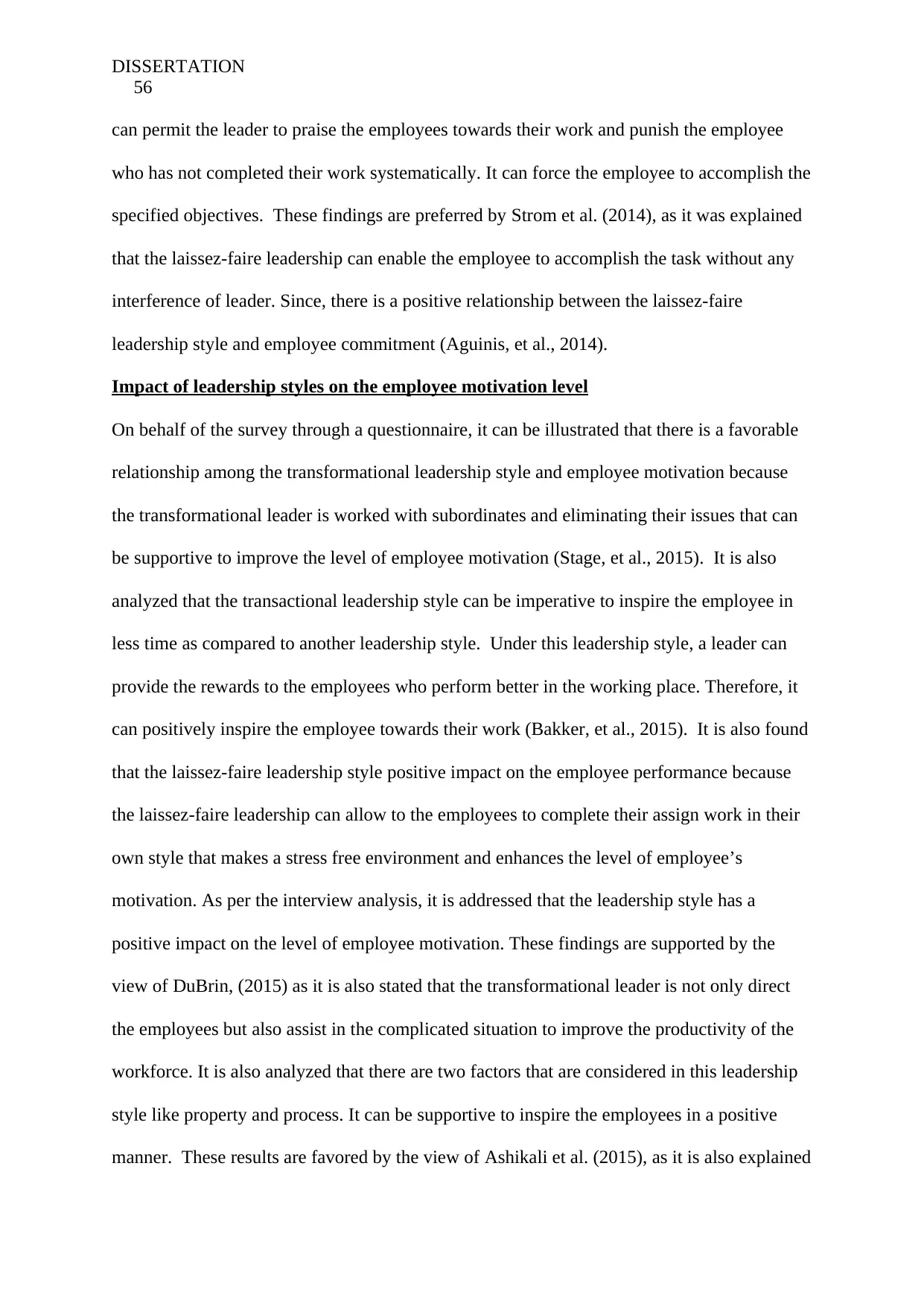
DISSERTATION
56
can permit the leader to praise the employees towards their work and punish the employee
who has not completed their work systematically. It can force the employee to accomplish the
specified objectives. These findings are preferred by Strom et al. (2014), as it was explained
that the laissez-faire leadership can enable the employee to accomplish the task without any
interference of leader. Since, there is a positive relationship between the laissez-faire
leadership style and employee commitment (Aguinis, et al., 2014).
Impact of leadership styles on the employee motivation level
On behalf of the survey through a questionnaire, it can be illustrated that there is a favorable
relationship among the transformational leadership style and employee motivation because
the transformational leader is worked with subordinates and eliminating their issues that can
be supportive to improve the level of employee motivation (Stage, et al., 2015). It is also
analyzed that the transactional leadership style can be imperative to inspire the employee in
less time as compared to another leadership style. Under this leadership style, a leader can
provide the rewards to the employees who perform better in the working place. Therefore, it
can positively inspire the employee towards their work (Bakker, et al., 2015). It is also found
that the laissez-faire leadership style positive impact on the employee performance because
the laissez-faire leadership can allow to the employees to complete their assign work in their
own style that makes a stress free environment and enhances the level of employee’s
motivation. As per the interview analysis, it is addressed that the leadership style has a
positive impact on the level of employee motivation. These findings are supported by the
view of DuBrin, (2015) as it is also stated that the transformational leader is not only direct
the employees but also assist in the complicated situation to improve the productivity of the
workforce. It is also analyzed that there are two factors that are considered in this leadership
style like property and process. It can be supportive to inspire the employees in a positive
manner. These results are favored by the view of Ashikali et al. (2015), as it is also explained
56
can permit the leader to praise the employees towards their work and punish the employee
who has not completed their work systematically. It can force the employee to accomplish the
specified objectives. These findings are preferred by Strom et al. (2014), as it was explained
that the laissez-faire leadership can enable the employee to accomplish the task without any
interference of leader. Since, there is a positive relationship between the laissez-faire
leadership style and employee commitment (Aguinis, et al., 2014).
Impact of leadership styles on the employee motivation level
On behalf of the survey through a questionnaire, it can be illustrated that there is a favorable
relationship among the transformational leadership style and employee motivation because
the transformational leader is worked with subordinates and eliminating their issues that can
be supportive to improve the level of employee motivation (Stage, et al., 2015). It is also
analyzed that the transactional leadership style can be imperative to inspire the employee in
less time as compared to another leadership style. Under this leadership style, a leader can
provide the rewards to the employees who perform better in the working place. Therefore, it
can positively inspire the employee towards their work (Bakker, et al., 2015). It is also found
that the laissez-faire leadership style positive impact on the employee performance because
the laissez-faire leadership can allow to the employees to complete their assign work in their
own style that makes a stress free environment and enhances the level of employee’s
motivation. As per the interview analysis, it is addressed that the leadership style has a
positive impact on the level of employee motivation. These findings are supported by the
view of DuBrin, (2015) as it is also stated that the transformational leader is not only direct
the employees but also assist in the complicated situation to improve the productivity of the
workforce. It is also analyzed that there are two factors that are considered in this leadership
style like property and process. It can be supportive to inspire the employees in a positive
manner. These results are favored by the view of Ashikali et al. (2015), as it is also explained
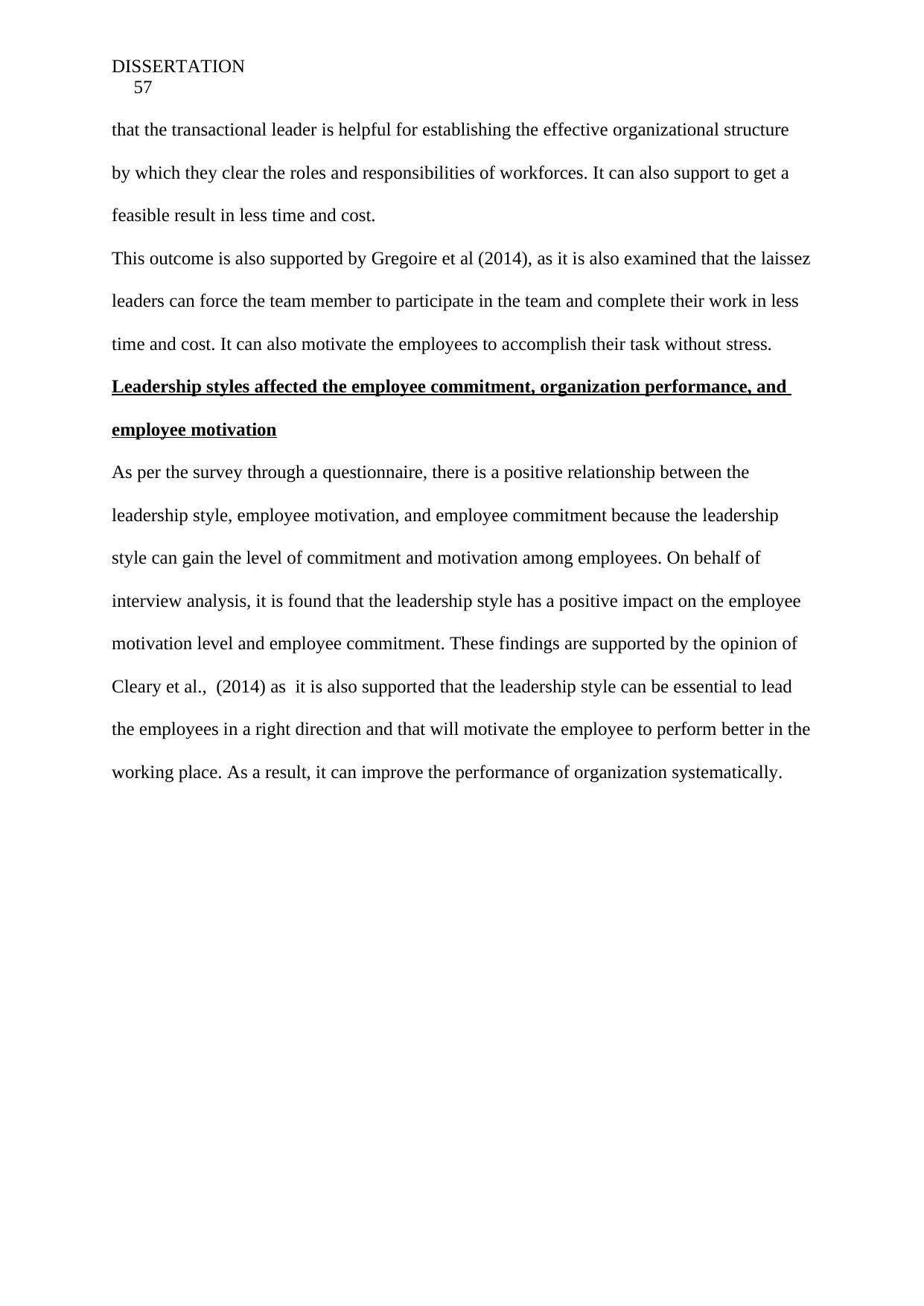
DISSERTATION
57
that the transactional leader is helpful for establishing the effective organizational structure
by which they clear the roles and responsibilities of workforces. It can also support to get a
feasible result in less time and cost.
This outcome is also supported by Gregoire et al (2014), as it is also examined that the laissez
leaders can force the team member to participate in the team and complete their work in less
time and cost. It can also motivate the employees to accomplish their task without stress.
Leadership styles affected the employee commitment, organization performance, and
employee motivation
As per the survey through a questionnaire, there is a positive relationship between the
leadership style, employee motivation, and employee commitment because the leadership
style can gain the level of commitment and motivation among employees. On behalf of
interview analysis, it is found that the leadership style has a positive impact on the employee
motivation level and employee commitment. These findings are supported by the opinion of
Cleary et al., (2014) as it is also supported that the leadership style can be essential to lead
the employees in a right direction and that will motivate the employee to perform better in the
working place. As a result, it can improve the performance of organization systematically.
57
that the transactional leader is helpful for establishing the effective organizational structure
by which they clear the roles and responsibilities of workforces. It can also support to get a
feasible result in less time and cost.
This outcome is also supported by Gregoire et al (2014), as it is also examined that the laissez
leaders can force the team member to participate in the team and complete their work in less
time and cost. It can also motivate the employees to accomplish their task without stress.
Leadership styles affected the employee commitment, organization performance, and
employee motivation
As per the survey through a questionnaire, there is a positive relationship between the
leadership style, employee motivation, and employee commitment because the leadership
style can gain the level of commitment and motivation among employees. On behalf of
interview analysis, it is found that the leadership style has a positive impact on the employee
motivation level and employee commitment. These findings are supported by the opinion of
Cleary et al., (2014) as it is also supported that the leadership style can be essential to lead
the employees in a right direction and that will motivate the employee to perform better in the
working place. As a result, it can improve the performance of organization systematically.
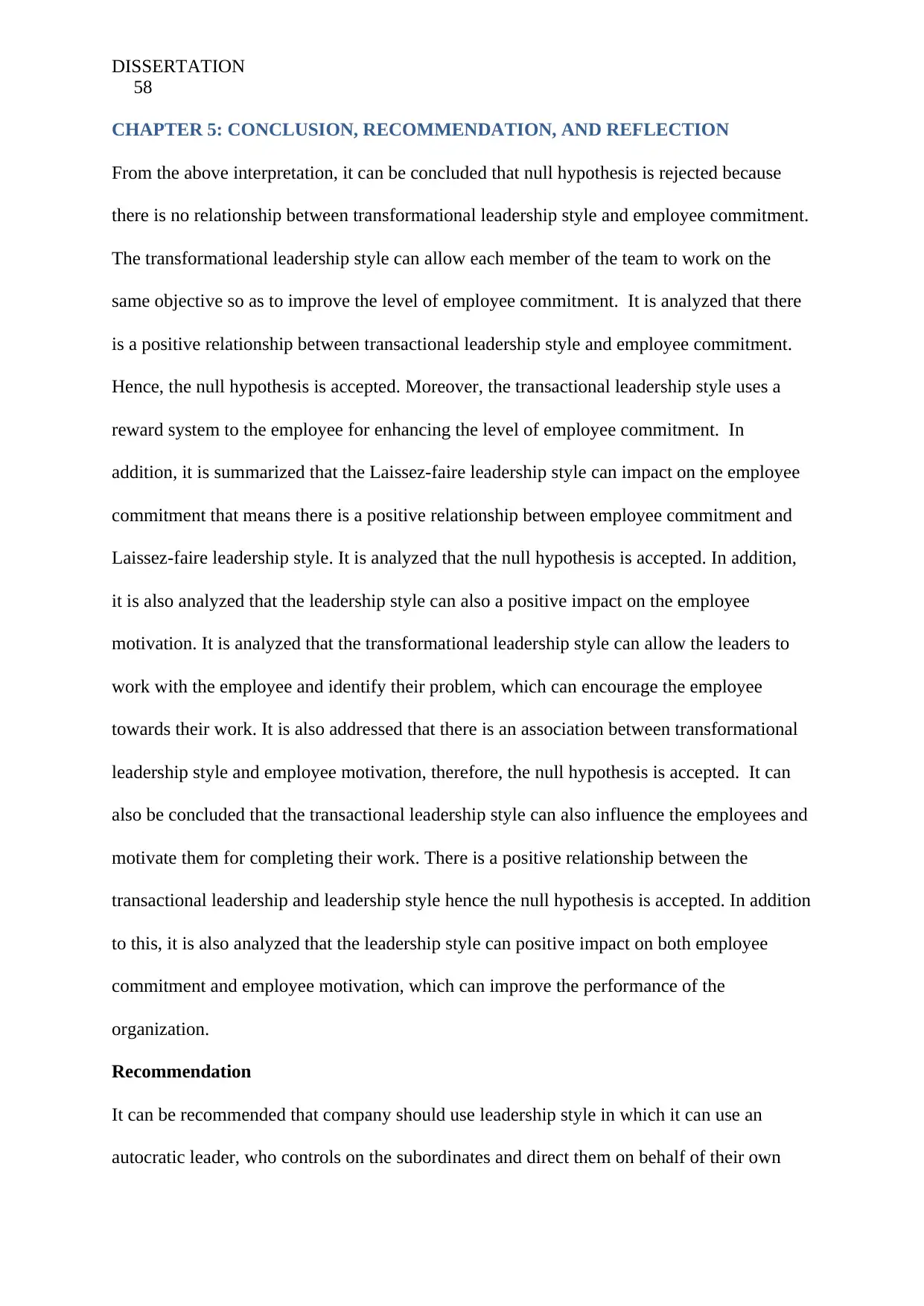
DISSERTATION
58
CHAPTER 5: CONCLUSION, RECOMMENDATION, AND REFLECTION
From the above interpretation, it can be concluded that null hypothesis is rejected because
there is no relationship between transformational leadership style and employee commitment.
The transformational leadership style can allow each member of the team to work on the
same objective so as to improve the level of employee commitment. It is analyzed that there
is a positive relationship between transactional leadership style and employee commitment.
Hence, the null hypothesis is accepted. Moreover, the transactional leadership style uses a
reward system to the employee for enhancing the level of employee commitment. In
addition, it is summarized that the Laissez-faire leadership style can impact on the employee
commitment that means there is a positive relationship between employee commitment and
Laissez-faire leadership style. It is analyzed that the null hypothesis is accepted. In addition,
it is also analyzed that the leadership style can also a positive impact on the employee
motivation. It is analyzed that the transformational leadership style can allow the leaders to
work with the employee and identify their problem, which can encourage the employee
towards their work. It is also addressed that there is an association between transformational
leadership style and employee motivation, therefore, the null hypothesis is accepted. It can
also be concluded that the transactional leadership style can also influence the employees and
motivate them for completing their work. There is a positive relationship between the
transactional leadership and leadership style hence the null hypothesis is accepted. In addition
to this, it is also analyzed that the leadership style can positive impact on both employee
commitment and employee motivation, which can improve the performance of the
organization.
Recommendation
It can be recommended that company should use leadership style in which it can use an
autocratic leader, who controls on the subordinates and direct them on behalf of their own
58
CHAPTER 5: CONCLUSION, RECOMMENDATION, AND REFLECTION
From the above interpretation, it can be concluded that null hypothesis is rejected because
there is no relationship between transformational leadership style and employee commitment.
The transformational leadership style can allow each member of the team to work on the
same objective so as to improve the level of employee commitment. It is analyzed that there
is a positive relationship between transactional leadership style and employee commitment.
Hence, the null hypothesis is accepted. Moreover, the transactional leadership style uses a
reward system to the employee for enhancing the level of employee commitment. In
addition, it is summarized that the Laissez-faire leadership style can impact on the employee
commitment that means there is a positive relationship between employee commitment and
Laissez-faire leadership style. It is analyzed that the null hypothesis is accepted. In addition,
it is also analyzed that the leadership style can also a positive impact on the employee
motivation. It is analyzed that the transformational leadership style can allow the leaders to
work with the employee and identify their problem, which can encourage the employee
towards their work. It is also addressed that there is an association between transformational
leadership style and employee motivation, therefore, the null hypothesis is accepted. It can
also be concluded that the transactional leadership style can also influence the employees and
motivate them for completing their work. There is a positive relationship between the
transactional leadership and leadership style hence the null hypothesis is accepted. In addition
to this, it is also analyzed that the leadership style can positive impact on both employee
commitment and employee motivation, which can improve the performance of the
organization.
Recommendation
It can be recommended that company should use leadership style in which it can use an
autocratic leader, who controls on the subordinates and direct them on behalf of their own
Secure Best Marks with AI Grader
Need help grading? Try our AI Grader for instant feedback on your assignments.
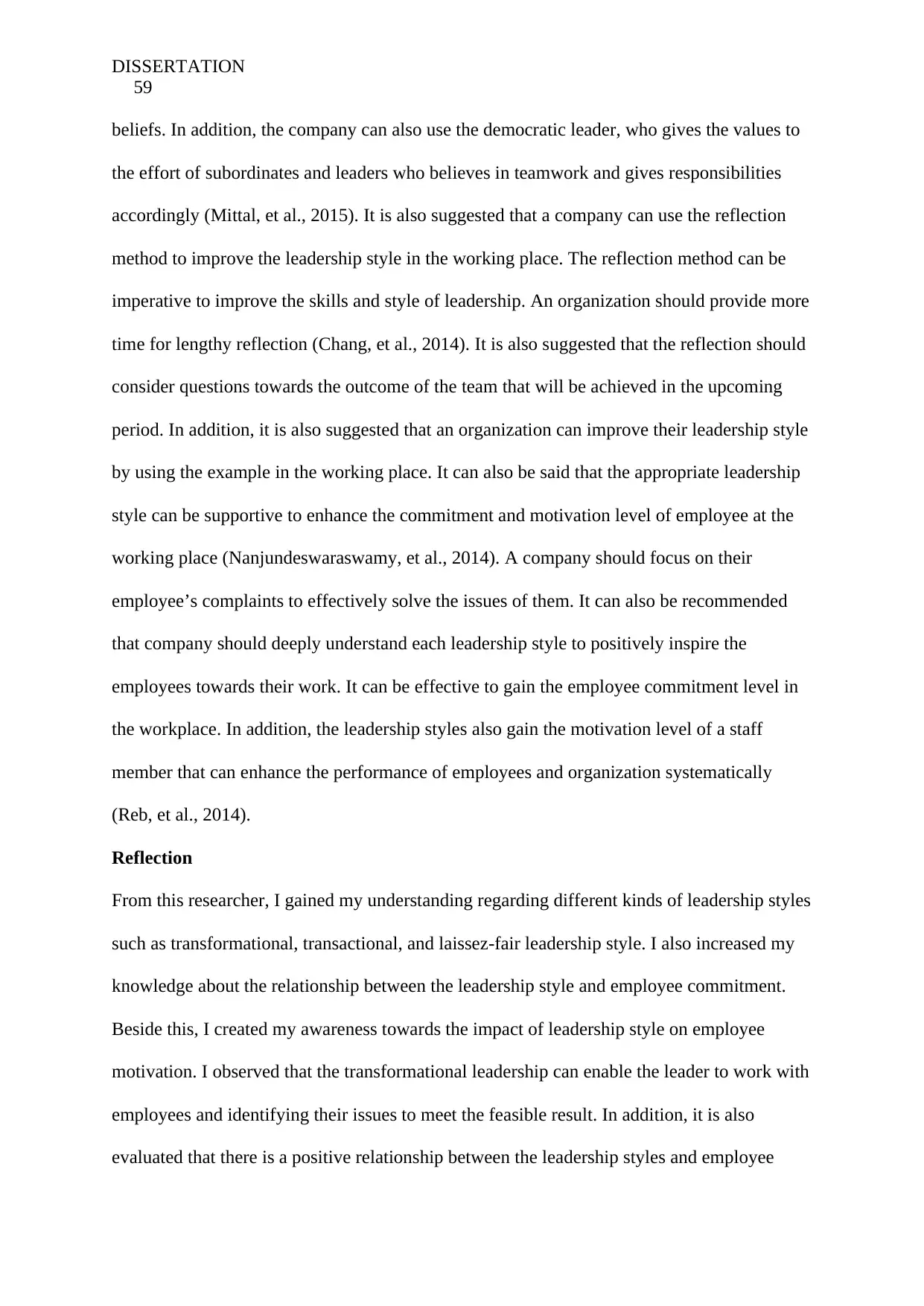
DISSERTATION
59
beliefs. In addition, the company can also use the democratic leader, who gives the values to
the effort of subordinates and leaders who believes in teamwork and gives responsibilities
accordingly (Mittal, et al., 2015). It is also suggested that a company can use the reflection
method to improve the leadership style in the working place. The reflection method can be
imperative to improve the skills and style of leadership. An organization should provide more
time for lengthy reflection (Chang, et al., 2014). It is also suggested that the reflection should
consider questions towards the outcome of the team that will be achieved in the upcoming
period. In addition, it is also suggested that an organization can improve their leadership style
by using the example in the working place. It can also be said that the appropriate leadership
style can be supportive to enhance the commitment and motivation level of employee at the
working place (Nanjundeswaraswamy, et al., 2014). A company should focus on their
employee’s complaints to effectively solve the issues of them. It can also be recommended
that company should deeply understand each leadership style to positively inspire the
employees towards their work. It can be effective to gain the employee commitment level in
the workplace. In addition, the leadership styles also gain the motivation level of a staff
member that can enhance the performance of employees and organization systematically
(Reb, et al., 2014).
Reflection
From this researcher, I gained my understanding regarding different kinds of leadership styles
such as transformational, transactional, and laissez-fair leadership style. I also increased my
knowledge about the relationship between the leadership style and employee commitment.
Beside this, I created my awareness towards the impact of leadership style on employee
motivation. I observed that the transformational leadership can enable the leader to work with
employees and identifying their issues to meet the feasible result. In addition, it is also
evaluated that there is a positive relationship between the leadership styles and employee
59
beliefs. In addition, the company can also use the democratic leader, who gives the values to
the effort of subordinates and leaders who believes in teamwork and gives responsibilities
accordingly (Mittal, et al., 2015). It is also suggested that a company can use the reflection
method to improve the leadership style in the working place. The reflection method can be
imperative to improve the skills and style of leadership. An organization should provide more
time for lengthy reflection (Chang, et al., 2014). It is also suggested that the reflection should
consider questions towards the outcome of the team that will be achieved in the upcoming
period. In addition, it is also suggested that an organization can improve their leadership style
by using the example in the working place. It can also be said that the appropriate leadership
style can be supportive to enhance the commitment and motivation level of employee at the
working place (Nanjundeswaraswamy, et al., 2014). A company should focus on their
employee’s complaints to effectively solve the issues of them. It can also be recommended
that company should deeply understand each leadership style to positively inspire the
employees towards their work. It can be effective to gain the employee commitment level in
the workplace. In addition, the leadership styles also gain the motivation level of a staff
member that can enhance the performance of employees and organization systematically
(Reb, et al., 2014).
Reflection
From this researcher, I gained my understanding regarding different kinds of leadership styles
such as transformational, transactional, and laissez-fair leadership style. I also increased my
knowledge about the relationship between the leadership style and employee commitment.
Beside this, I created my awareness towards the impact of leadership style on employee
motivation. I observed that the transformational leadership can enable the leader to work with
employees and identifying their issues to meet the feasible result. In addition, it is also
evaluated that there is a positive relationship between the leadership styles and employee
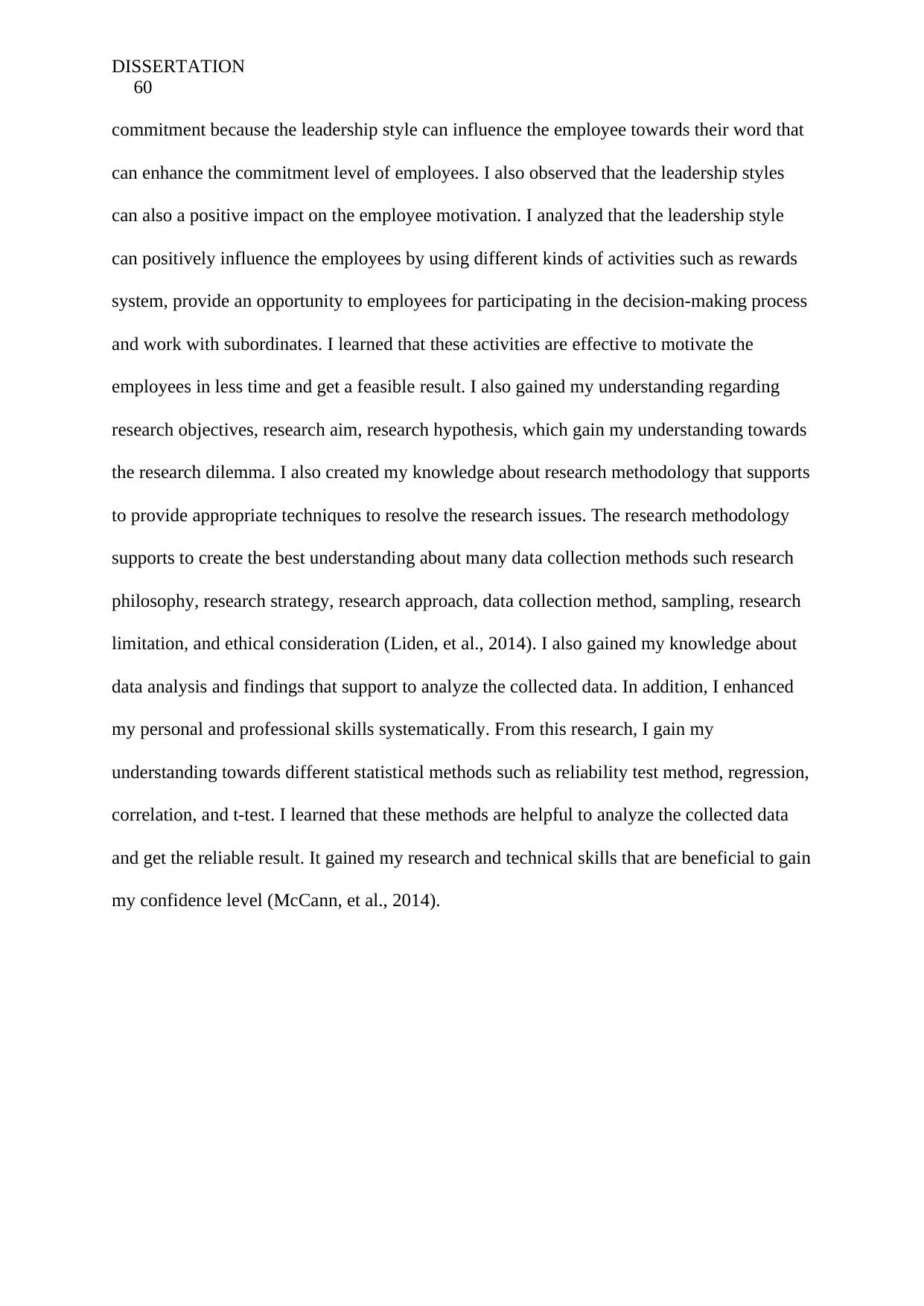
DISSERTATION
60
commitment because the leadership style can influence the employee towards their word that
can enhance the commitment level of employees. I also observed that the leadership styles
can also a positive impact on the employee motivation. I analyzed that the leadership style
can positively influence the employees by using different kinds of activities such as rewards
system, provide an opportunity to employees for participating in the decision-making process
and work with subordinates. I learned that these activities are effective to motivate the
employees in less time and get a feasible result. I also gained my understanding regarding
research objectives, research aim, research hypothesis, which gain my understanding towards
the research dilemma. I also created my knowledge about research methodology that supports
to provide appropriate techniques to resolve the research issues. The research methodology
supports to create the best understanding about many data collection methods such research
philosophy, research strategy, research approach, data collection method, sampling, research
limitation, and ethical consideration (Liden, et al., 2014). I also gained my knowledge about
data analysis and findings that support to analyze the collected data. In addition, I enhanced
my personal and professional skills systematically. From this research, I gain my
understanding towards different statistical methods such as reliability test method, regression,
correlation, and t-test. I learned that these methods are helpful to analyze the collected data
and get the reliable result. It gained my research and technical skills that are beneficial to gain
my confidence level (McCann, et al., 2014).
60
commitment because the leadership style can influence the employee towards their word that
can enhance the commitment level of employees. I also observed that the leadership styles
can also a positive impact on the employee motivation. I analyzed that the leadership style
can positively influence the employees by using different kinds of activities such as rewards
system, provide an opportunity to employees for participating in the decision-making process
and work with subordinates. I learned that these activities are effective to motivate the
employees in less time and get a feasible result. I also gained my understanding regarding
research objectives, research aim, research hypothesis, which gain my understanding towards
the research dilemma. I also created my knowledge about research methodology that supports
to provide appropriate techniques to resolve the research issues. The research methodology
supports to create the best understanding about many data collection methods such research
philosophy, research strategy, research approach, data collection method, sampling, research
limitation, and ethical consideration (Liden, et al., 2014). I also gained my knowledge about
data analysis and findings that support to analyze the collected data. In addition, I enhanced
my personal and professional skills systematically. From this research, I gain my
understanding towards different statistical methods such as reliability test method, regression,
correlation, and t-test. I learned that these methods are helpful to analyze the collected data
and get the reliable result. It gained my research and technical skills that are beneficial to gain
my confidence level (McCann, et al., 2014).
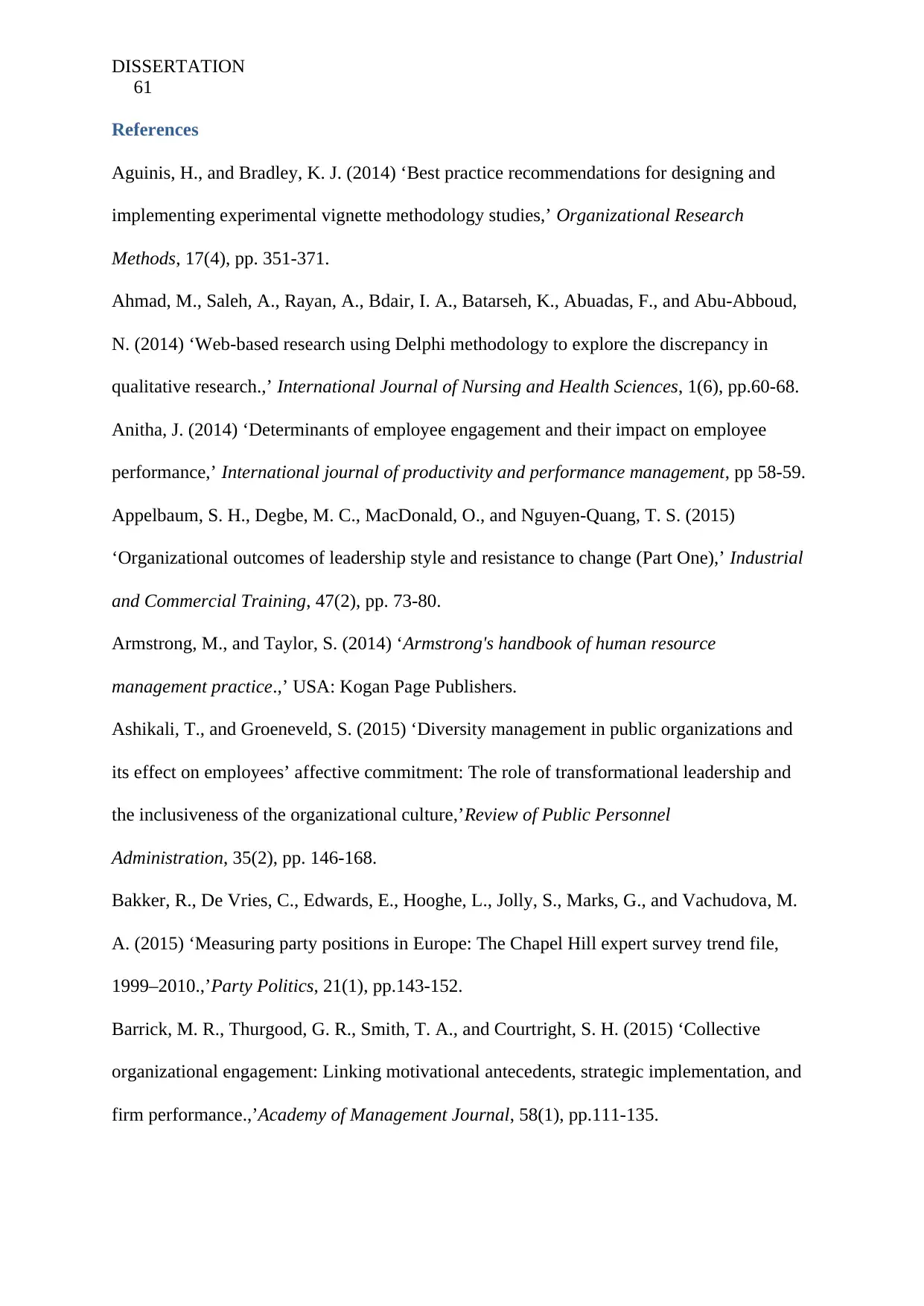
DISSERTATION
61
References
Aguinis, H., and Bradley, K. J. (2014) ‘Best practice recommendations for designing and
implementing experimental vignette methodology studies,’ Organizational Research
Methods, 17(4), pp. 351-371.
Ahmad, M., Saleh, A., Rayan, A., Bdair, I. A., Batarseh, K., Abuadas, F., and Abu-Abboud,
N. (2014) ‘Web-based research using Delphi methodology to explore the discrepancy in
qualitative research.,’ International Journal of Nursing and Health Sciences, 1(6), pp.60-68.
Anitha, J. (2014) ‘Determinants of employee engagement and their impact on employee
performance,’ International journal of productivity and performance management, pp 58-59.
Appelbaum, S. H., Degbe, M. C., MacDonald, O., and Nguyen-Quang, T. S. (2015)
‘Organizational outcomes of leadership style and resistance to change (Part One),’ Industrial
and Commercial Training, 47(2), pp. 73-80.
Armstrong, M., and Taylor, S. (2014) ‘Armstrong's handbook of human resource
management practice.,’ USA: Kogan Page Publishers.
Ashikali, T., and Groeneveld, S. (2015) ‘Diversity management in public organizations and
its effect on employees’ affective commitment: The role of transformational leadership and
the inclusiveness of the organizational culture,’Review of Public Personnel
Administration, 35(2), pp. 146-168.
Bakker, R., De Vries, C., Edwards, E., Hooghe, L., Jolly, S., Marks, G., and Vachudova, M.
A. (2015) ‘Measuring party positions in Europe: The Chapel Hill expert survey trend file,
1999–2010.,’Party Politics, 21(1), pp.143-152.
Barrick, M. R., Thurgood, G. R., Smith, T. A., and Courtright, S. H. (2015) ‘Collective
organizational engagement: Linking motivational antecedents, strategic implementation, and
firm performance.,’Academy of Management Journal, 58(1), pp.111-135.
61
References
Aguinis, H., and Bradley, K. J. (2014) ‘Best practice recommendations for designing and
implementing experimental vignette methodology studies,’ Organizational Research
Methods, 17(4), pp. 351-371.
Ahmad, M., Saleh, A., Rayan, A., Bdair, I. A., Batarseh, K., Abuadas, F., and Abu-Abboud,
N. (2014) ‘Web-based research using Delphi methodology to explore the discrepancy in
qualitative research.,’ International Journal of Nursing and Health Sciences, 1(6), pp.60-68.
Anitha, J. (2014) ‘Determinants of employee engagement and their impact on employee
performance,’ International journal of productivity and performance management, pp 58-59.
Appelbaum, S. H., Degbe, M. C., MacDonald, O., and Nguyen-Quang, T. S. (2015)
‘Organizational outcomes of leadership style and resistance to change (Part One),’ Industrial
and Commercial Training, 47(2), pp. 73-80.
Armstrong, M., and Taylor, S. (2014) ‘Armstrong's handbook of human resource
management practice.,’ USA: Kogan Page Publishers.
Ashikali, T., and Groeneveld, S. (2015) ‘Diversity management in public organizations and
its effect on employees’ affective commitment: The role of transformational leadership and
the inclusiveness of the organizational culture,’Review of Public Personnel
Administration, 35(2), pp. 146-168.
Bakker, R., De Vries, C., Edwards, E., Hooghe, L., Jolly, S., Marks, G., and Vachudova, M.
A. (2015) ‘Measuring party positions in Europe: The Chapel Hill expert survey trend file,
1999–2010.,’Party Politics, 21(1), pp.143-152.
Barrick, M. R., Thurgood, G. R., Smith, T. A., and Courtright, S. H. (2015) ‘Collective
organizational engagement: Linking motivational antecedents, strategic implementation, and
firm performance.,’Academy of Management Journal, 58(1), pp.111-135.
Paraphrase This Document
Need a fresh take? Get an instant paraphrase of this document with our AI Paraphraser
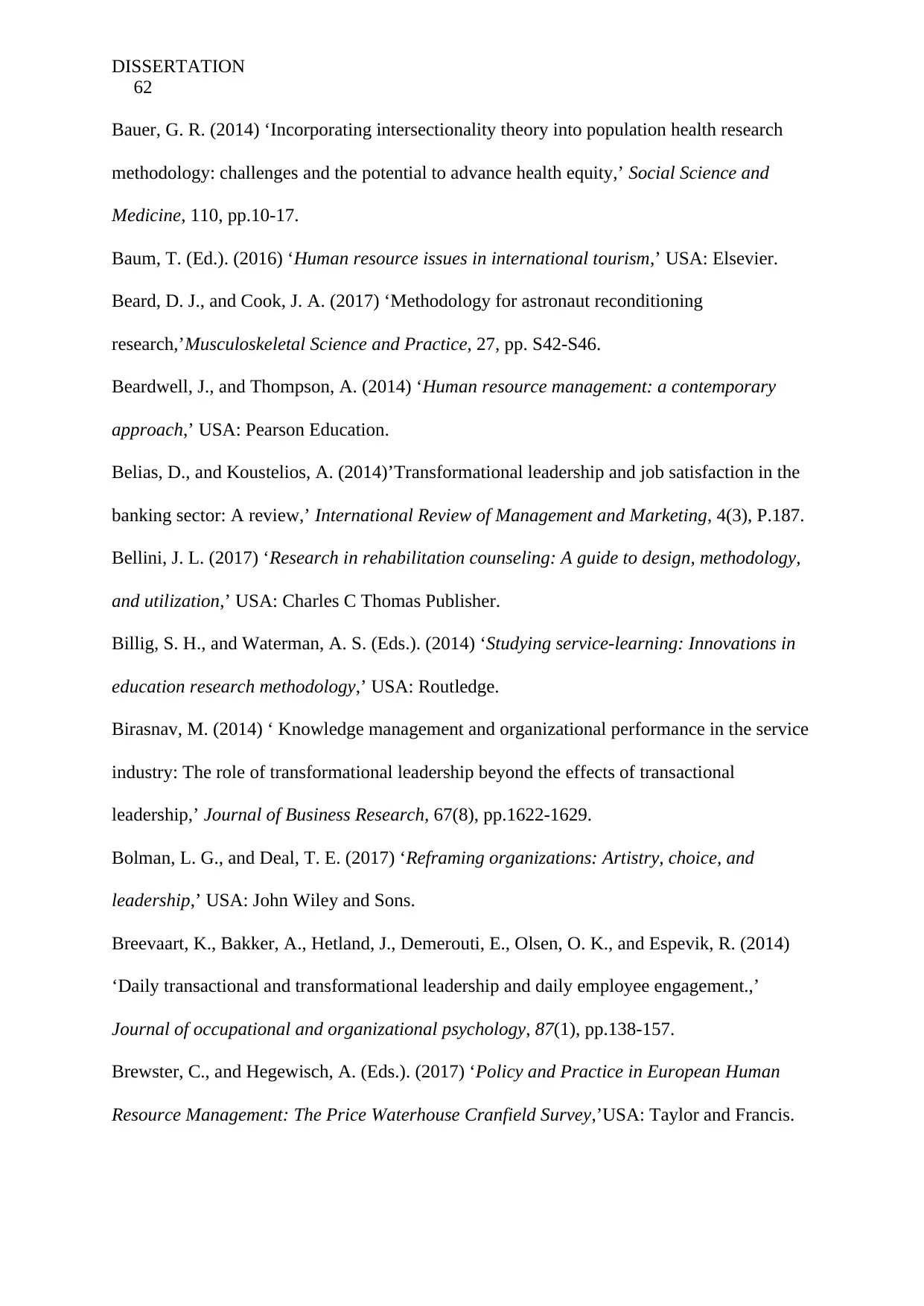
DISSERTATION
62
Bauer, G. R. (2014) ‘Incorporating intersectionality theory into population health research
methodology: challenges and the potential to advance health equity,’ Social Science and
Medicine, 110, pp.10-17.
Baum, T. (Ed.). (2016) ‘Human resource issues in international tourism,’ USA: Elsevier.
Beard, D. J., and Cook, J. A. (2017) ‘Methodology for astronaut reconditioning
research,’Musculoskeletal Science and Practice, 27, pp. S42-S46.
Beardwell, J., and Thompson, A. (2014) ‘Human resource management: a contemporary
approach,’ USA: Pearson Education.
Belias, D., and Koustelios, A. (2014)’Transformational leadership and job satisfaction in the
banking sector: A review,’ International Review of Management and Marketing, 4(3), P.187.
Bellini, J. L. (2017) ‘Research in rehabilitation counseling: A guide to design, methodology,
and utilization,’ USA: Charles C Thomas Publisher.
Billig, S. H., and Waterman, A. S. (Eds.). (2014) ‘Studying service-learning: Innovations in
education research methodology,’ USA: Routledge.
Birasnav, M. (2014) ‘ Knowledge management and organizational performance in the service
industry: The role of transformational leadership beyond the effects of transactional
leadership,’ Journal of Business Research, 67(8), pp.1622-1629.
Bolman, L. G., and Deal, T. E. (2017) ‘Reframing organizations: Artistry, choice, and
leadership,’ USA: John Wiley and Sons.
Breevaart, K., Bakker, A., Hetland, J., Demerouti, E., Olsen, O. K., and Espevik, R. (2014)
‘Daily transactional and transformational leadership and daily employee engagement.,’
Journal of occupational and organizational psychology, 87(1), pp.138-157.
Brewster, C., and Hegewisch, A. (Eds.). (2017) ‘Policy and Practice in European Human
Resource Management: The Price Waterhouse Cranfield Survey,’USA: Taylor and Francis.
62
Bauer, G. R. (2014) ‘Incorporating intersectionality theory into population health research
methodology: challenges and the potential to advance health equity,’ Social Science and
Medicine, 110, pp.10-17.
Baum, T. (Ed.). (2016) ‘Human resource issues in international tourism,’ USA: Elsevier.
Beard, D. J., and Cook, J. A. (2017) ‘Methodology for astronaut reconditioning
research,’Musculoskeletal Science and Practice, 27, pp. S42-S46.
Beardwell, J., and Thompson, A. (2014) ‘Human resource management: a contemporary
approach,’ USA: Pearson Education.
Belias, D., and Koustelios, A. (2014)’Transformational leadership and job satisfaction in the
banking sector: A review,’ International Review of Management and Marketing, 4(3), P.187.
Bellini, J. L. (2017) ‘Research in rehabilitation counseling: A guide to design, methodology,
and utilization,’ USA: Charles C Thomas Publisher.
Billig, S. H., and Waterman, A. S. (Eds.). (2014) ‘Studying service-learning: Innovations in
education research methodology,’ USA: Routledge.
Birasnav, M. (2014) ‘ Knowledge management and organizational performance in the service
industry: The role of transformational leadership beyond the effects of transactional
leadership,’ Journal of Business Research, 67(8), pp.1622-1629.
Bolman, L. G., and Deal, T. E. (2017) ‘Reframing organizations: Artistry, choice, and
leadership,’ USA: John Wiley and Sons.
Breevaart, K., Bakker, A., Hetland, J., Demerouti, E., Olsen, O. K., and Espevik, R. (2014)
‘Daily transactional and transformational leadership and daily employee engagement.,’
Journal of occupational and organizational psychology, 87(1), pp.138-157.
Brewster, C., and Hegewisch, A. (Eds.). (2017) ‘Policy and Practice in European Human
Resource Management: The Price Waterhouse Cranfield Survey,’USA: Taylor and Francis.
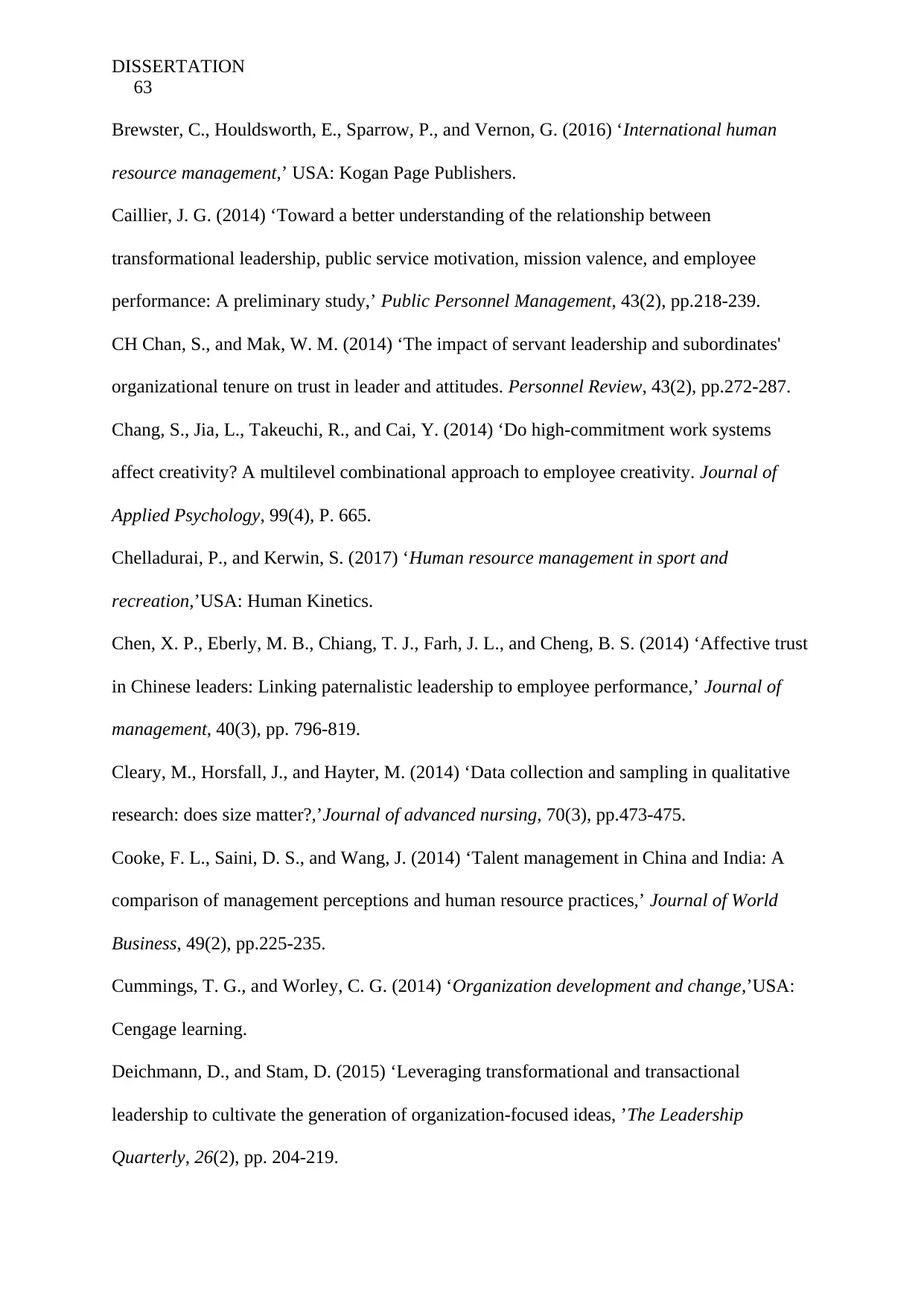
DISSERTATION
63
Brewster, C., Houldsworth, E., Sparrow, P., and Vernon, G. (2016) ‘International human
resource management,’ USA: Kogan Page Publishers.
Caillier, J. G. (2014) ‘Toward a better understanding of the relationship between
transformational leadership, public service motivation, mission valence, and employee
performance: A preliminary study,’ Public Personnel Management, 43(2), pp.218-239.
CH Chan, S., and Mak, W. M. (2014) ‘The impact of servant leadership and subordinates'
organizational tenure on trust in leader and attitudes. Personnel Review, 43(2), pp.272-287.
Chang, S., Jia, L., Takeuchi, R., and Cai, Y. (2014) ‘Do high-commitment work systems
affect creativity? A multilevel combinational approach to employee creativity. Journal of
Applied Psychology, 99(4), P. 665.
Chelladurai, P., and Kerwin, S. (2017) ‘Human resource management in sport and
recreation,’USA: Human Kinetics.
Chen, X. P., Eberly, M. B., Chiang, T. J., Farh, J. L., and Cheng, B. S. (2014) ‘Affective trust
in Chinese leaders: Linking paternalistic leadership to employee performance,’ Journal of
management, 40(3), pp. 796-819.
Cleary, M., Horsfall, J., and Hayter, M. (2014) ‘Data collection and sampling in qualitative
research: does size matter?,’Journal of advanced nursing, 70(3), pp.473-475.
Cooke, F. L., Saini, D. S., and Wang, J. (2014) ‘Talent management in China and India: A
comparison of management perceptions and human resource practices,’ Journal of World
Business, 49(2), pp.225-235.
Cummings, T. G., and Worley, C. G. (2014) ‘Organization development and change,’USA:
Cengage learning.
Deichmann, D., and Stam, D. (2015) ‘Leveraging transformational and transactional
leadership to cultivate the generation of organization-focused ideas, ’The Leadership
Quarterly, 26(2), pp. 204-219.
63
Brewster, C., Houldsworth, E., Sparrow, P., and Vernon, G. (2016) ‘International human
resource management,’ USA: Kogan Page Publishers.
Caillier, J. G. (2014) ‘Toward a better understanding of the relationship between
transformational leadership, public service motivation, mission valence, and employee
performance: A preliminary study,’ Public Personnel Management, 43(2), pp.218-239.
CH Chan, S., and Mak, W. M. (2014) ‘The impact of servant leadership and subordinates'
organizational tenure on trust in leader and attitudes. Personnel Review, 43(2), pp.272-287.
Chang, S., Jia, L., Takeuchi, R., and Cai, Y. (2014) ‘Do high-commitment work systems
affect creativity? A multilevel combinational approach to employee creativity. Journal of
Applied Psychology, 99(4), P. 665.
Chelladurai, P., and Kerwin, S. (2017) ‘Human resource management in sport and
recreation,’USA: Human Kinetics.
Chen, X. P., Eberly, M. B., Chiang, T. J., Farh, J. L., and Cheng, B. S. (2014) ‘Affective trust
in Chinese leaders: Linking paternalistic leadership to employee performance,’ Journal of
management, 40(3), pp. 796-819.
Cleary, M., Horsfall, J., and Hayter, M. (2014) ‘Data collection and sampling in qualitative
research: does size matter?,’Journal of advanced nursing, 70(3), pp.473-475.
Cooke, F. L., Saini, D. S., and Wang, J. (2014) ‘Talent management in China and India: A
comparison of management perceptions and human resource practices,’ Journal of World
Business, 49(2), pp.225-235.
Cummings, T. G., and Worley, C. G. (2014) ‘Organization development and change,’USA:
Cengage learning.
Deichmann, D., and Stam, D. (2015) ‘Leveraging transformational and transactional
leadership to cultivate the generation of organization-focused ideas, ’The Leadership
Quarterly, 26(2), pp. 204-219.
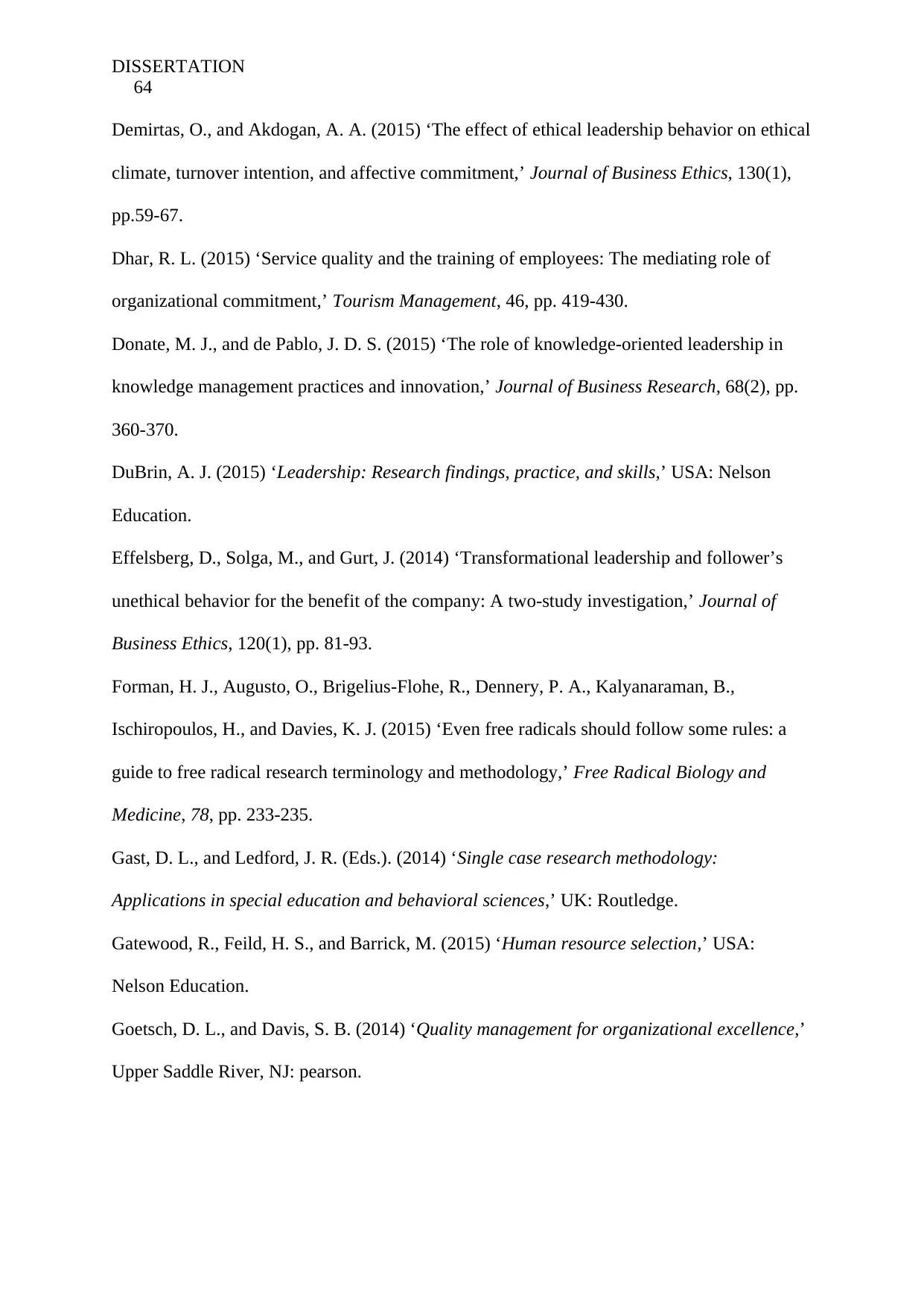
DISSERTATION
64
Demirtas, O., and Akdogan, A. A. (2015) ‘The effect of ethical leadership behavior on ethical
climate, turnover intention, and affective commitment,’ Journal of Business Ethics, 130(1),
pp.59-67.
Dhar, R. L. (2015) ‘Service quality and the training of employees: The mediating role of
organizational commitment,’ Tourism Management, 46, pp. 419-430.
Donate, M. J., and de Pablo, J. D. S. (2015) ‘The role of knowledge-oriented leadership in
knowledge management practices and innovation,’ Journal of Business Research, 68(2), pp.
360-370.
DuBrin, A. J. (2015) ‘Leadership: Research findings, practice, and skills,’ USA: Nelson
Education.
Effelsberg, D., Solga, M., and Gurt, J. (2014) ‘Transformational leadership and follower’s
unethical behavior for the benefit of the company: A two-study investigation,’ Journal of
Business Ethics, 120(1), pp. 81-93.
Forman, H. J., Augusto, O., Brigelius-Flohe, R., Dennery, P. A., Kalyanaraman, B.,
Ischiropoulos, H., and Davies, K. J. (2015) ‘Even free radicals should follow some rules: a
guide to free radical research terminology and methodology,’ Free Radical Biology and
Medicine, 78, pp. 233-235.
Gast, D. L., and Ledford, J. R. (Eds.). (2014) ‘Single case research methodology:
Applications in special education and behavioral sciences,’ UK: Routledge.
Gatewood, R., Feild, H. S., and Barrick, M. (2015) ‘Human resource selection,’ USA:
Nelson Education.
Goetsch, D. L., and Davis, S. B. (2014) ‘Quality management for organizational excellence,’
Upper Saddle River, NJ: pearson.
64
Demirtas, O., and Akdogan, A. A. (2015) ‘The effect of ethical leadership behavior on ethical
climate, turnover intention, and affective commitment,’ Journal of Business Ethics, 130(1),
pp.59-67.
Dhar, R. L. (2015) ‘Service quality and the training of employees: The mediating role of
organizational commitment,’ Tourism Management, 46, pp. 419-430.
Donate, M. J., and de Pablo, J. D. S. (2015) ‘The role of knowledge-oriented leadership in
knowledge management practices and innovation,’ Journal of Business Research, 68(2), pp.
360-370.
DuBrin, A. J. (2015) ‘Leadership: Research findings, practice, and skills,’ USA: Nelson
Education.
Effelsberg, D., Solga, M., and Gurt, J. (2014) ‘Transformational leadership and follower’s
unethical behavior for the benefit of the company: A two-study investigation,’ Journal of
Business Ethics, 120(1), pp. 81-93.
Forman, H. J., Augusto, O., Brigelius-Flohe, R., Dennery, P. A., Kalyanaraman, B.,
Ischiropoulos, H., and Davies, K. J. (2015) ‘Even free radicals should follow some rules: a
guide to free radical research terminology and methodology,’ Free Radical Biology and
Medicine, 78, pp. 233-235.
Gast, D. L., and Ledford, J. R. (Eds.). (2014) ‘Single case research methodology:
Applications in special education and behavioral sciences,’ UK: Routledge.
Gatewood, R., Feild, H. S., and Barrick, M. (2015) ‘Human resource selection,’ USA:
Nelson Education.
Goetsch, D. L., and Davis, S. B. (2014) ‘Quality management for organizational excellence,’
Upper Saddle River, NJ: pearson.
Secure Best Marks with AI Grader
Need help grading? Try our AI Grader for instant feedback on your assignments.
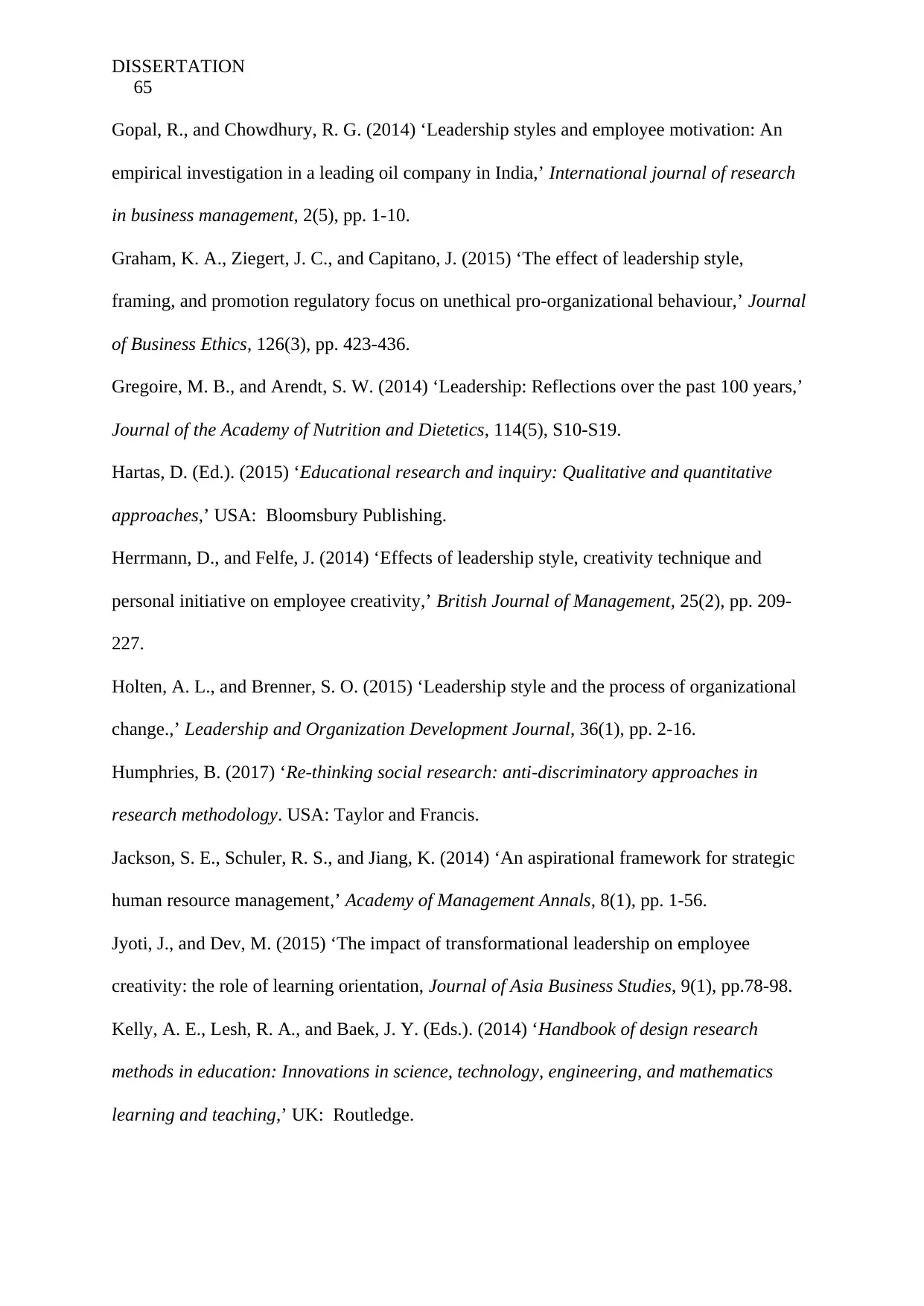
DISSERTATION
65
Gopal, R., and Chowdhury, R. G. (2014) ‘Leadership styles and employee motivation: An
empirical investigation in a leading oil company in India,’ International journal of research
in business management, 2(5), pp. 1-10.
Graham, K. A., Ziegert, J. C., and Capitano, J. (2015) ‘The effect of leadership style,
framing, and promotion regulatory focus on unethical pro-organizational behaviour,’ Journal
of Business Ethics, 126(3), pp. 423-436.
Gregoire, M. B., and Arendt, S. W. (2014) ‘Leadership: Reflections over the past 100 years,’
Journal of the Academy of Nutrition and Dietetics, 114(5), S10-S19.
Hartas, D. (Ed.). (2015) ‘Educational research and inquiry: Qualitative and quantitative
approaches,’ USA: Bloomsbury Publishing.
Herrmann, D., and Felfe, J. (2014) ‘Effects of leadership style, creativity technique and
personal initiative on employee creativity,’ British Journal of Management, 25(2), pp. 209-
227.
Holten, A. L., and Brenner, S. O. (2015) ‘Leadership style and the process of organizational
change.,’ Leadership and Organization Development Journal, 36(1), pp. 2-16.
Humphries, B. (2017) ‘Re-thinking social research: anti-discriminatory approaches in
research methodology. USA: Taylor and Francis.
Jackson, S. E., Schuler, R. S., and Jiang, K. (2014) ‘An aspirational framework for strategic
human resource management,’ Academy of Management Annals, 8(1), pp. 1-56.
Jyoti, J., and Dev, M. (2015) ‘The impact of transformational leadership on employee
creativity: the role of learning orientation, Journal of Asia Business Studies, 9(1), pp.78-98.
Kelly, A. E., Lesh, R. A., and Baek, J. Y. (Eds.). (2014) ‘Handbook of design research
methods in education: Innovations in science, technology, engineering, and mathematics
learning and teaching,’ UK: Routledge.
65
Gopal, R., and Chowdhury, R. G. (2014) ‘Leadership styles and employee motivation: An
empirical investigation in a leading oil company in India,’ International journal of research
in business management, 2(5), pp. 1-10.
Graham, K. A., Ziegert, J. C., and Capitano, J. (2015) ‘The effect of leadership style,
framing, and promotion regulatory focus on unethical pro-organizational behaviour,’ Journal
of Business Ethics, 126(3), pp. 423-436.
Gregoire, M. B., and Arendt, S. W. (2014) ‘Leadership: Reflections over the past 100 years,’
Journal of the Academy of Nutrition and Dietetics, 114(5), S10-S19.
Hartas, D. (Ed.). (2015) ‘Educational research and inquiry: Qualitative and quantitative
approaches,’ USA: Bloomsbury Publishing.
Herrmann, D., and Felfe, J. (2014) ‘Effects of leadership style, creativity technique and
personal initiative on employee creativity,’ British Journal of Management, 25(2), pp. 209-
227.
Holten, A. L., and Brenner, S. O. (2015) ‘Leadership style and the process of organizational
change.,’ Leadership and Organization Development Journal, 36(1), pp. 2-16.
Humphries, B. (2017) ‘Re-thinking social research: anti-discriminatory approaches in
research methodology. USA: Taylor and Francis.
Jackson, S. E., Schuler, R. S., and Jiang, K. (2014) ‘An aspirational framework for strategic
human resource management,’ Academy of Management Annals, 8(1), pp. 1-56.
Jyoti, J., and Dev, M. (2015) ‘The impact of transformational leadership on employee
creativity: the role of learning orientation, Journal of Asia Business Studies, 9(1), pp.78-98.
Kelly, A. E., Lesh, R. A., and Baek, J. Y. (Eds.). (2014) ‘Handbook of design research
methods in education: Innovations in science, technology, engineering, and mathematics
learning and teaching,’ UK: Routledge.

DISSERTATION
66
Keskes, I. (2014) ‘Relationship between leadership styles and dimensions of employee
organizational commitment: A critical review and discussion of future directions,’ Intangible
Capital, 10(1).
Kilpatrick, J. (2014) ‘History of research in mathematics education,’ In Encyclopedia of
mathematics education (pp. 267-272). USA: Springer Netherlands.
Knowles, M. S., Holton III, E. F., and Swanson, R. A. (2014) ‘The adult learner: The
definitive classic in adult education and human resource development,’ UK: Routledge.
Kramar, R. (2014) ‘Beyond strategic human resource management: is sustainable human
resource management the next approach?,’ The International Journal of Human Resource
Management, 25(8), 1069-1089.
Kroll, A., and Vogel, D. (2014) ‘The PSM–leadership fit: A model of performance
information use,’ Public Administration, 92(4), pp. 974-991.
Leary, M. R. (2016) ‘Introduction to behavioral research methods,’ USA: Pearson.
Liden, R. C., Wayne, S. J., Liao, C., and Meuser, J. D. (2014) ‘Servant leadership and serving
culture: Influence on individual and unit performance,’ Academy of Management
Journal, 57(5), pp.1434-1452.
Mahdi, O. R., Mohd, E. S. B. G., and Almsafir, M. K. (2014) ‘Empirical study on the impact
of leadership behavior on organizational commitment in plantation companies in
Malaysia. Procedia-Social and Behavioral Sciences, 109, pp.1076-1087.
McCann, J. T., Graves, D., and Cox, L. (2014) ‘Servant leadership, employee satisfaction,
and organizational performance in rural community hospitals,’ International journal of
Business and management, 9(10), P. 28.
McFadden, K. L., Stock, G. N., and Gowen III, C. R. (2015) ‘Leadership, safety climate, and
continuous quality improvement: impact on process quality and patient safety,’ Health care
management review, 40(1), pp.24-34.
66
Keskes, I. (2014) ‘Relationship between leadership styles and dimensions of employee
organizational commitment: A critical review and discussion of future directions,’ Intangible
Capital, 10(1).
Kilpatrick, J. (2014) ‘History of research in mathematics education,’ In Encyclopedia of
mathematics education (pp. 267-272). USA: Springer Netherlands.
Knowles, M. S., Holton III, E. F., and Swanson, R. A. (2014) ‘The adult learner: The
definitive classic in adult education and human resource development,’ UK: Routledge.
Kramar, R. (2014) ‘Beyond strategic human resource management: is sustainable human
resource management the next approach?,’ The International Journal of Human Resource
Management, 25(8), 1069-1089.
Kroll, A., and Vogel, D. (2014) ‘The PSM–leadership fit: A model of performance
information use,’ Public Administration, 92(4), pp. 974-991.
Leary, M. R. (2016) ‘Introduction to behavioral research methods,’ USA: Pearson.
Liden, R. C., Wayne, S. J., Liao, C., and Meuser, J. D. (2014) ‘Servant leadership and serving
culture: Influence on individual and unit performance,’ Academy of Management
Journal, 57(5), pp.1434-1452.
Mahdi, O. R., Mohd, E. S. B. G., and Almsafir, M. K. (2014) ‘Empirical study on the impact
of leadership behavior on organizational commitment in plantation companies in
Malaysia. Procedia-Social and Behavioral Sciences, 109, pp.1076-1087.
McCann, J. T., Graves, D., and Cox, L. (2014) ‘Servant leadership, employee satisfaction,
and organizational performance in rural community hospitals,’ International journal of
Business and management, 9(10), P. 28.
McFadden, K. L., Stock, G. N., and Gowen III, C. R. (2015) ‘Leadership, safety climate, and
continuous quality improvement: impact on process quality and patient safety,’ Health care
management review, 40(1), pp.24-34.

DISSERTATION
67
Men, L. R. (2014) ‘Strategic internal communication: Transformational leadership,
communication channels, and employee satisfaction.,’Management Communication
Quarterly, 28(2), pp. 264-284.
Merriam, S. B., and Tisdell, E. J. (2015)’ Qualitative research: A guide to design and
implementation,’ USA: John Wiley and Sons.
Mittal, S., and Dhar, R. L. (2015) ‘Transformational leadership and employee creativity:
mediating role of creative self-efficacy and moderating role of knowledge
sharing,’ Management Decision, 53(5), pp. 894-910.
Moriano, J. A., Molero, F., Topa, G., and Mangin, J. P. L. (2014) ‘The influence of
transformational leadership and organizational identification on
intrapreneurship,’ International Entrepreneurship and Management Journal, 10(1), pp. 103-
119.
Mulki, J. P., Caemmerer, B., and Heggde, G. S. (2015) ‘Leadership style, salesperson's work
effort and job performance: the influence of power distance.,’Journal of Personal Selling and
Sales Management, 35(1), pp. 3-22.
Nanjundeswaraswamy, T. S., and Swamy, D. R. (2014)’ Leadership styles,’ Advances in
management, 7(2), P. 57.
Nieswiadomy, R. M., and Bailey, C. (2017) ‘Foundations of nursing research,’USA:
Pearson.
Northouse, P. G. (2015) ‘Leadership: Theory and practice,’ USA: Sage publications.
Paillé, P., Chen, Y., Boiral, O., and Jin, J. (2014) ‘The impact of human resource
management on environmental performance: An employee-level study,’ Journal of Business
Ethics, 121(3), pp. 451-466.
67
Men, L. R. (2014) ‘Strategic internal communication: Transformational leadership,
communication channels, and employee satisfaction.,’Management Communication
Quarterly, 28(2), pp. 264-284.
Merriam, S. B., and Tisdell, E. J. (2015)’ Qualitative research: A guide to design and
implementation,’ USA: John Wiley and Sons.
Mittal, S., and Dhar, R. L. (2015) ‘Transformational leadership and employee creativity:
mediating role of creative self-efficacy and moderating role of knowledge
sharing,’ Management Decision, 53(5), pp. 894-910.
Moriano, J. A., Molero, F., Topa, G., and Mangin, J. P. L. (2014) ‘The influence of
transformational leadership and organizational identification on
intrapreneurship,’ International Entrepreneurship and Management Journal, 10(1), pp. 103-
119.
Mulki, J. P., Caemmerer, B., and Heggde, G. S. (2015) ‘Leadership style, salesperson's work
effort and job performance: the influence of power distance.,’Journal of Personal Selling and
Sales Management, 35(1), pp. 3-22.
Nanjundeswaraswamy, T. S., and Swamy, D. R. (2014)’ Leadership styles,’ Advances in
management, 7(2), P. 57.
Nieswiadomy, R. M., and Bailey, C. (2017) ‘Foundations of nursing research,’USA:
Pearson.
Northouse, P. G. (2015) ‘Leadership: Theory and practice,’ USA: Sage publications.
Paillé, P., Chen, Y., Boiral, O., and Jin, J. (2014) ‘The impact of human resource
management on environmental performance: An employee-level study,’ Journal of Business
Ethics, 121(3), pp. 451-466.
Paraphrase This Document
Need a fresh take? Get an instant paraphrase of this document with our AI Paraphraser
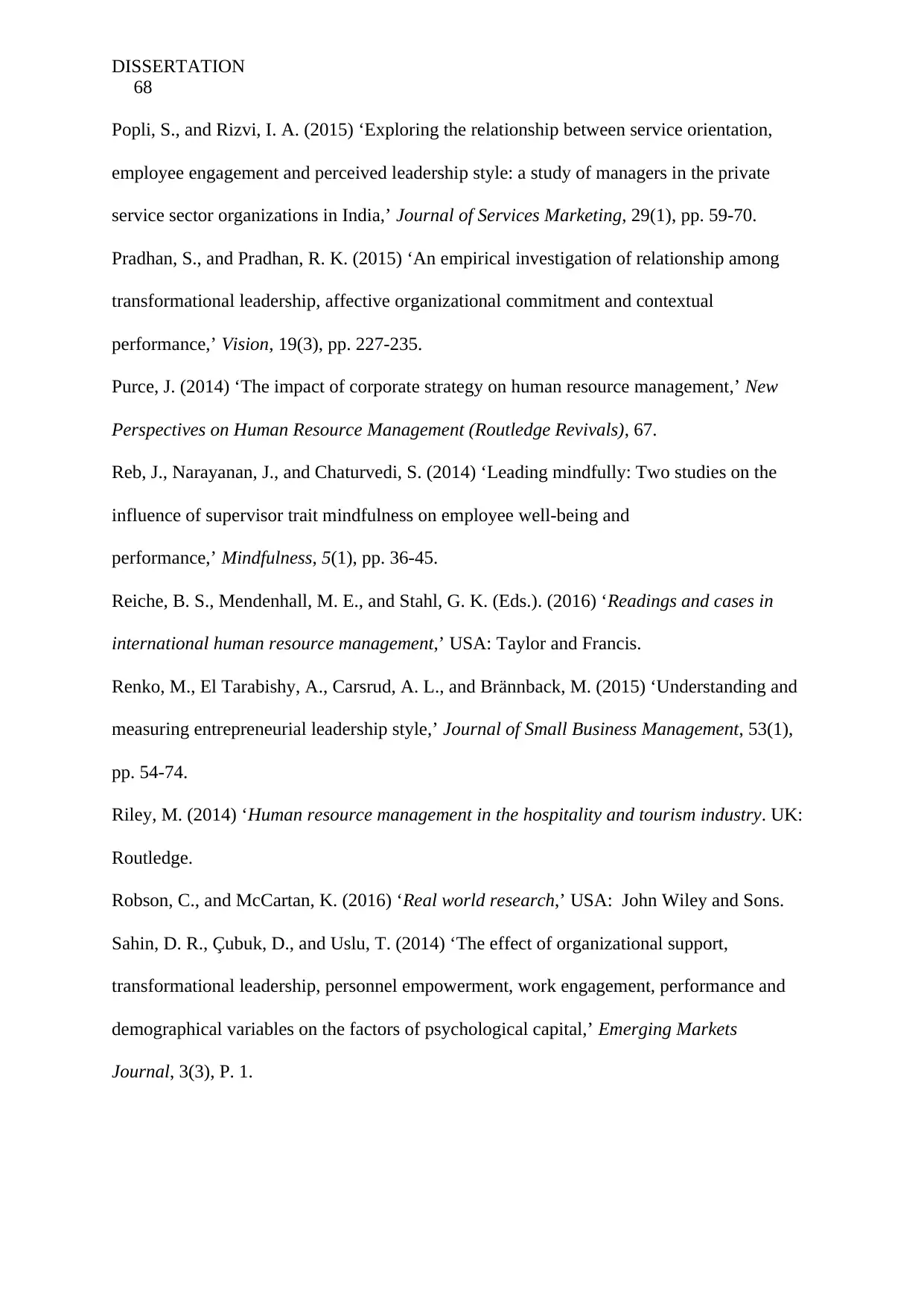
DISSERTATION
68
Popli, S., and Rizvi, I. A. (2015) ‘Exploring the relationship between service orientation,
employee engagement and perceived leadership style: a study of managers in the private
service sector organizations in India,’ Journal of Services Marketing, 29(1), pp. 59-70.
Pradhan, S., and Pradhan, R. K. (2015) ‘An empirical investigation of relationship among
transformational leadership, affective organizational commitment and contextual
performance,’ Vision, 19(3), pp. 227-235.
Purce, J. (2014) ‘The impact of corporate strategy on human resource management,’ New
Perspectives on Human Resource Management (Routledge Revivals), 67.
Reb, J., Narayanan, J., and Chaturvedi, S. (2014) ‘Leading mindfully: Two studies on the
influence of supervisor trait mindfulness on employee well-being and
performance,’ Mindfulness, 5(1), pp. 36-45.
Reiche, B. S., Mendenhall, M. E., and Stahl, G. K. (Eds.). (2016) ‘Readings and cases in
international human resource management,’ USA: Taylor and Francis.
Renko, M., El Tarabishy, A., Carsrud, A. L., and Brännback, M. (2015) ‘Understanding and
measuring entrepreneurial leadership style,’ Journal of Small Business Management, 53(1),
pp. 54-74.
Riley, M. (2014) ‘Human resource management in the hospitality and tourism industry. UK:
Routledge.
Robson, C., and McCartan, K. (2016) ‘Real world research,’ USA: John Wiley and Sons.
Sahin, D. R., Çubuk, D., and Uslu, T. (2014) ‘The effect of organizational support,
transformational leadership, personnel empowerment, work engagement, performance and
demographical variables on the factors of psychological capital,’ Emerging Markets
Journal, 3(3), P. 1.
68
Popli, S., and Rizvi, I. A. (2015) ‘Exploring the relationship between service orientation,
employee engagement and perceived leadership style: a study of managers in the private
service sector organizations in India,’ Journal of Services Marketing, 29(1), pp. 59-70.
Pradhan, S., and Pradhan, R. K. (2015) ‘An empirical investigation of relationship among
transformational leadership, affective organizational commitment and contextual
performance,’ Vision, 19(3), pp. 227-235.
Purce, J. (2014) ‘The impact of corporate strategy on human resource management,’ New
Perspectives on Human Resource Management (Routledge Revivals), 67.
Reb, J., Narayanan, J., and Chaturvedi, S. (2014) ‘Leading mindfully: Two studies on the
influence of supervisor trait mindfulness on employee well-being and
performance,’ Mindfulness, 5(1), pp. 36-45.
Reiche, B. S., Mendenhall, M. E., and Stahl, G. K. (Eds.). (2016) ‘Readings and cases in
international human resource management,’ USA: Taylor and Francis.
Renko, M., El Tarabishy, A., Carsrud, A. L., and Brännback, M. (2015) ‘Understanding and
measuring entrepreneurial leadership style,’ Journal of Small Business Management, 53(1),
pp. 54-74.
Riley, M. (2014) ‘Human resource management in the hospitality and tourism industry. UK:
Routledge.
Robson, C., and McCartan, K. (2016) ‘Real world research,’ USA: John Wiley and Sons.
Sahin, D. R., Çubuk, D., and Uslu, T. (2014) ‘The effect of organizational support,
transformational leadership, personnel empowerment, work engagement, performance and
demographical variables on the factors of psychological capital,’ Emerging Markets
Journal, 3(3), P. 1.
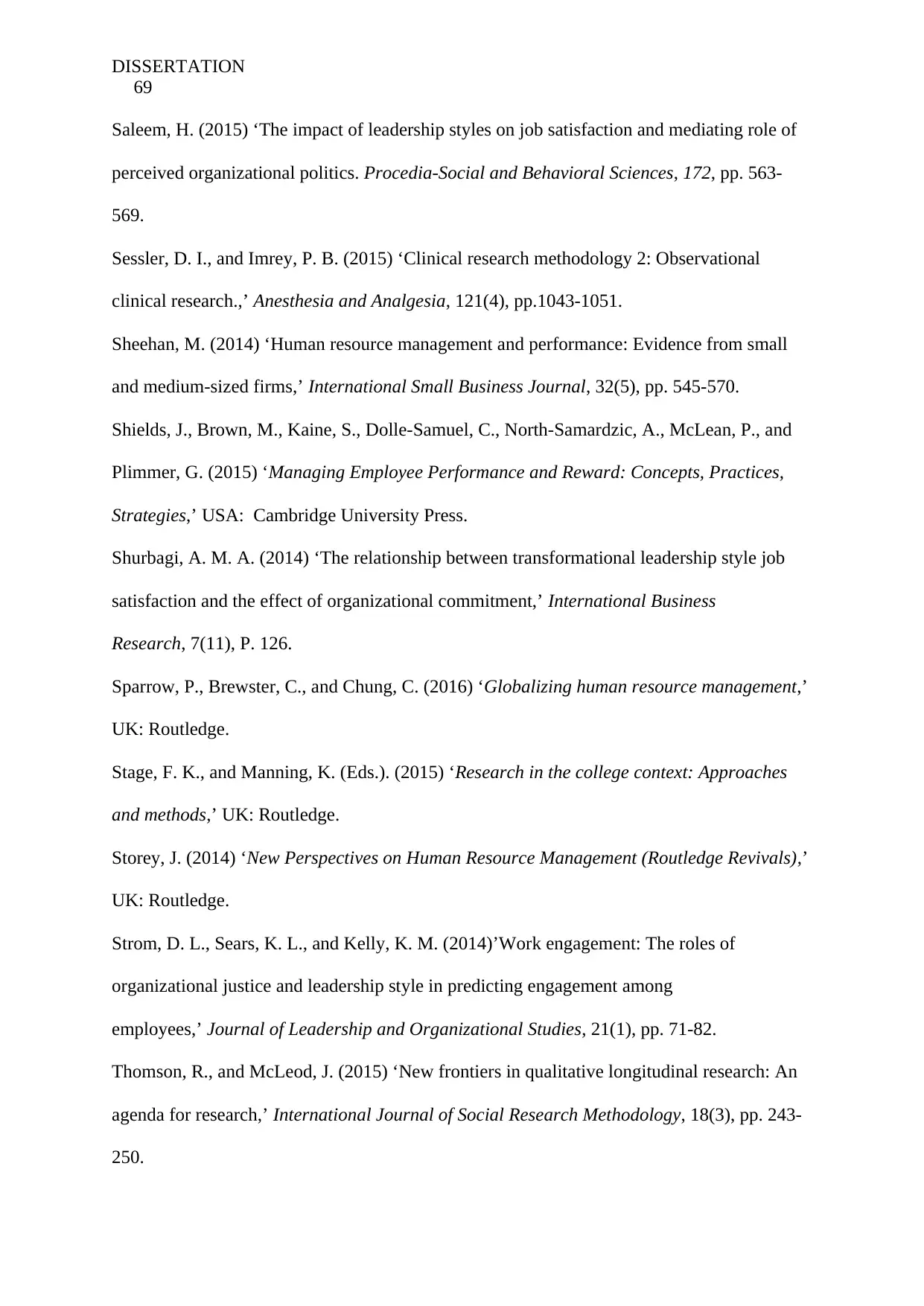
DISSERTATION
69
Saleem, H. (2015) ‘The impact of leadership styles on job satisfaction and mediating role of
perceived organizational politics. Procedia-Social and Behavioral Sciences, 172, pp. 563-
569.
Sessler, D. I., and Imrey, P. B. (2015) ‘Clinical research methodology 2: Observational
clinical research.,’ Anesthesia and Analgesia, 121(4), pp.1043-1051.
Sheehan, M. (2014) ‘Human resource management and performance: Evidence from small
and medium-sized firms,’ International Small Business Journal, 32(5), pp. 545-570.
Shields, J., Brown, M., Kaine, S., Dolle-Samuel, C., North-Samardzic, A., McLean, P., and
Plimmer, G. (2015) ‘Managing Employee Performance and Reward: Concepts, Practices,
Strategies,’ USA: Cambridge University Press.
Shurbagi, A. M. A. (2014) ‘The relationship between transformational leadership style job
satisfaction and the effect of organizational commitment,’ International Business
Research, 7(11), P. 126.
Sparrow, P., Brewster, C., and Chung, C. (2016) ‘Globalizing human resource management,’
UK: Routledge.
Stage, F. K., and Manning, K. (Eds.). (2015) ‘Research in the college context: Approaches
and methods,’ UK: Routledge.
Storey, J. (2014) ‘New Perspectives on Human Resource Management (Routledge Revivals),’
UK: Routledge.
Strom, D. L., Sears, K. L., and Kelly, K. M. (2014)’Work engagement: The roles of
organizational justice and leadership style in predicting engagement among
employees,’ Journal of Leadership and Organizational Studies, 21(1), pp. 71-82.
Thomson, R., and McLeod, J. (2015) ‘New frontiers in qualitative longitudinal research: An
agenda for research,’ International Journal of Social Research Methodology, 18(3), pp. 243-
250.
69
Saleem, H. (2015) ‘The impact of leadership styles on job satisfaction and mediating role of
perceived organizational politics. Procedia-Social and Behavioral Sciences, 172, pp. 563-
569.
Sessler, D. I., and Imrey, P. B. (2015) ‘Clinical research methodology 2: Observational
clinical research.,’ Anesthesia and Analgesia, 121(4), pp.1043-1051.
Sheehan, M. (2014) ‘Human resource management and performance: Evidence from small
and medium-sized firms,’ International Small Business Journal, 32(5), pp. 545-570.
Shields, J., Brown, M., Kaine, S., Dolle-Samuel, C., North-Samardzic, A., McLean, P., and
Plimmer, G. (2015) ‘Managing Employee Performance and Reward: Concepts, Practices,
Strategies,’ USA: Cambridge University Press.
Shurbagi, A. M. A. (2014) ‘The relationship between transformational leadership style job
satisfaction and the effect of organizational commitment,’ International Business
Research, 7(11), P. 126.
Sparrow, P., Brewster, C., and Chung, C. (2016) ‘Globalizing human resource management,’
UK: Routledge.
Stage, F. K., and Manning, K. (Eds.). (2015) ‘Research in the college context: Approaches
and methods,’ UK: Routledge.
Storey, J. (2014) ‘New Perspectives on Human Resource Management (Routledge Revivals),’
UK: Routledge.
Strom, D. L., Sears, K. L., and Kelly, K. M. (2014)’Work engagement: The roles of
organizational justice and leadership style in predicting engagement among
employees,’ Journal of Leadership and Organizational Studies, 21(1), pp. 71-82.
Thomson, R., and McLeod, J. (2015) ‘New frontiers in qualitative longitudinal research: An
agenda for research,’ International Journal of Social Research Methodology, 18(3), pp. 243-
250.

DISSERTATION
70
Top, M., Akdere, M., and Tarcan, M. (2015) ‘Examining transformational leadership, job
satisfaction, organizational commitment and organizational trust in Turkish hospitals: public
servants versus private sector employees. The International Journal of Human Resource
Management, 26(9), pp. 1259-1282.
Tyson, S. (2014) ‘Essentials of human resource management,’ UK: Routledge.
Tyssen, A. K., Wald, A., and Heidenreich, S. (2014) ‘Leadership in the context of temporary
organizations: A study on the effects of transactional and transformational leadership on
followers’ commitment in projects,’ Journal of Leadership and Organizational
Studies, 21(4), pp.376-393.
Vermeeren, B., Kuipers, B., and Steijn, B. (2014) ‘Does leadership style make a difference?
Linking HRM, job satisfaction, and organizational performance,’ Review of Public Personnel
Administration, 34(2), pp. 174-195.
Vidyarthi, P. R., Anand, S., and Liden, R. C. (2014) ‘Do emotionally perceptive leaders
motivate higher employee performance? The moderating role of task interdependence and
power distance,’ The Leadership Quarterly, 25(2), pp. 232-244.
Wach, K. (2014) ‘Research Methodology of the Field Study on the Firm-Level
Internationalisation in Visegrad Countries (chapter 2),’ USA: Sage.
Duréndez, A., and Wach, K.(2014)’ Patterns of Business Internationalisation in Visegrad
Countries–In Search for Regional Specifics,’ Cartagena: Politencina Universitad de
Cartagena, pp. 33-42.
Wang, X., Ma, L., and Zhang, M. (2014) ‘Transformational leadership and agency workers'
organizational commitment: The mediating effect of organizational justice and job
characteristics,’ Social Behavior and Personality: an international journal, 42(1), pp. 25-36.
Wilton, N. (2016) ‘An introduction to human resource management,’ USA: Sage.
70
Top, M., Akdere, M., and Tarcan, M. (2015) ‘Examining transformational leadership, job
satisfaction, organizational commitment and organizational trust in Turkish hospitals: public
servants versus private sector employees. The International Journal of Human Resource
Management, 26(9), pp. 1259-1282.
Tyson, S. (2014) ‘Essentials of human resource management,’ UK: Routledge.
Tyssen, A. K., Wald, A., and Heidenreich, S. (2014) ‘Leadership in the context of temporary
organizations: A study on the effects of transactional and transformational leadership on
followers’ commitment in projects,’ Journal of Leadership and Organizational
Studies, 21(4), pp.376-393.
Vermeeren, B., Kuipers, B., and Steijn, B. (2014) ‘Does leadership style make a difference?
Linking HRM, job satisfaction, and organizational performance,’ Review of Public Personnel
Administration, 34(2), pp. 174-195.
Vidyarthi, P. R., Anand, S., and Liden, R. C. (2014) ‘Do emotionally perceptive leaders
motivate higher employee performance? The moderating role of task interdependence and
power distance,’ The Leadership Quarterly, 25(2), pp. 232-244.
Wach, K. (2014) ‘Research Methodology of the Field Study on the Firm-Level
Internationalisation in Visegrad Countries (chapter 2),’ USA: Sage.
Duréndez, A., and Wach, K.(2014)’ Patterns of Business Internationalisation in Visegrad
Countries–In Search for Regional Specifics,’ Cartagena: Politencina Universitad de
Cartagena, pp. 33-42.
Wang, X., Ma, L., and Zhang, M. (2014) ‘Transformational leadership and agency workers'
organizational commitment: The mediating effect of organizational justice and job
characteristics,’ Social Behavior and Personality: an international journal, 42(1), pp. 25-36.
Wilton, N. (2016) ‘An introduction to human resource management,’ USA: Sage.
Secure Best Marks with AI Grader
Need help grading? Try our AI Grader for instant feedback on your assignments.
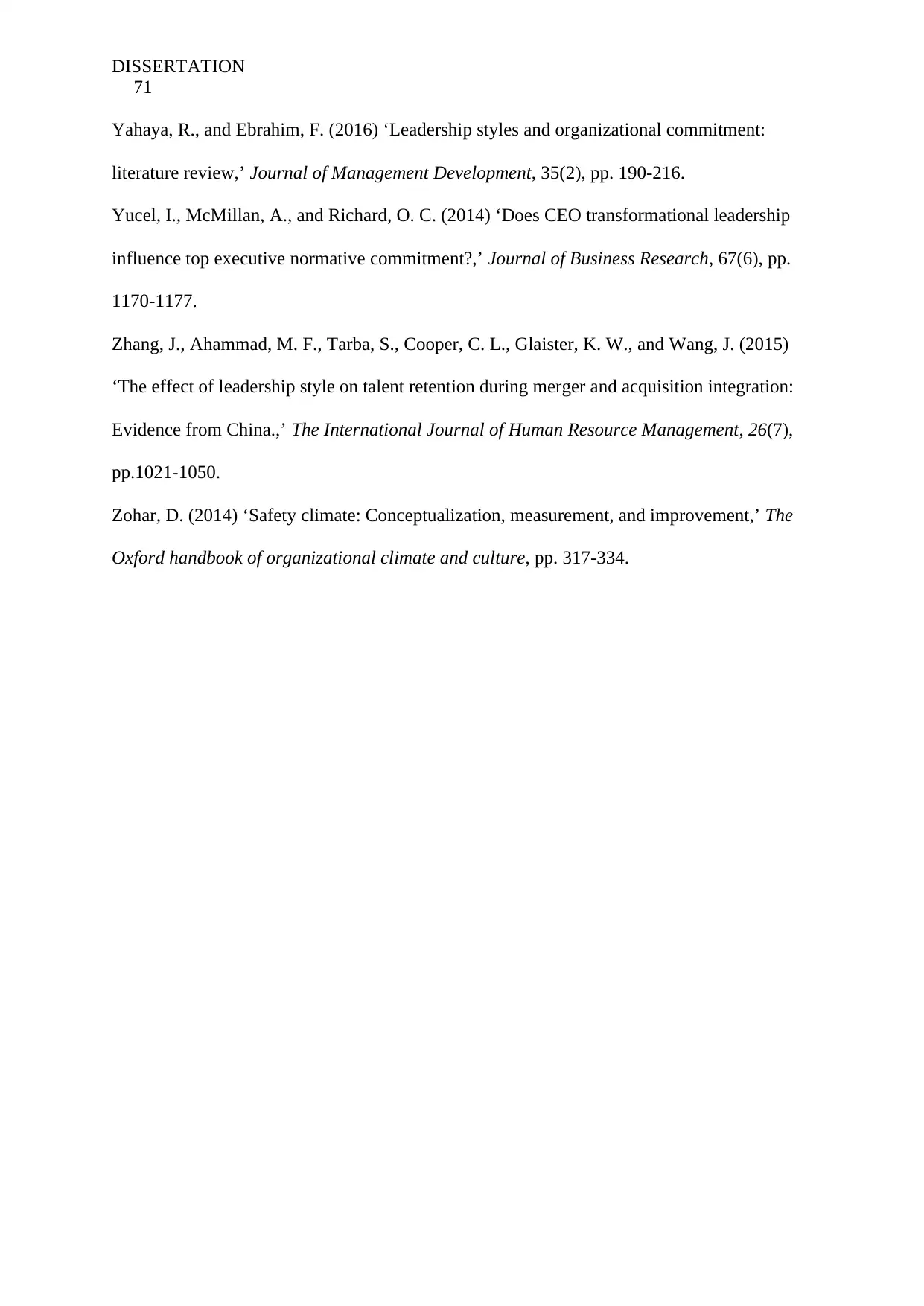
DISSERTATION
71
Yahaya, R., and Ebrahim, F. (2016) ‘Leadership styles and organizational commitment:
literature review,’ Journal of Management Development, 35(2), pp. 190-216.
Yucel, I., McMillan, A., and Richard, O. C. (2014) ‘Does CEO transformational leadership
influence top executive normative commitment?,’ Journal of Business Research, 67(6), pp.
1170-1177.
Zhang, J., Ahammad, M. F., Tarba, S., Cooper, C. L., Glaister, K. W., and Wang, J. (2015)
‘The effect of leadership style on talent retention during merger and acquisition integration:
Evidence from China.,’ The International Journal of Human Resource Management, 26(7),
pp.1021-1050.
Zohar, D. (2014) ‘Safety climate: Conceptualization, measurement, and improvement,’ The
Oxford handbook of organizational climate and culture, pp. 317-334.
71
Yahaya, R., and Ebrahim, F. (2016) ‘Leadership styles and organizational commitment:
literature review,’ Journal of Management Development, 35(2), pp. 190-216.
Yucel, I., McMillan, A., and Richard, O. C. (2014) ‘Does CEO transformational leadership
influence top executive normative commitment?,’ Journal of Business Research, 67(6), pp.
1170-1177.
Zhang, J., Ahammad, M. F., Tarba, S., Cooper, C. L., Glaister, K. W., and Wang, J. (2015)
‘The effect of leadership style on talent retention during merger and acquisition integration:
Evidence from China.,’ The International Journal of Human Resource Management, 26(7),
pp.1021-1050.
Zohar, D. (2014) ‘Safety climate: Conceptualization, measurement, and improvement,’ The
Oxford handbook of organizational climate and culture, pp. 317-334.
1 out of 71
Related Documents
Your All-in-One AI-Powered Toolkit for Academic Success.
+13062052269
info@desklib.com
Available 24*7 on WhatsApp / Email
![[object Object]](/_next/static/media/star-bottom.7253800d.svg)
Unlock your academic potential
© 2024 | Zucol Services PVT LTD | All rights reserved.





